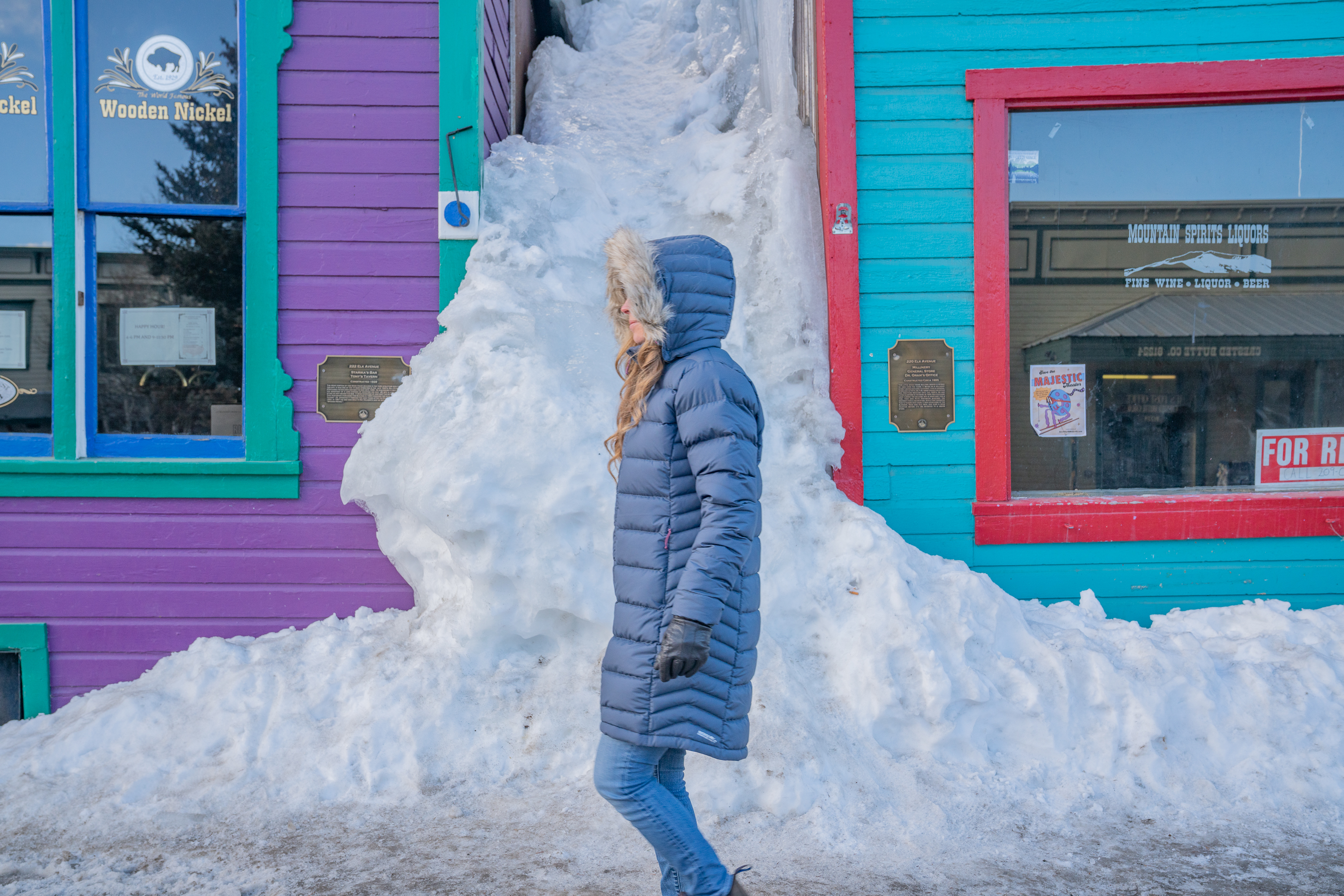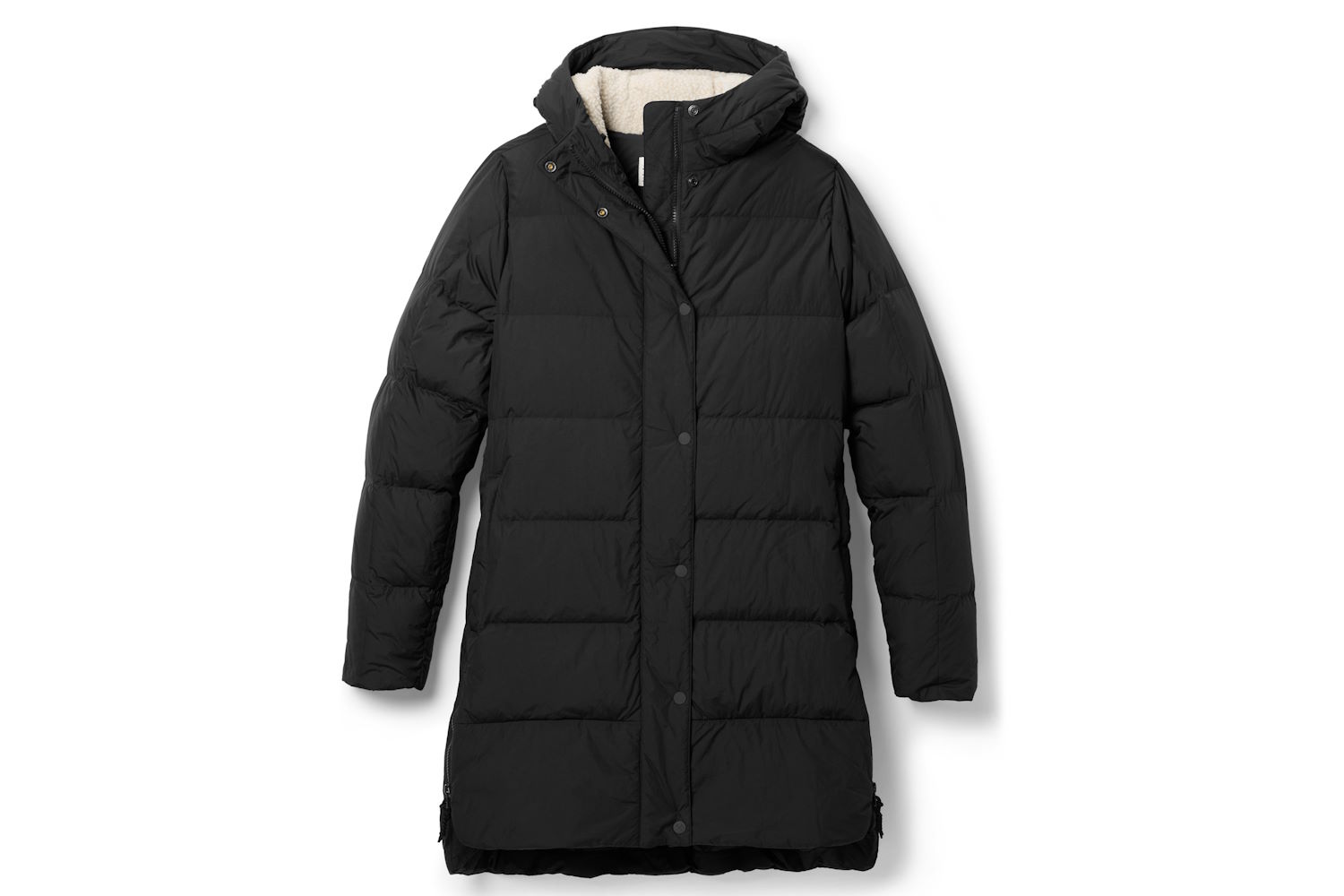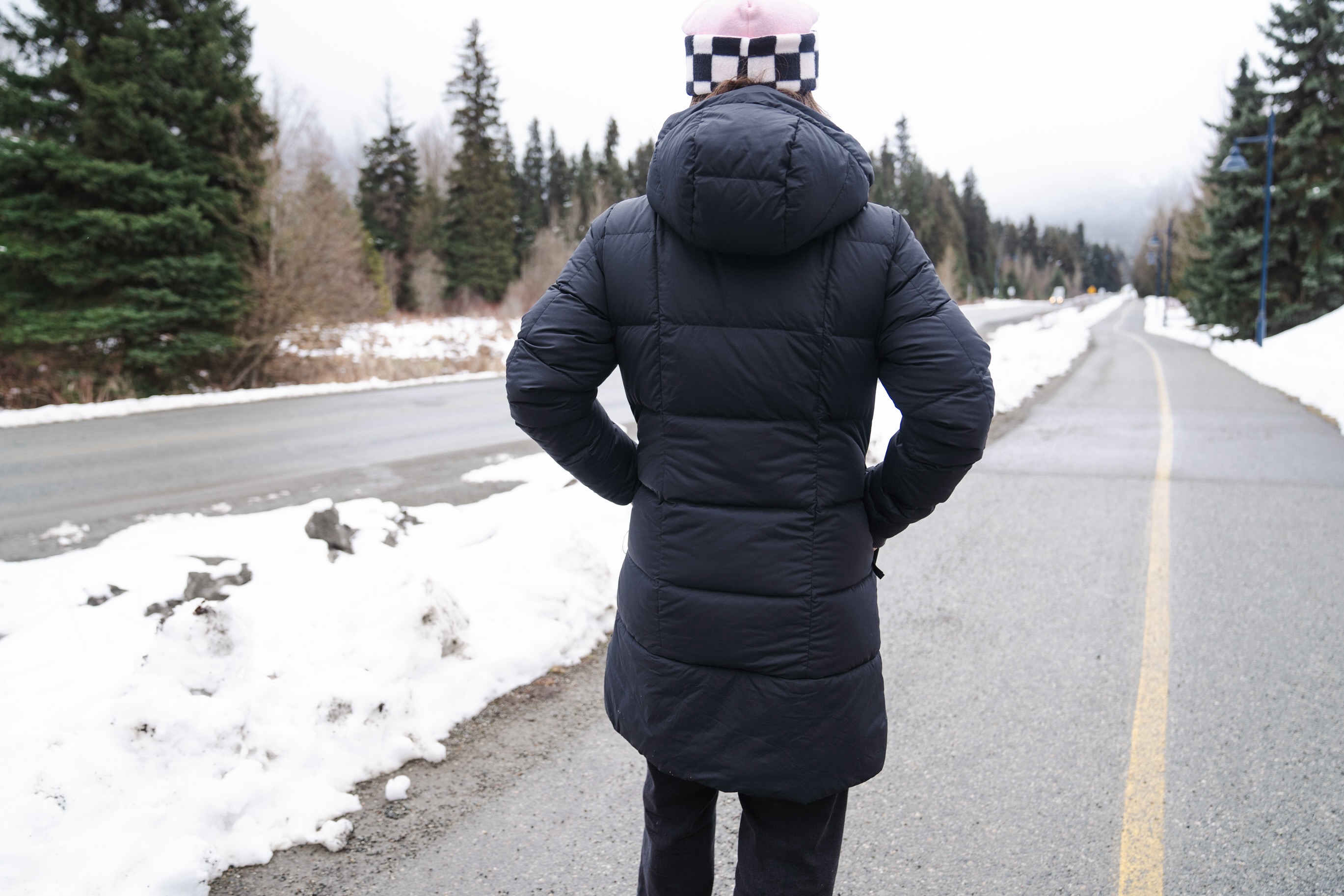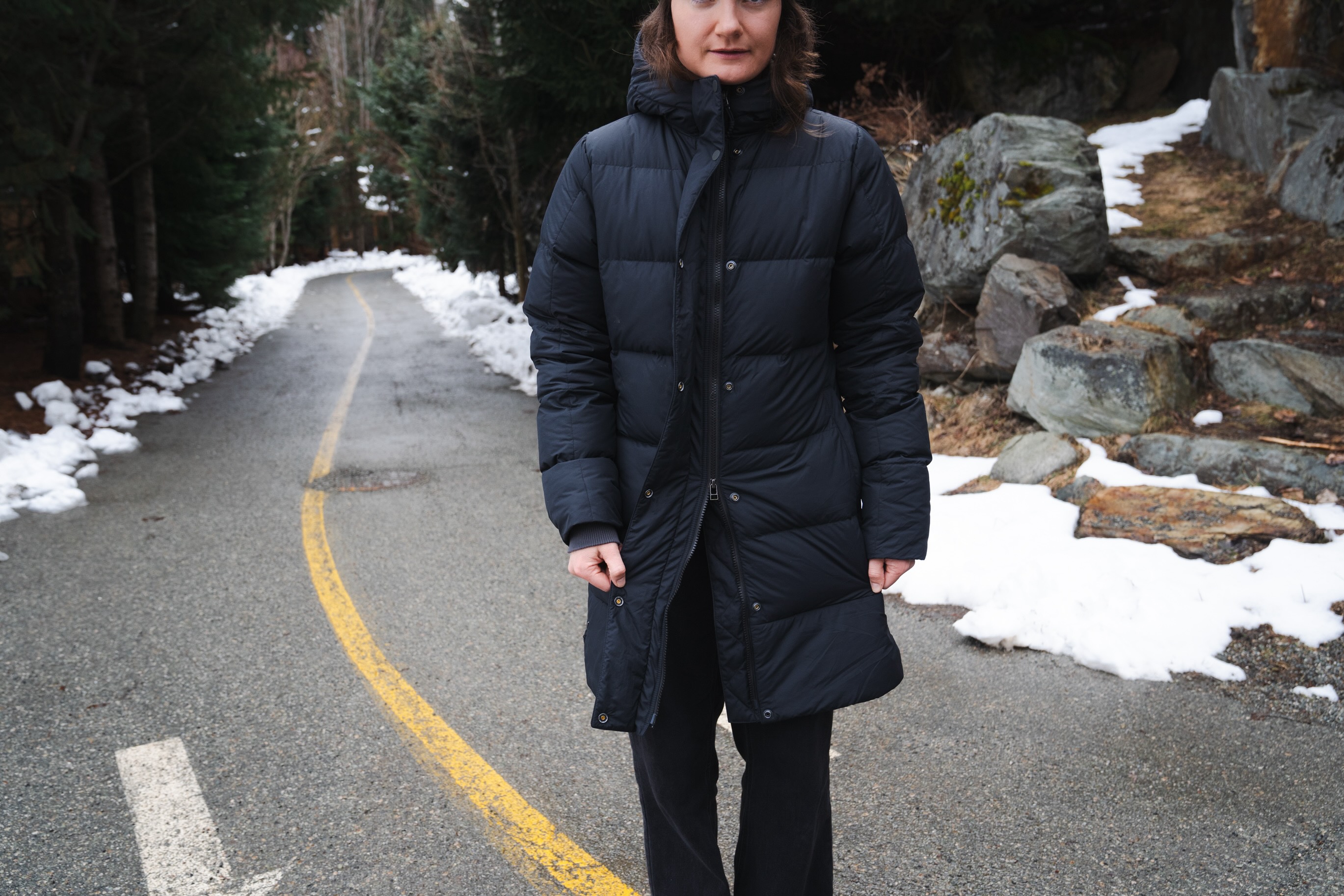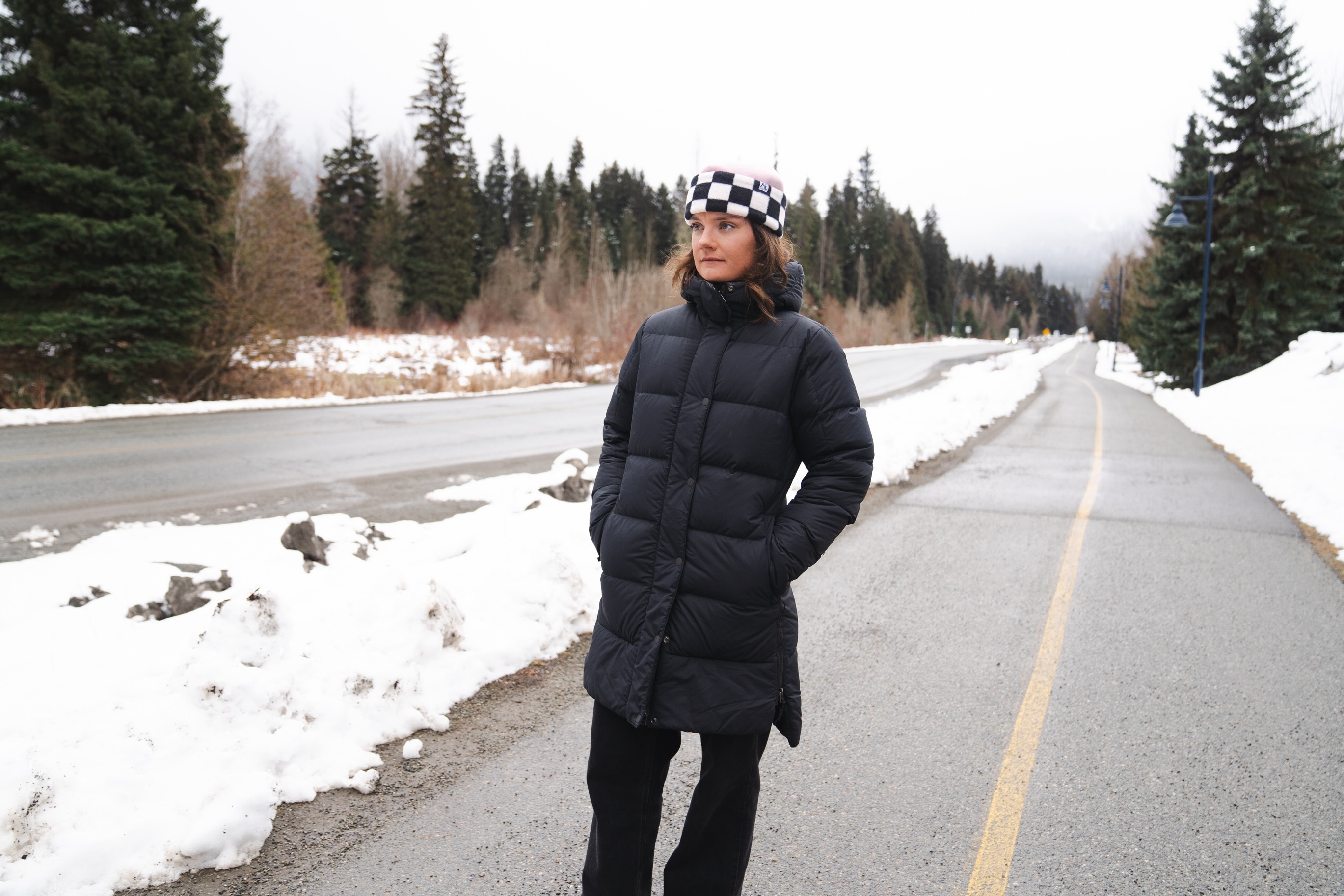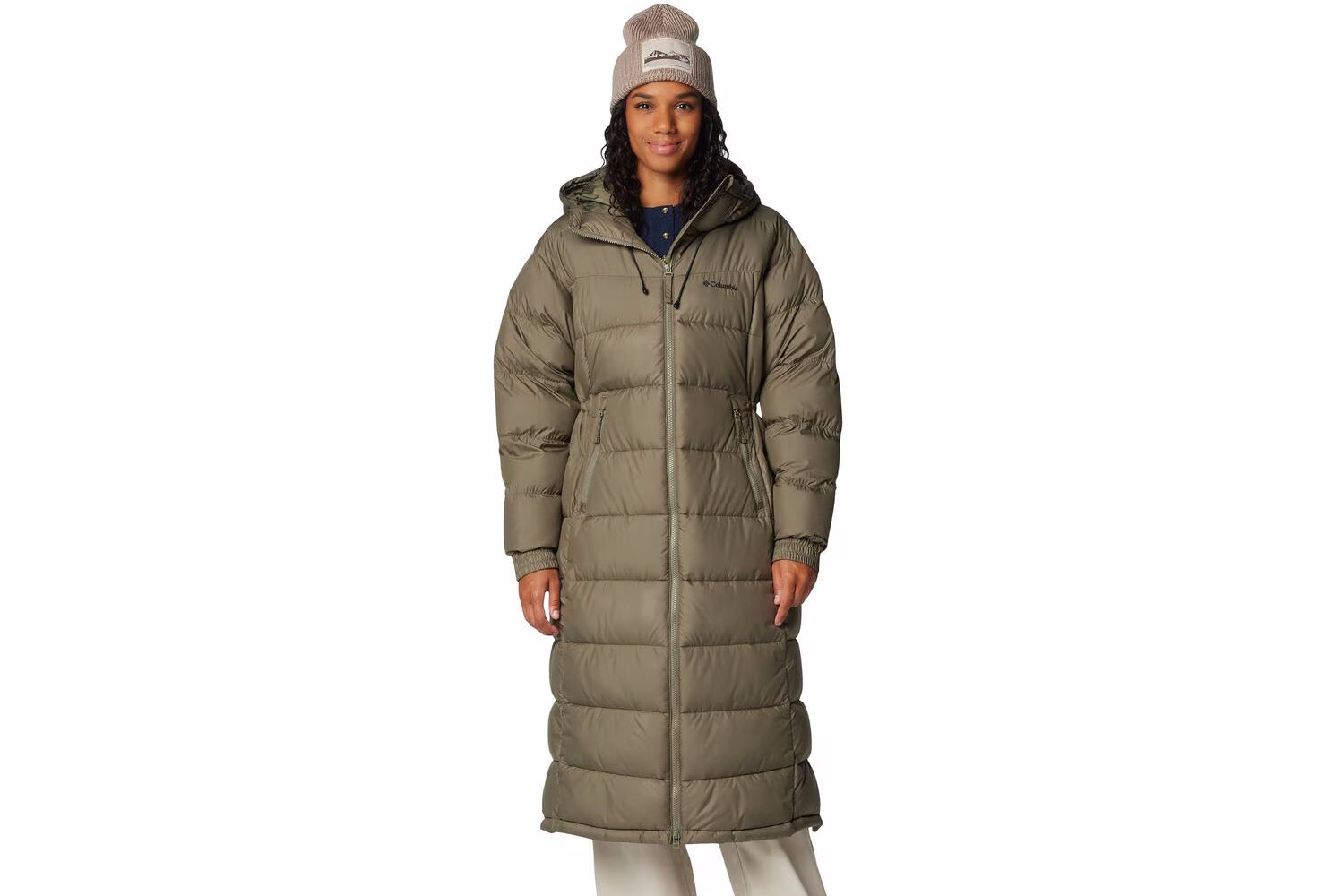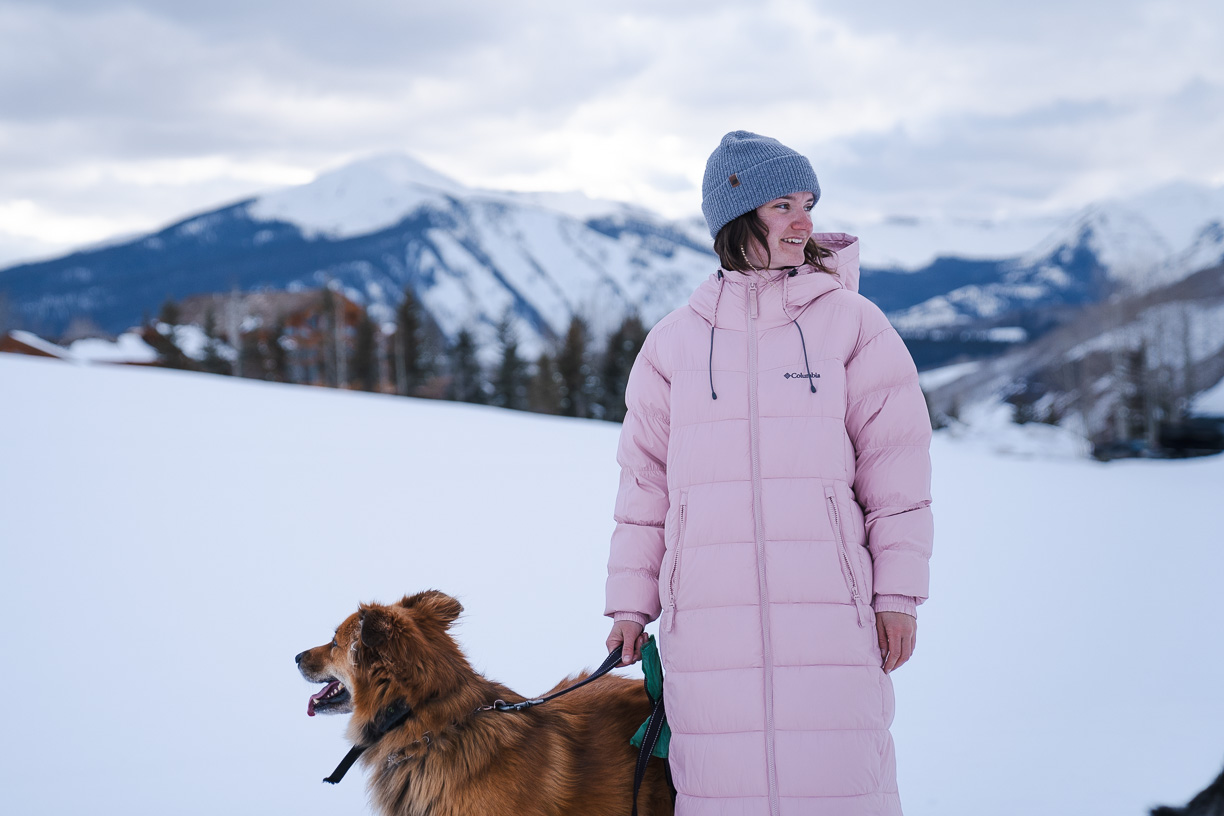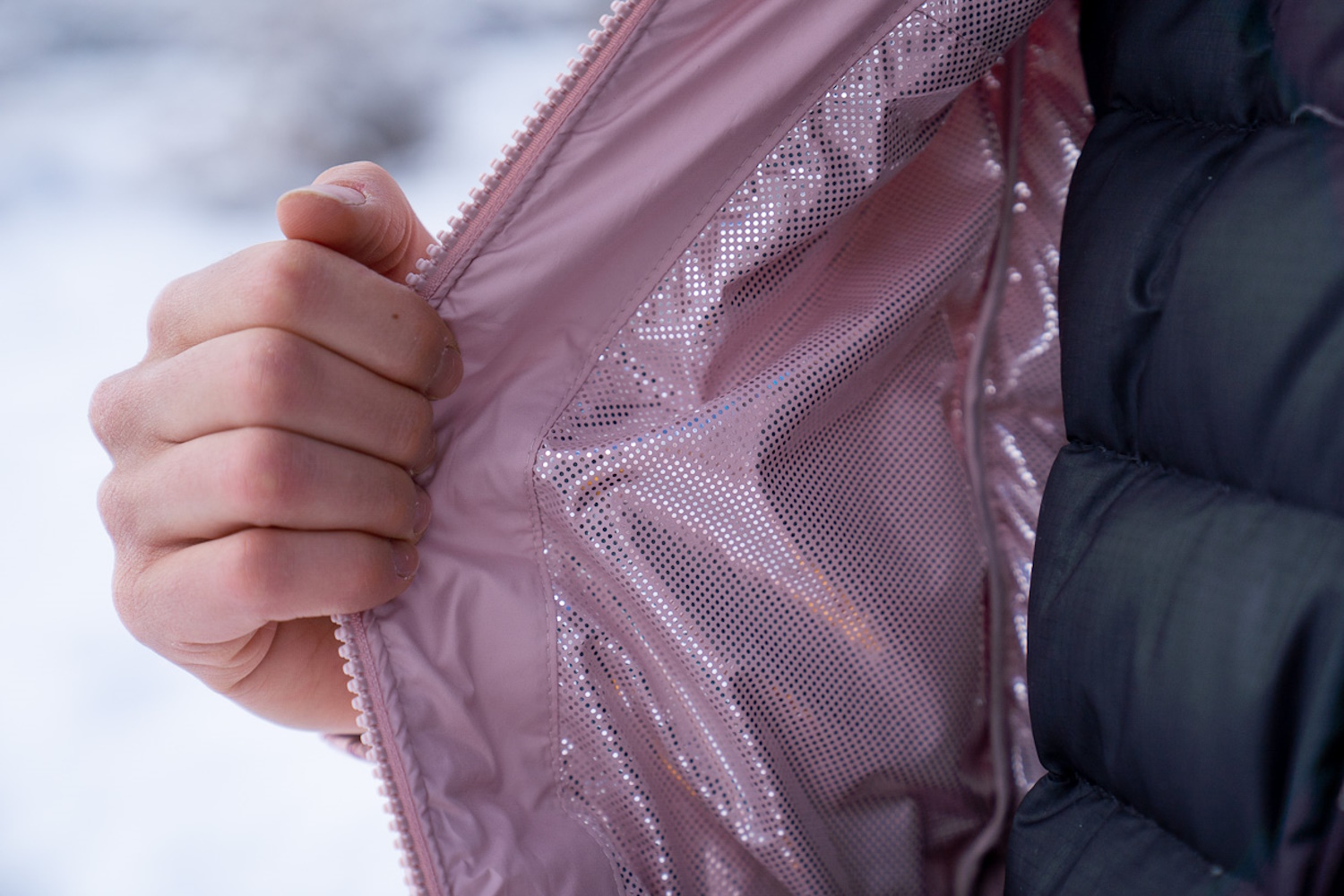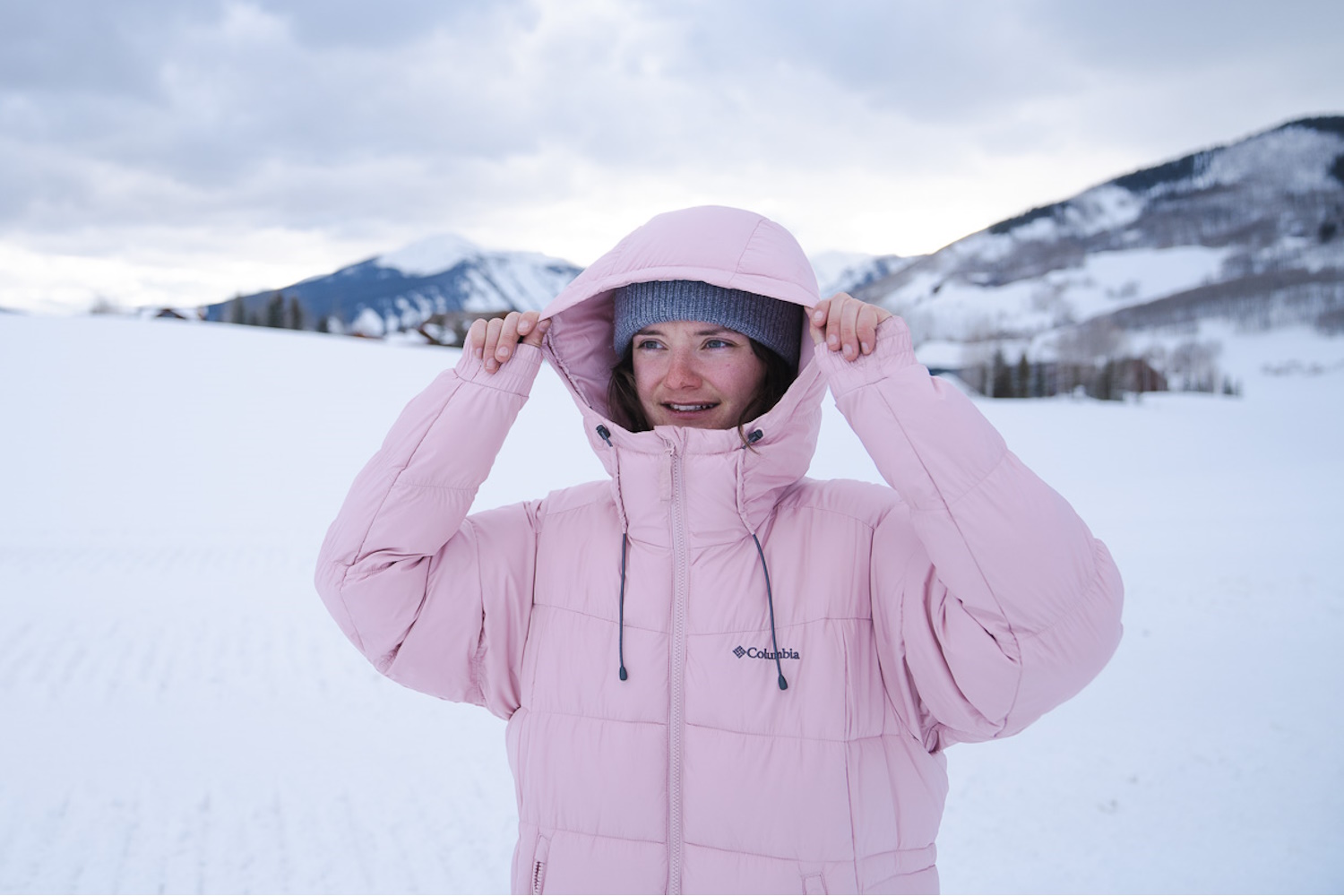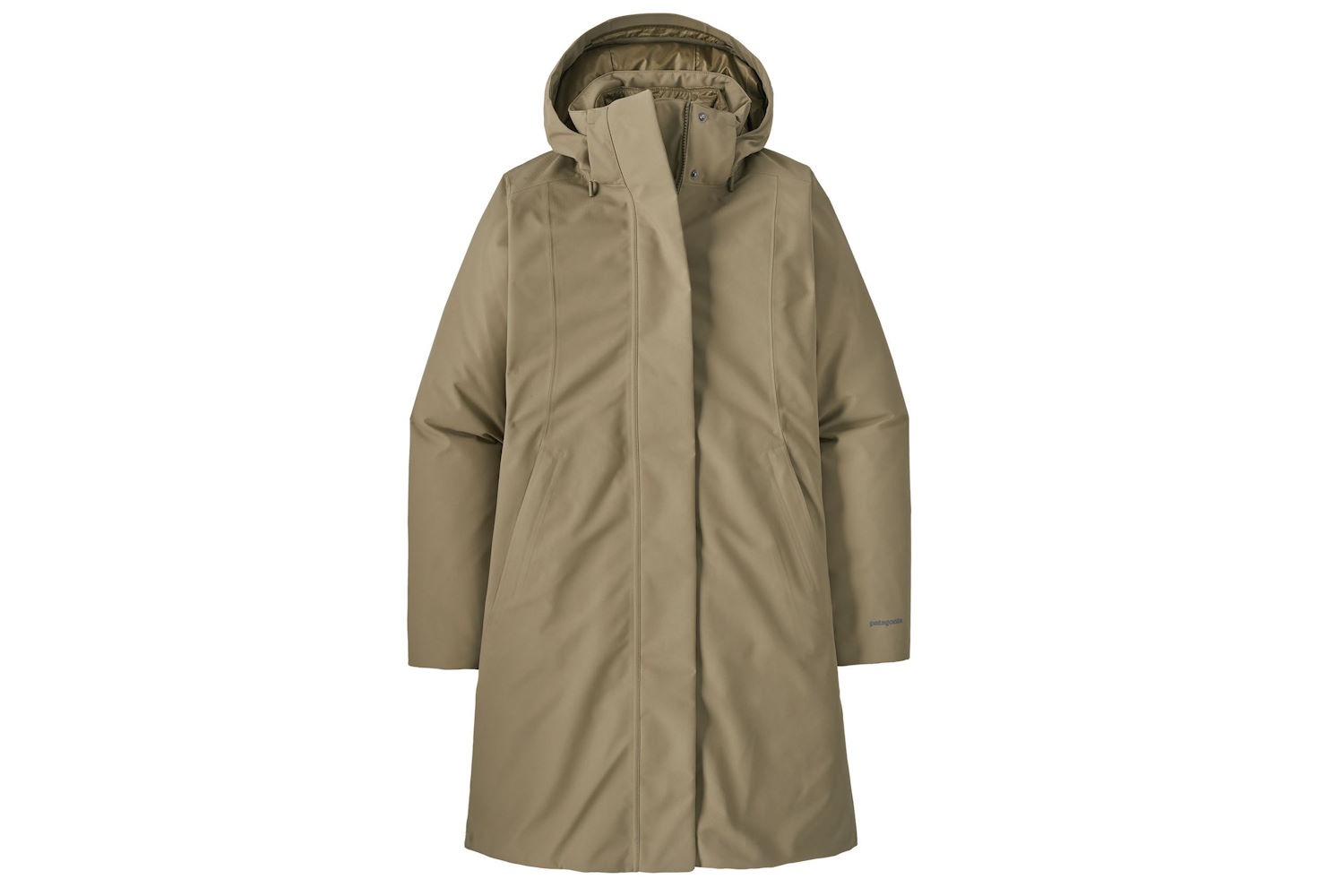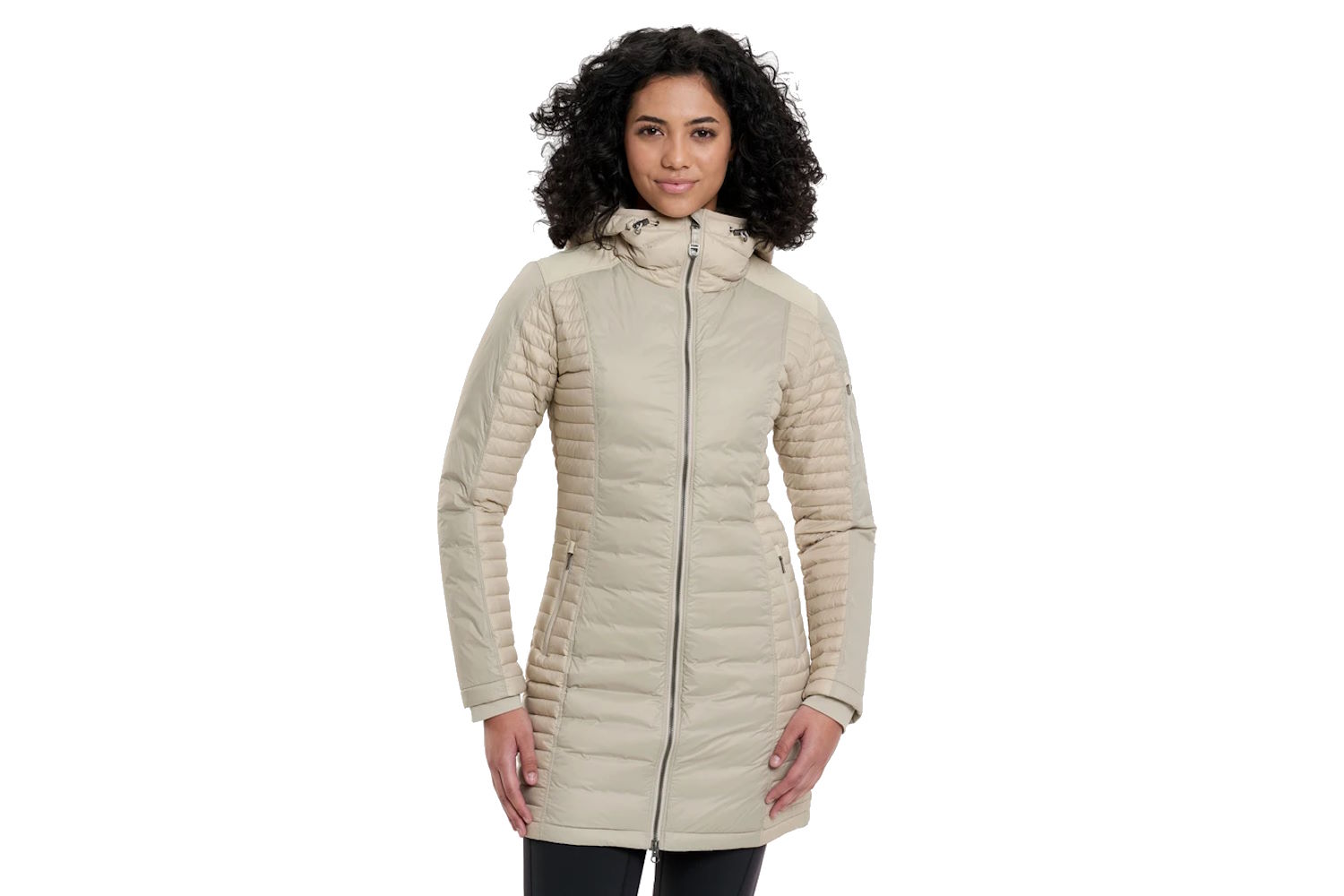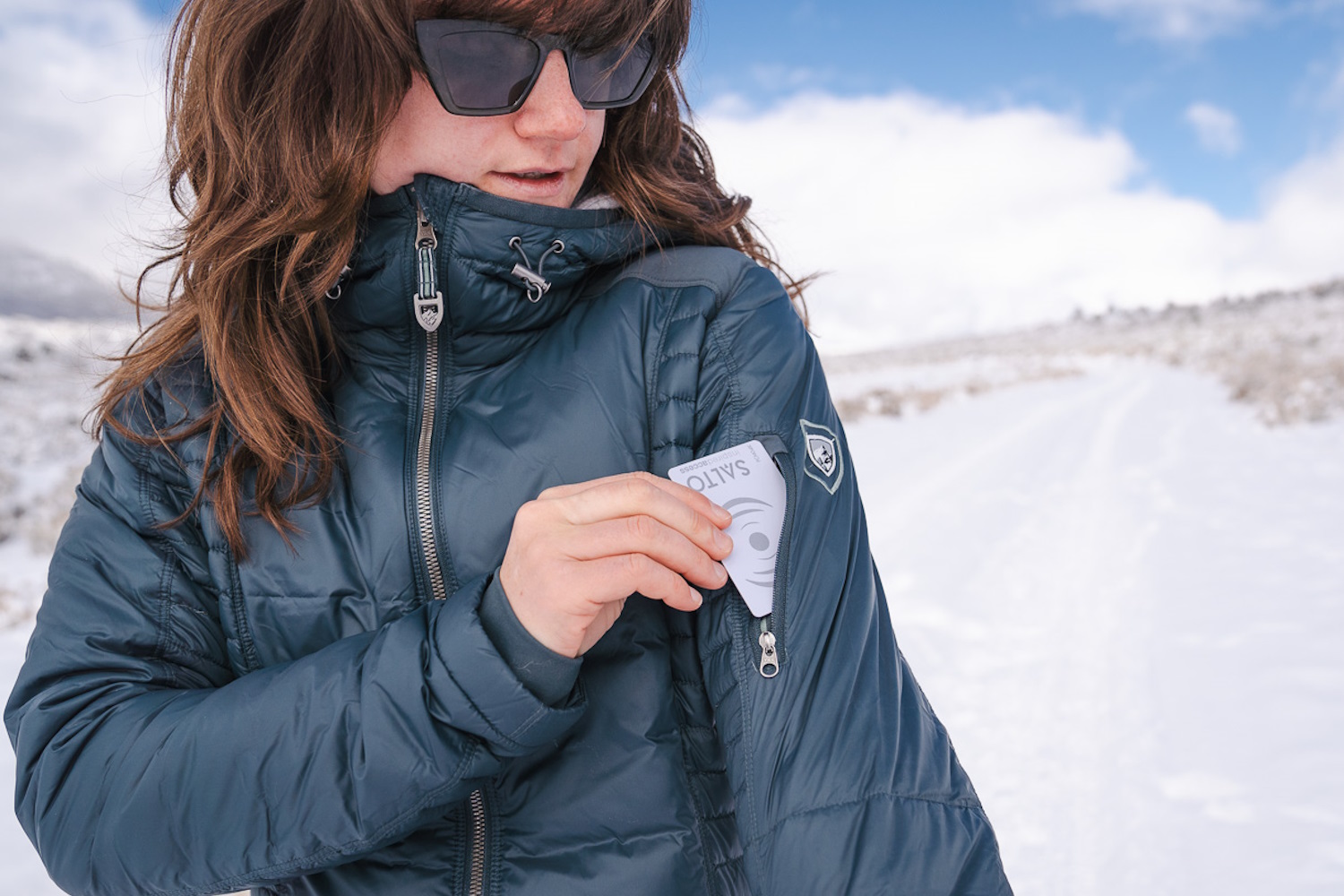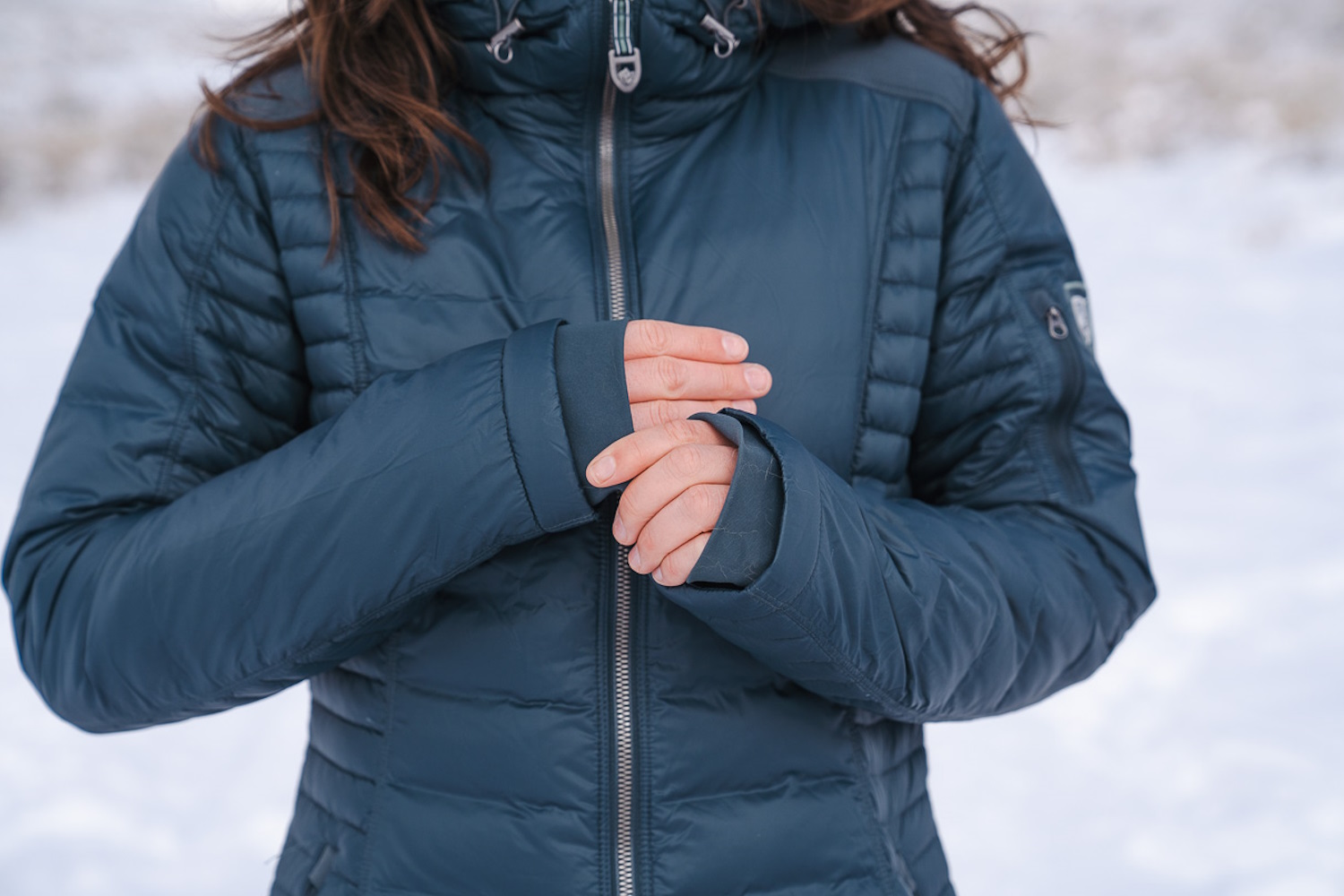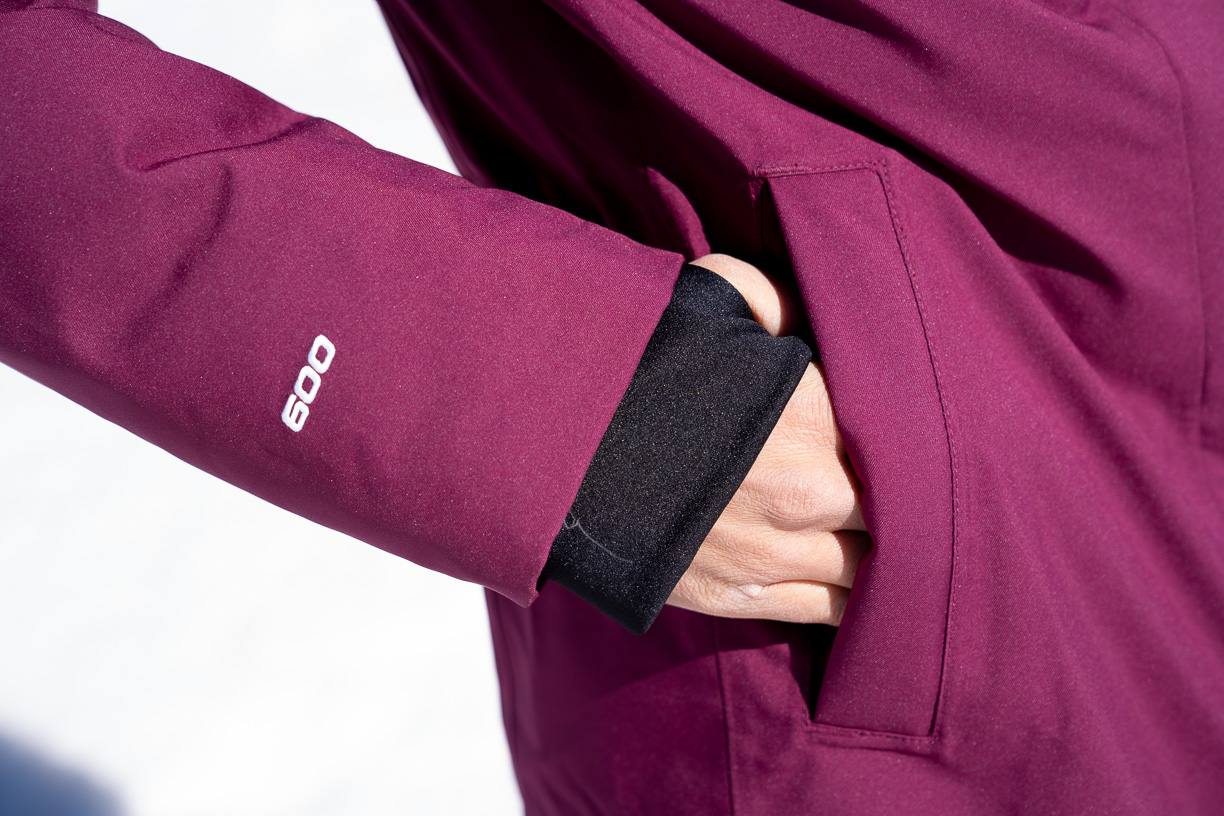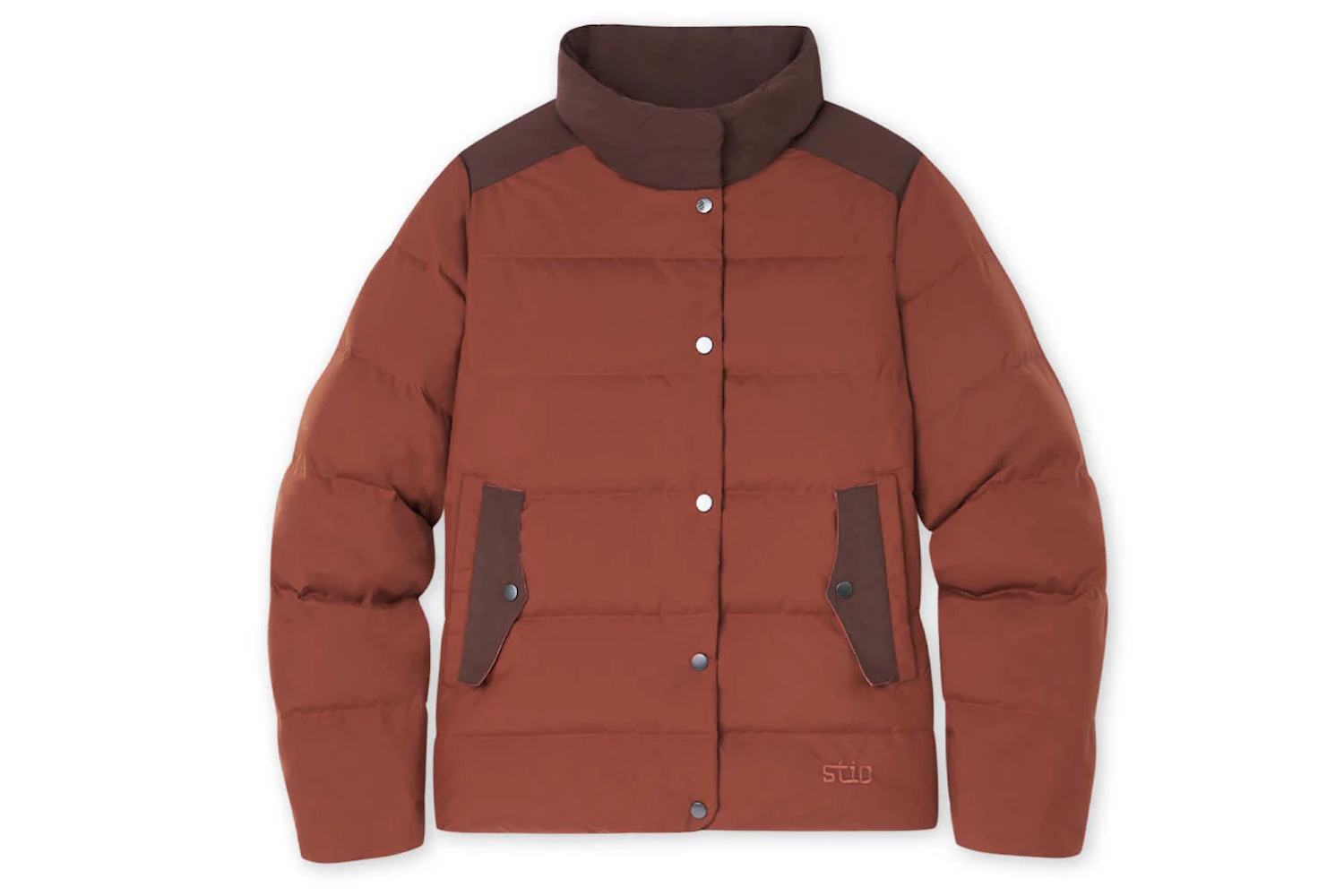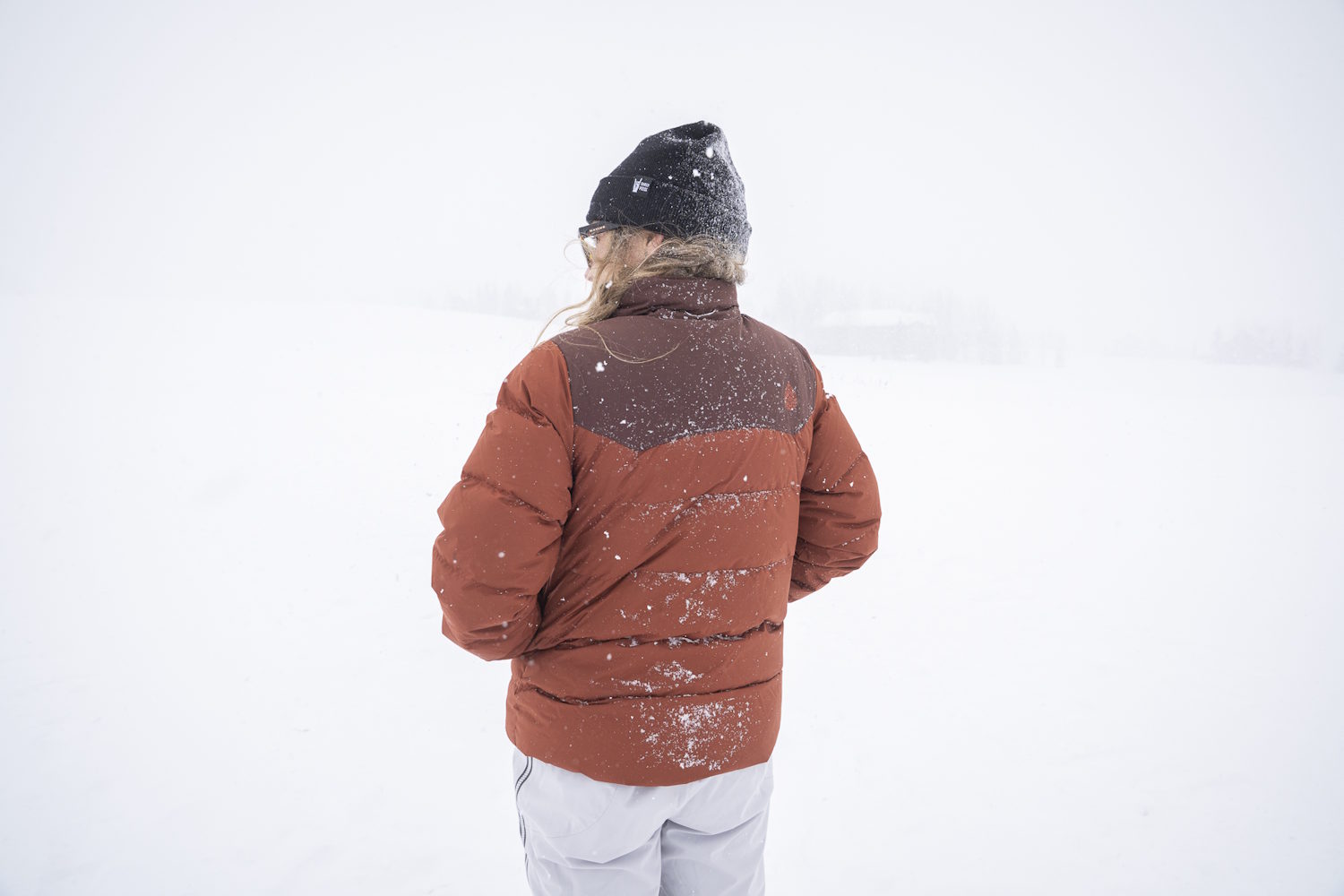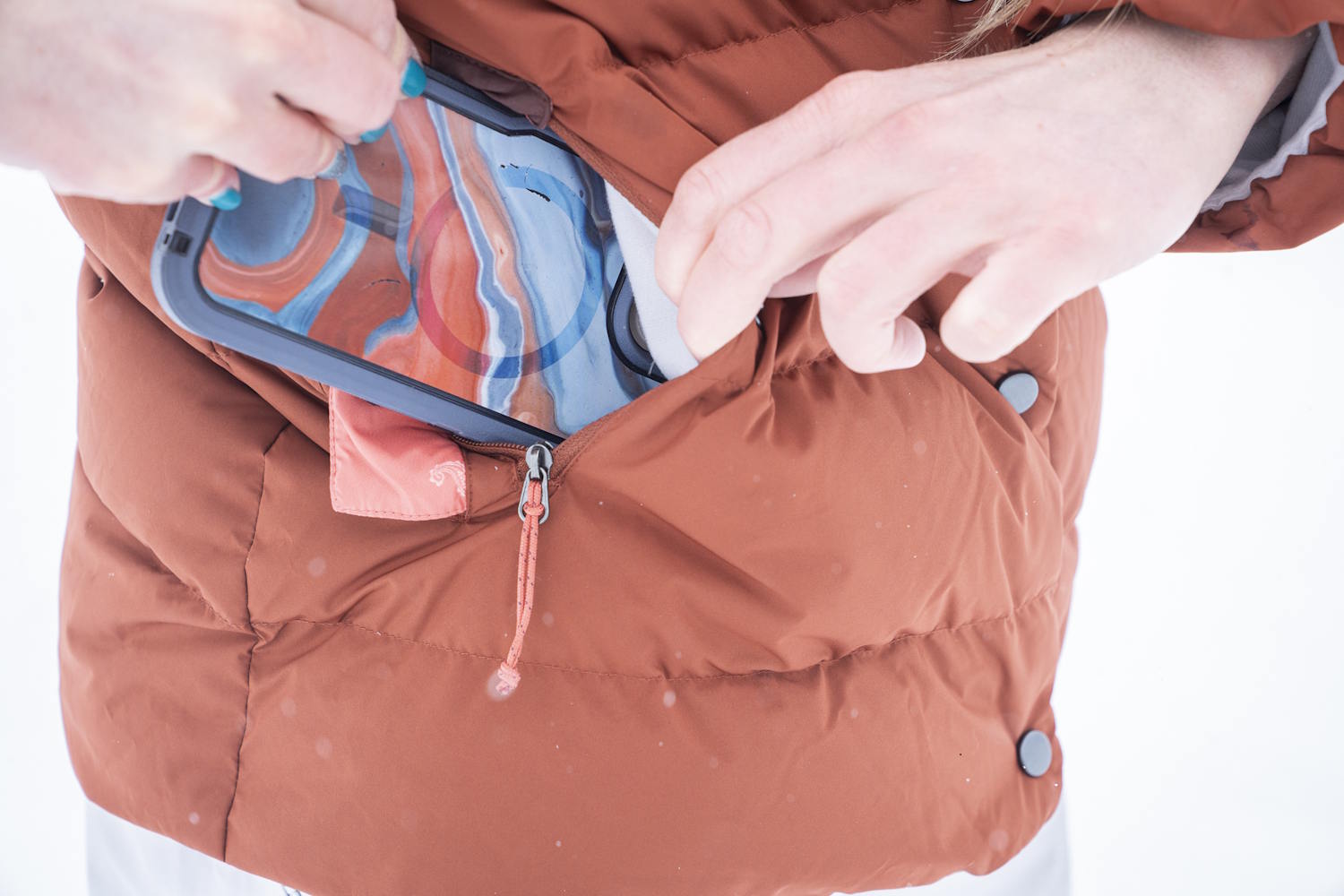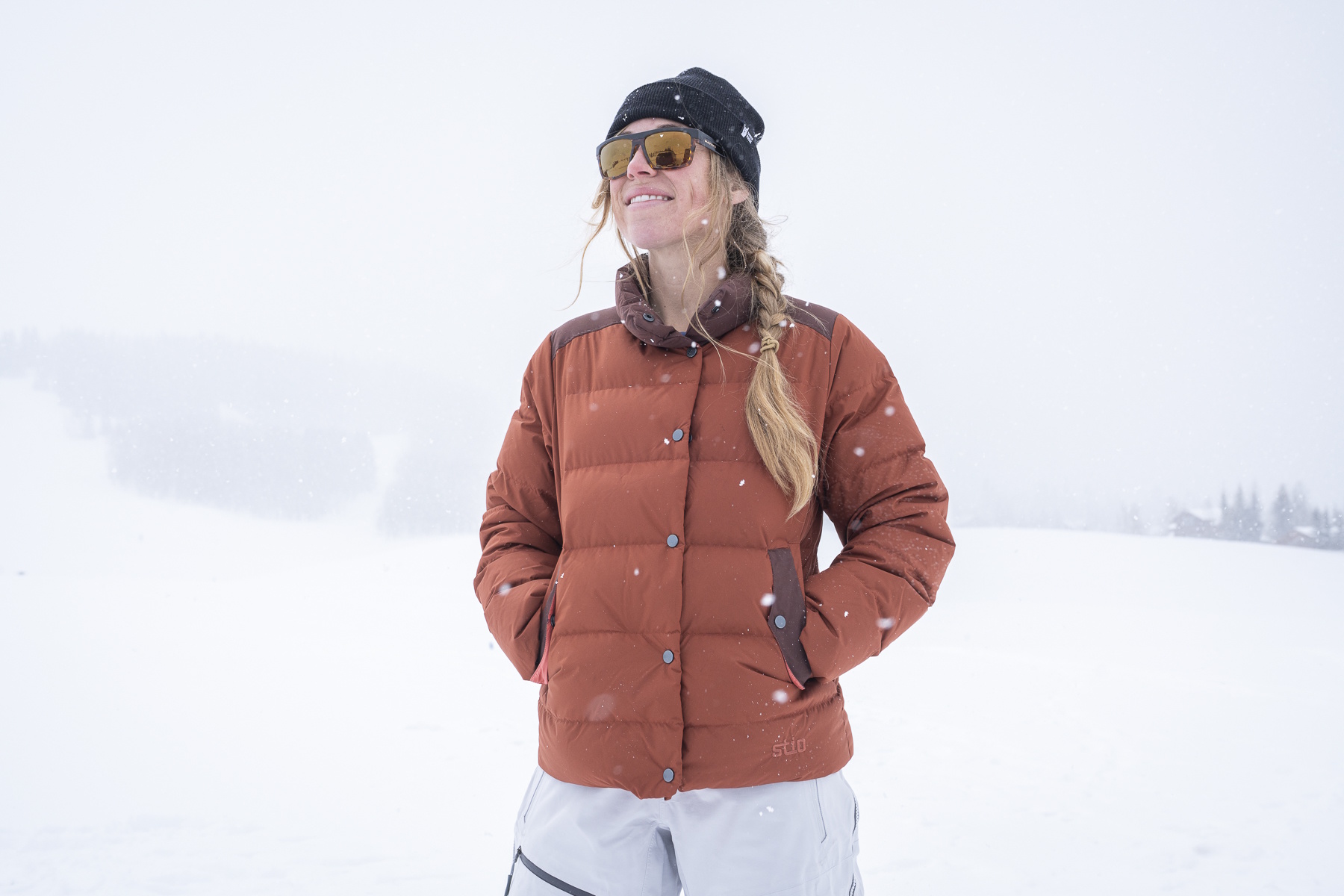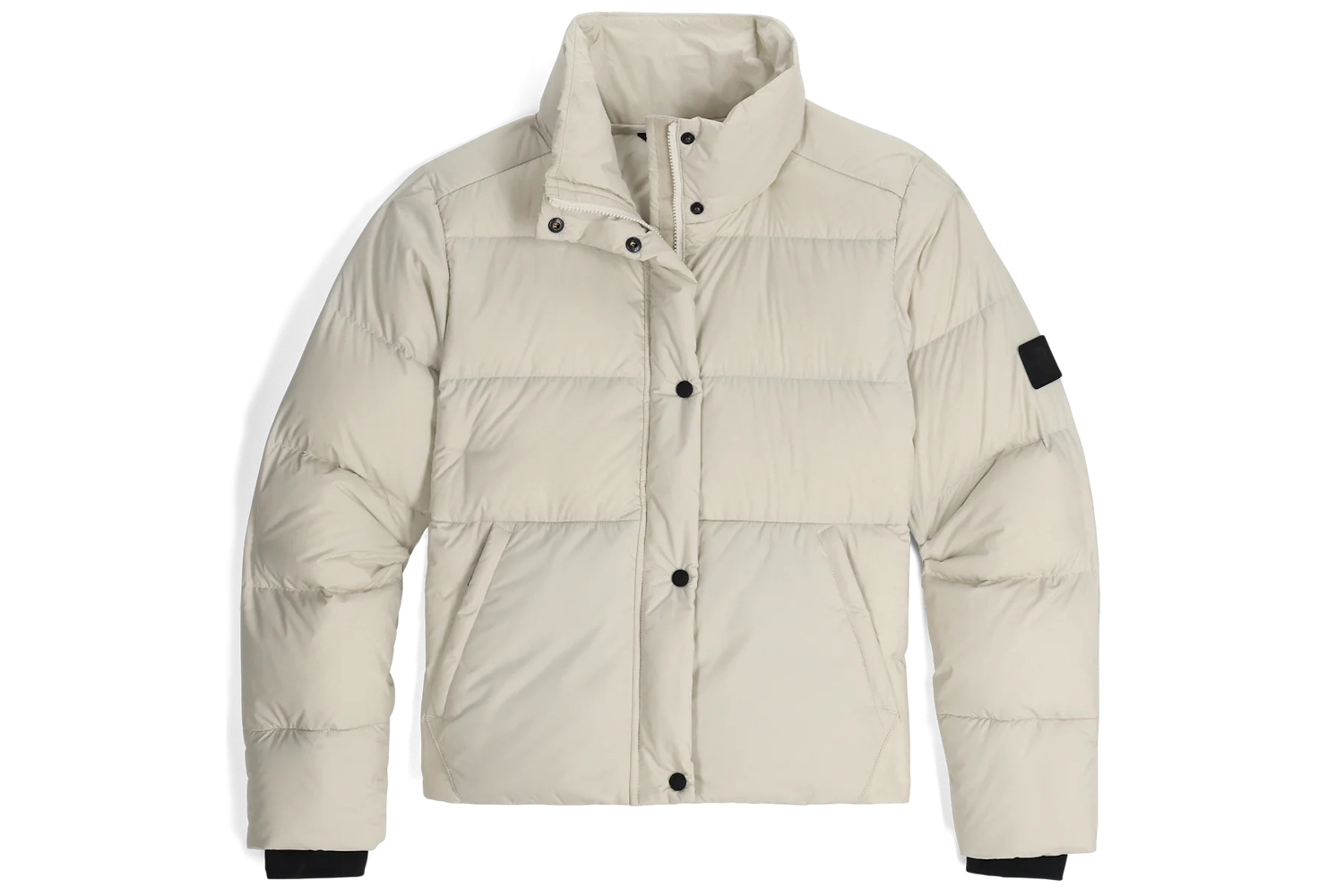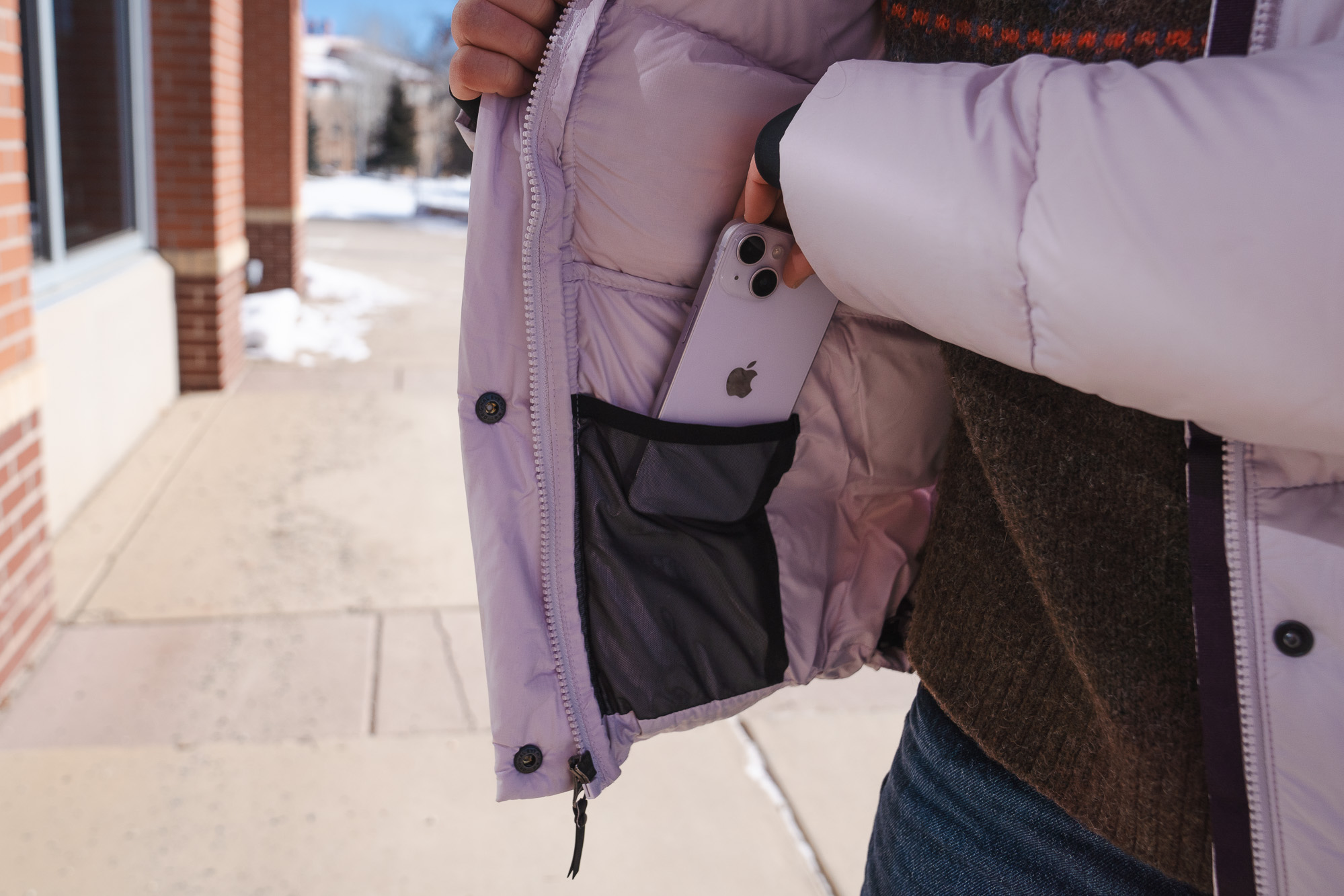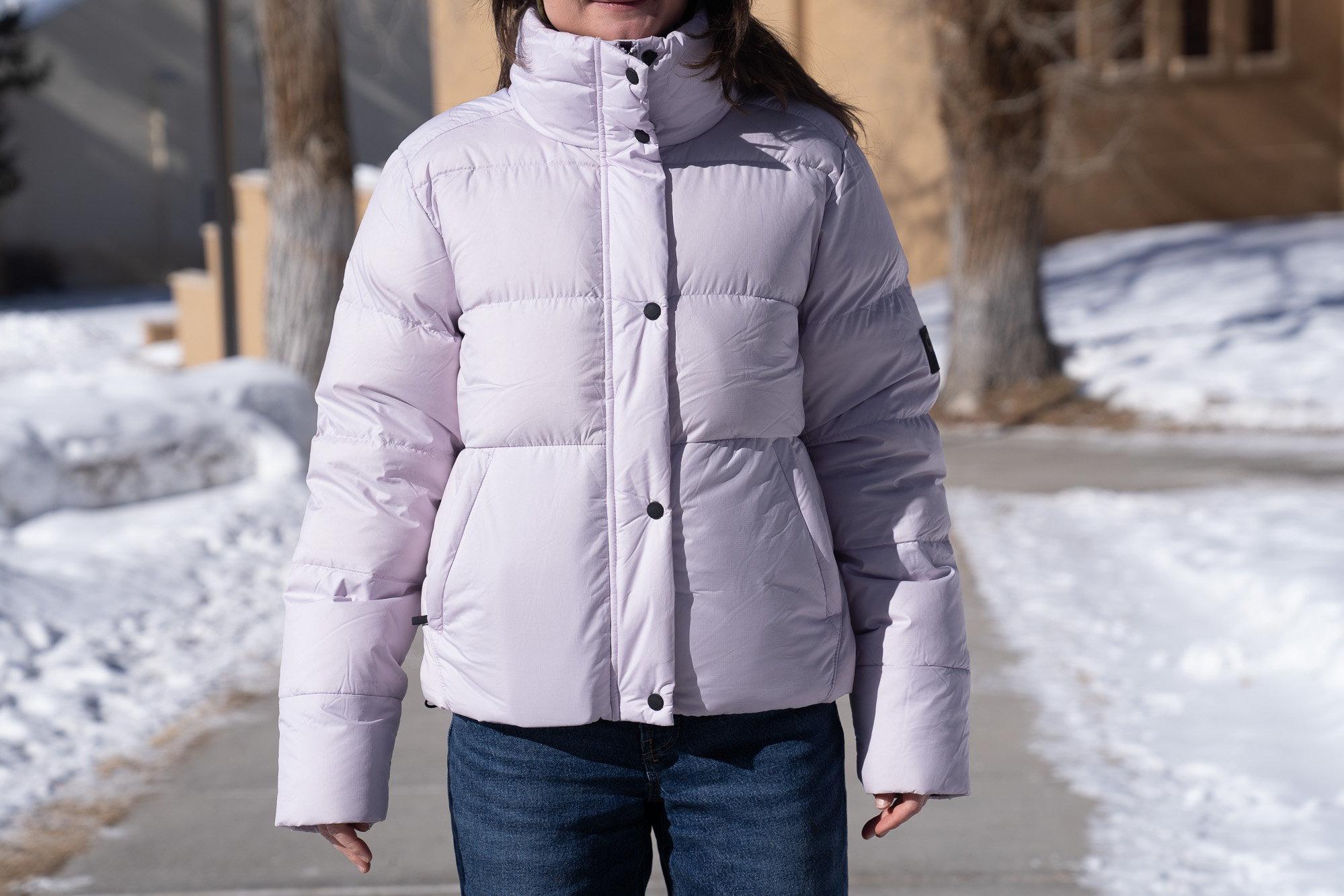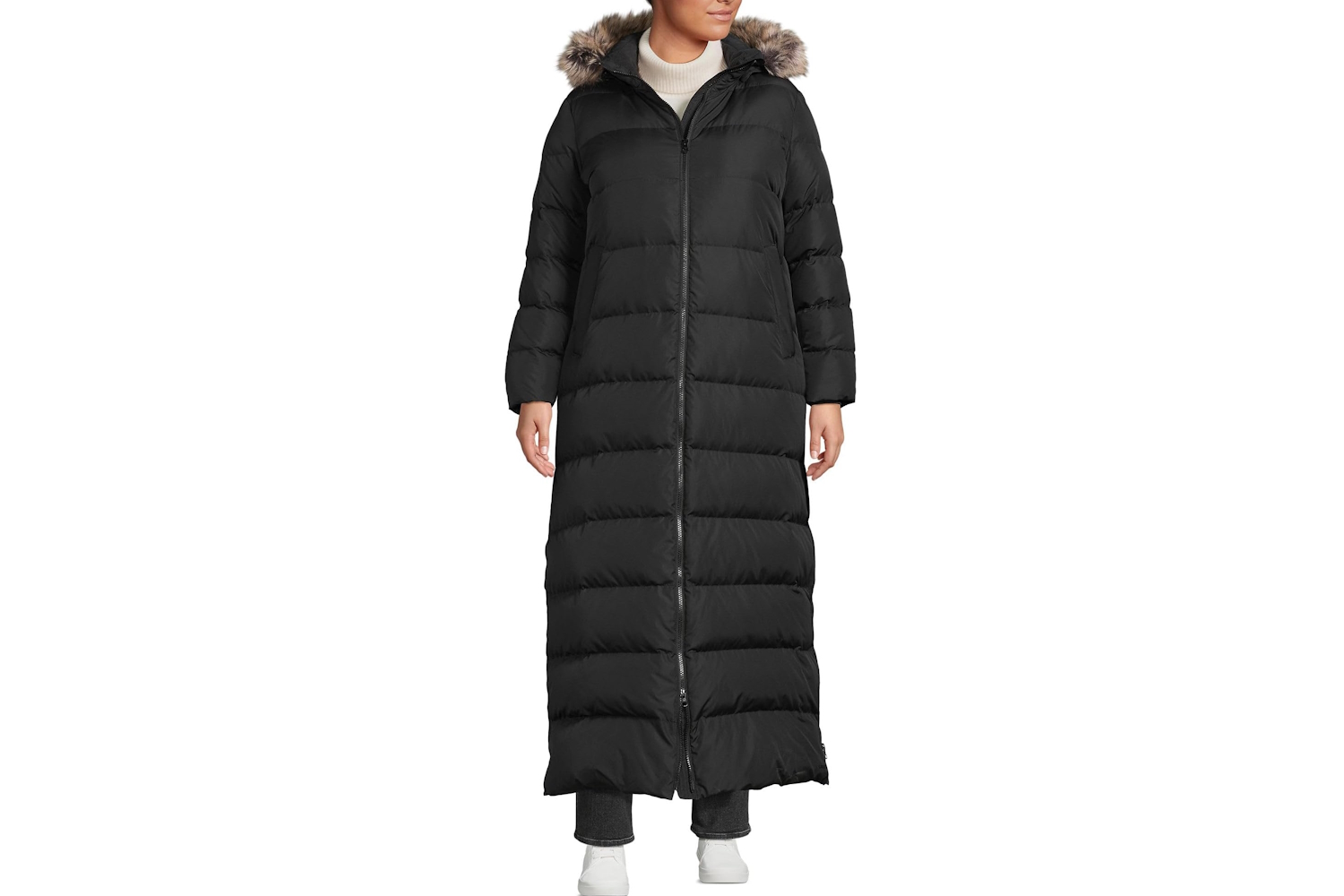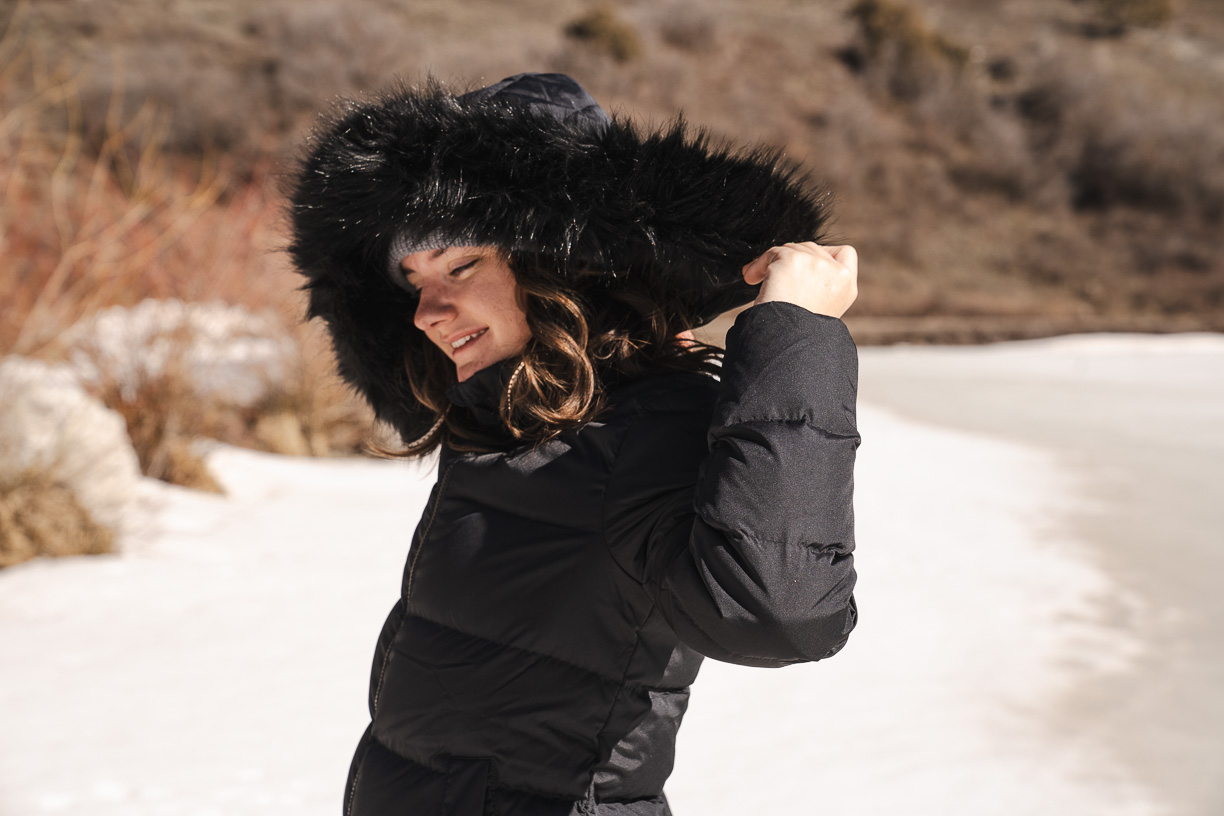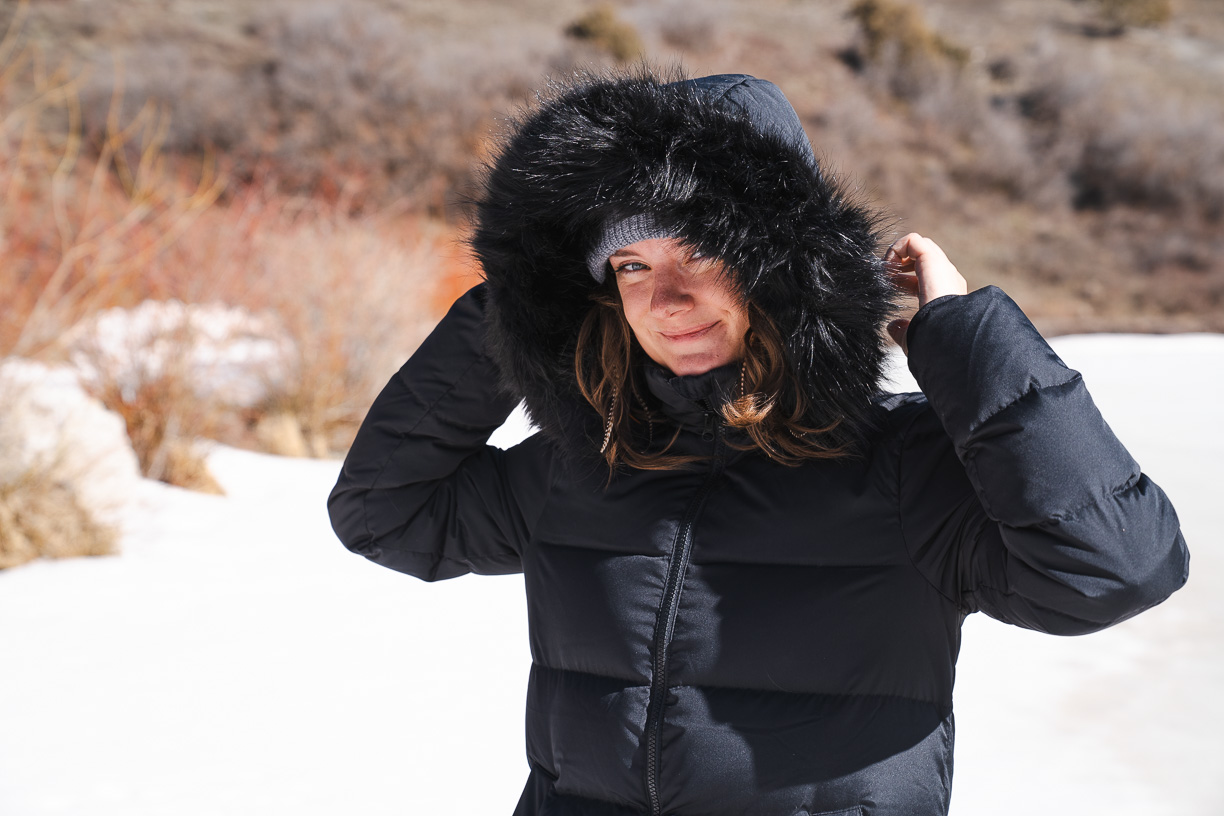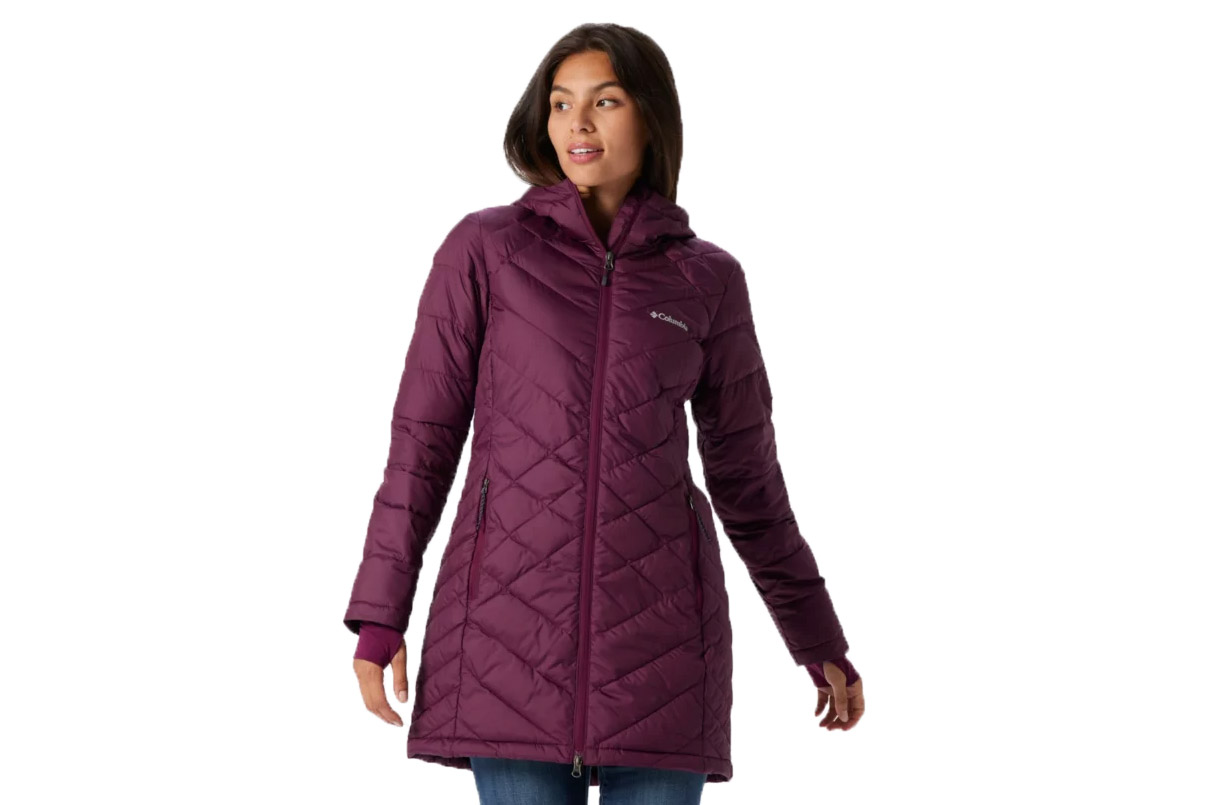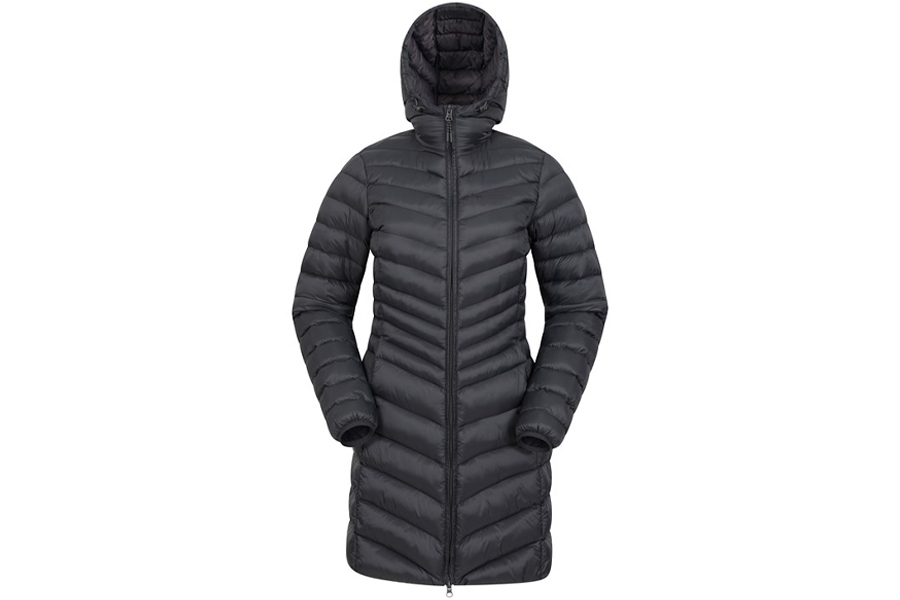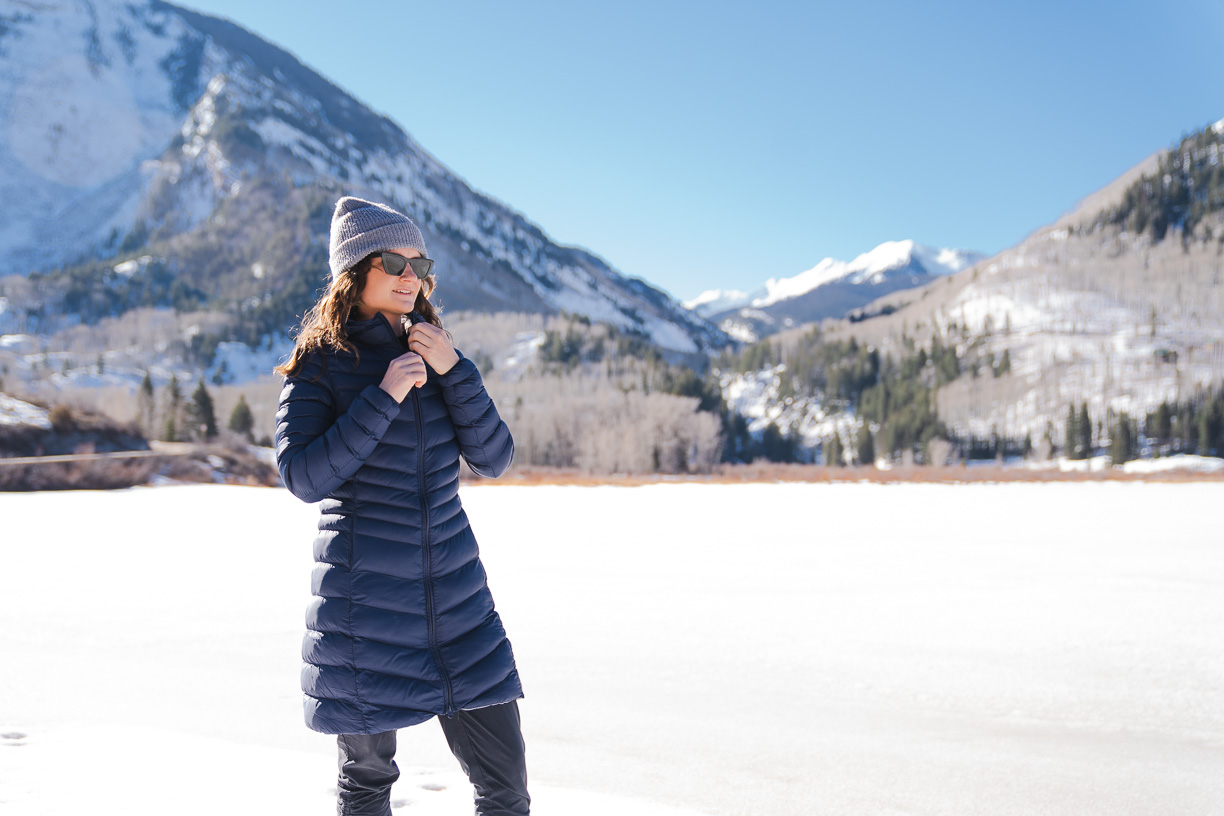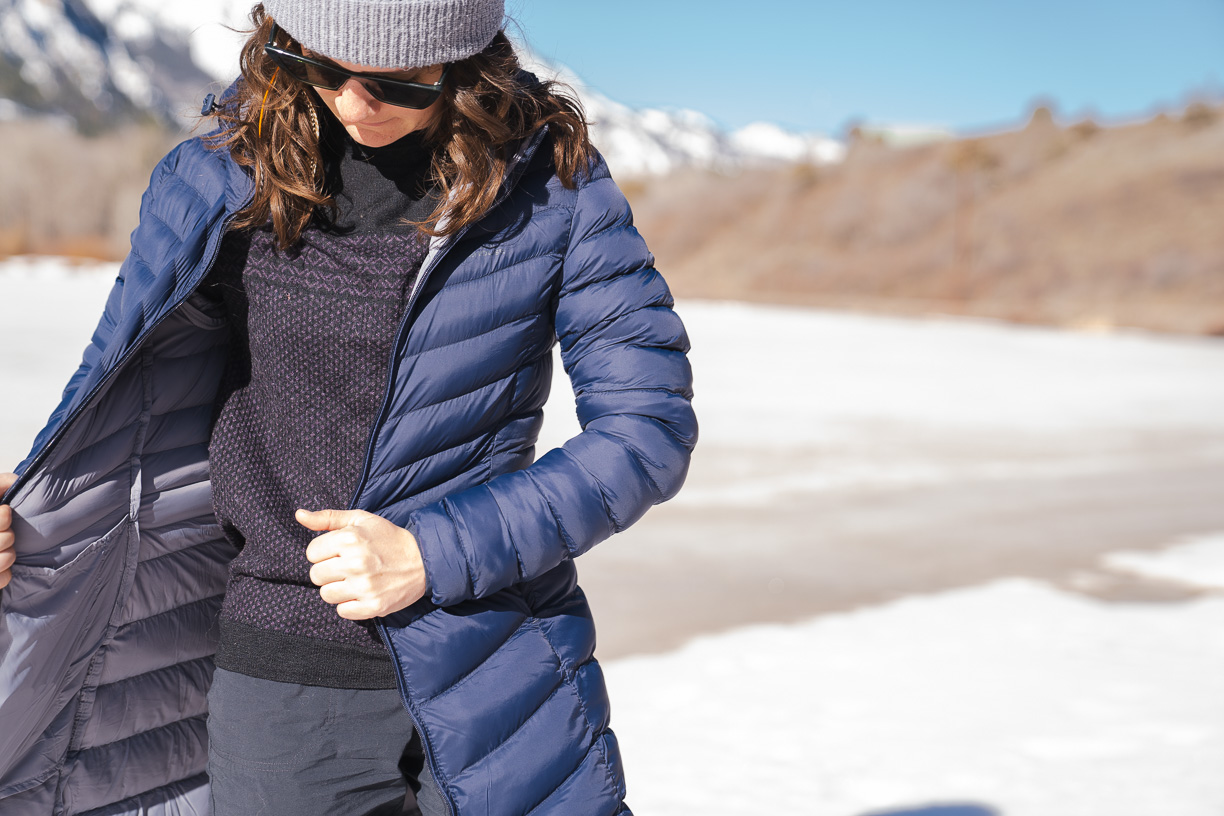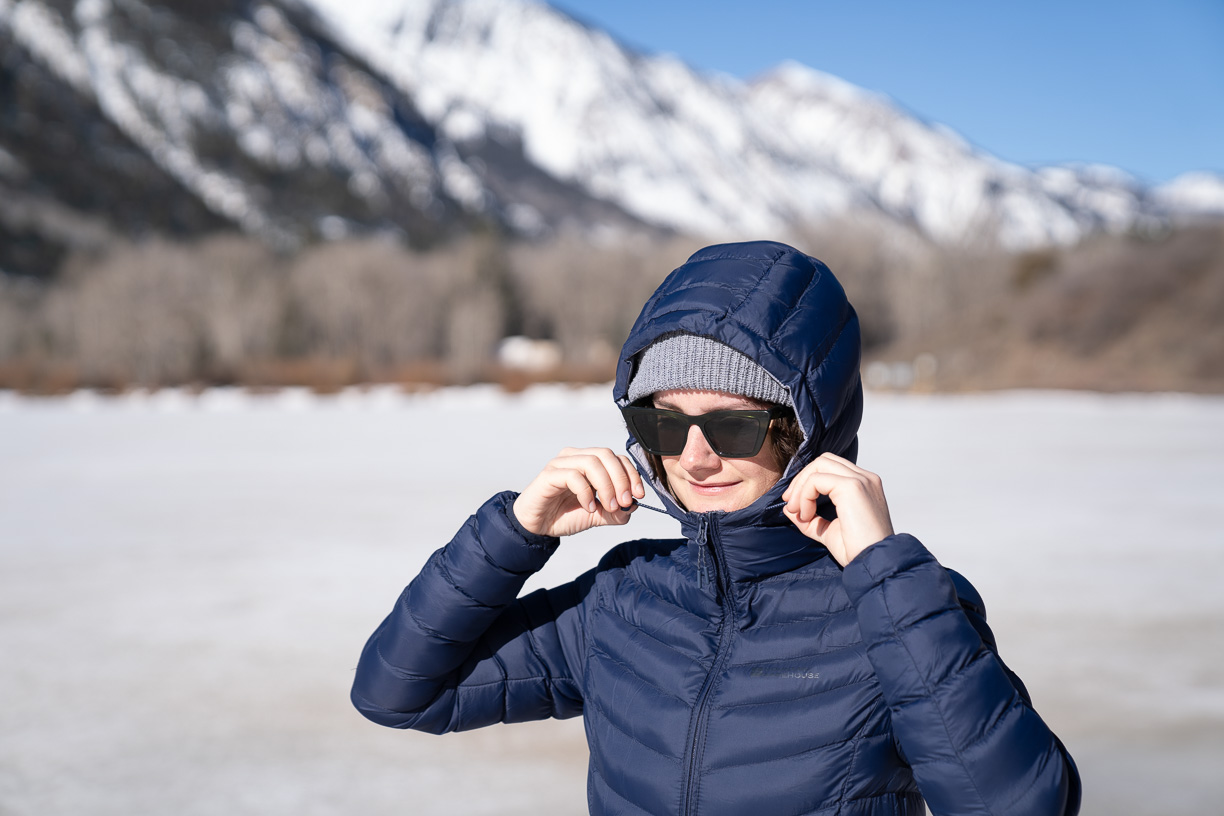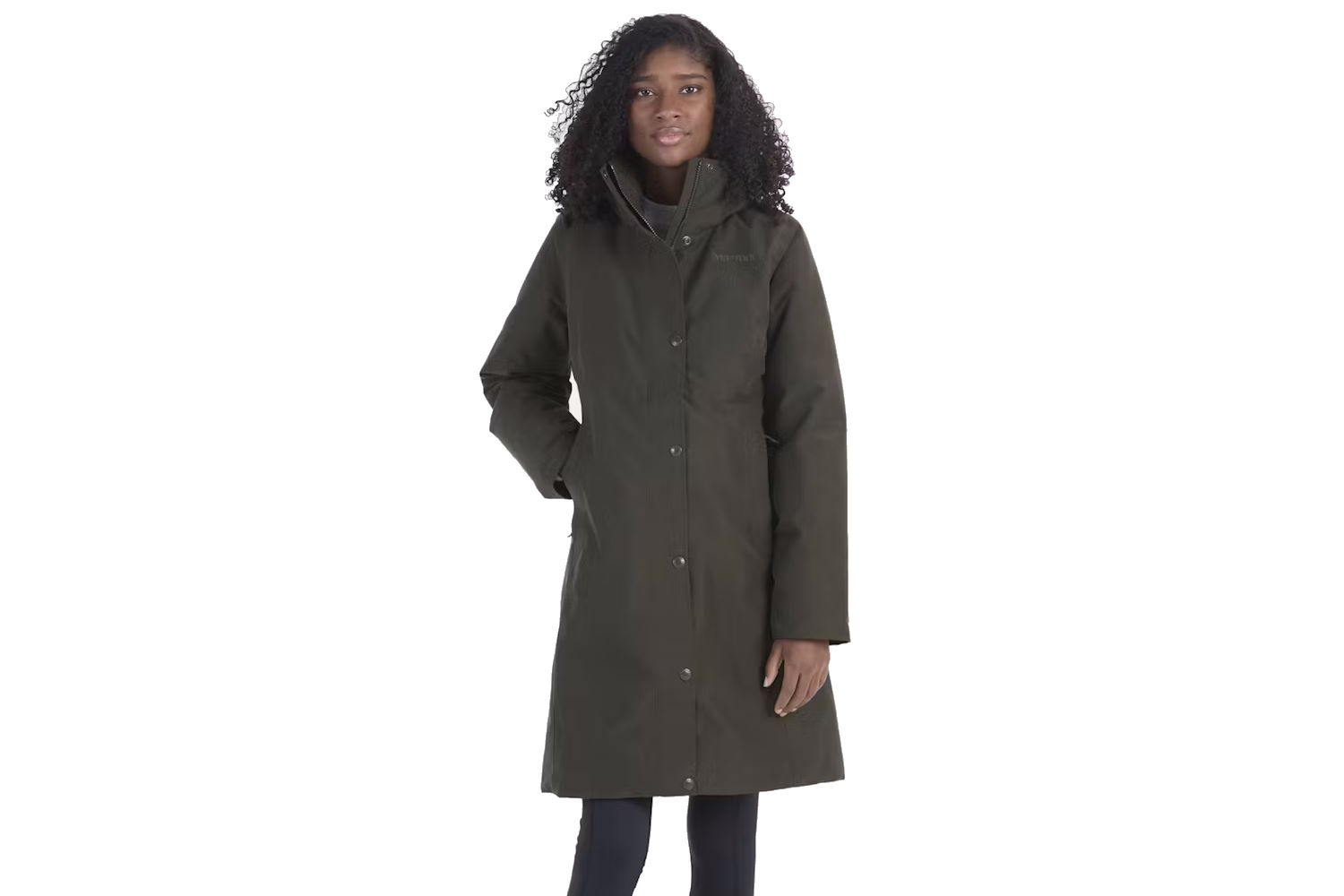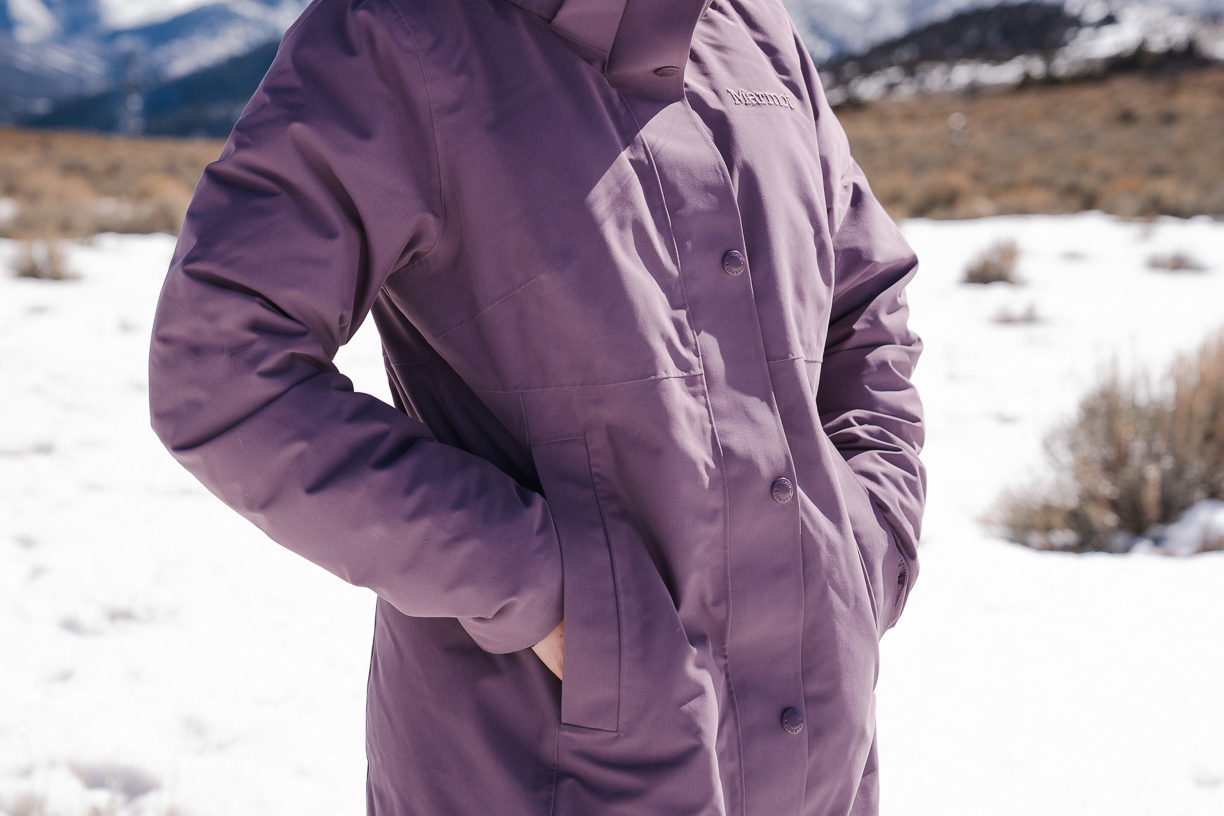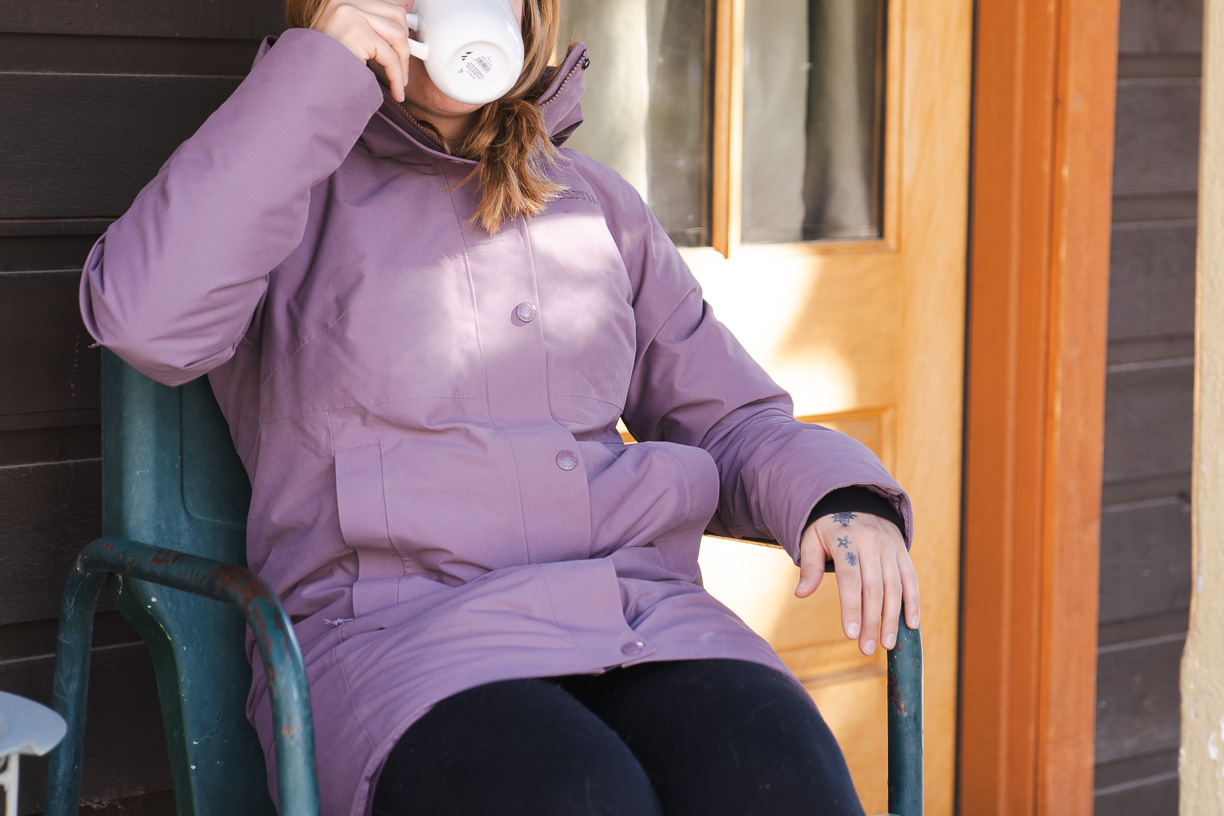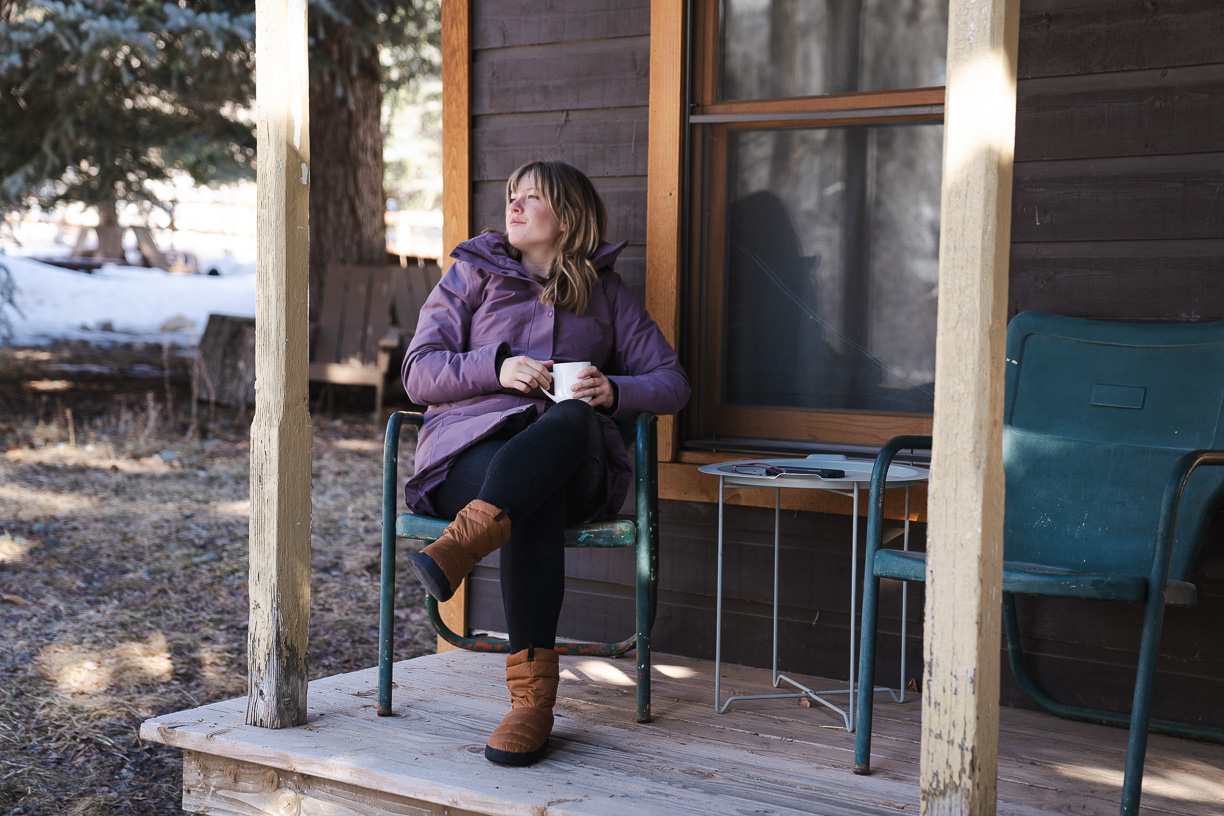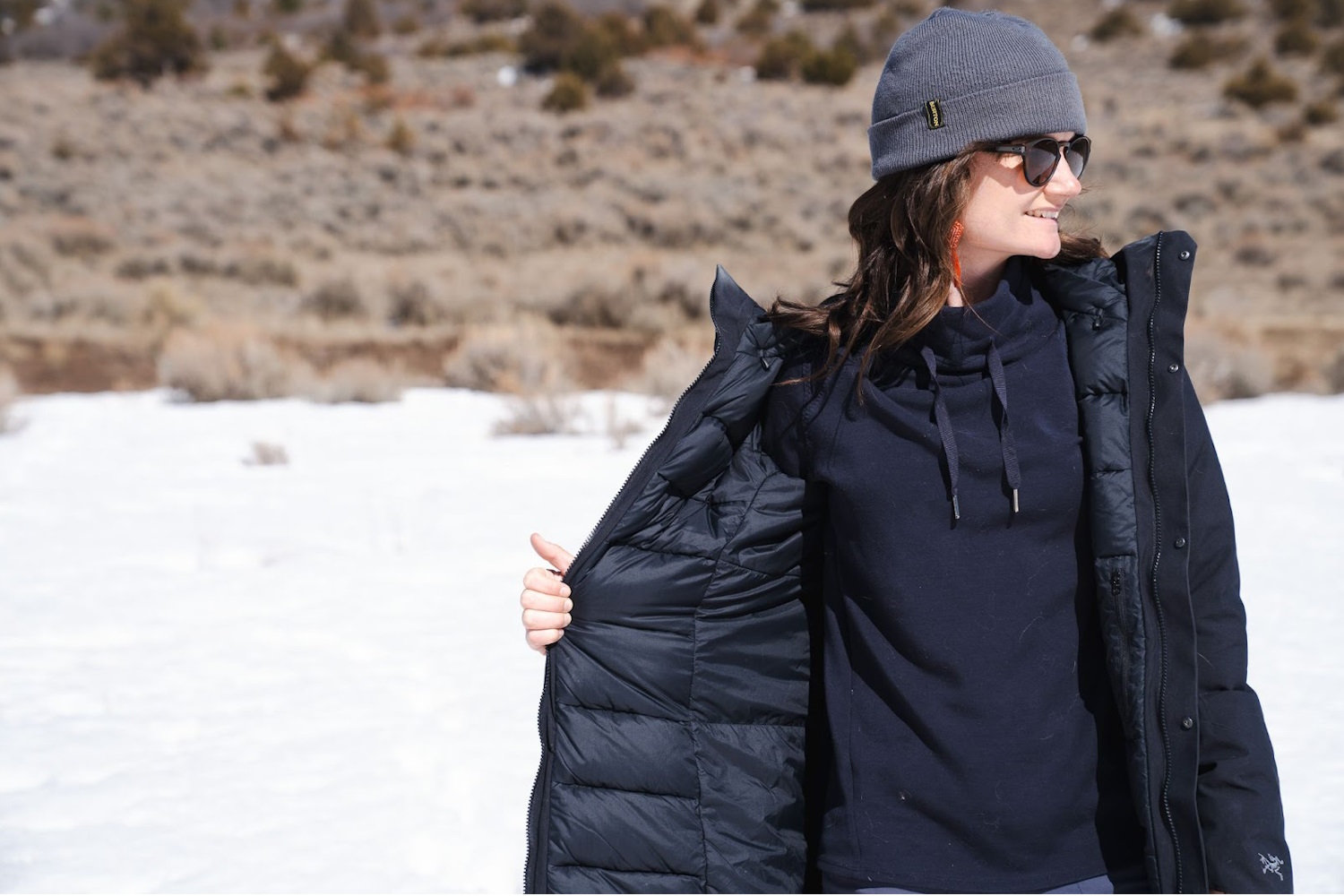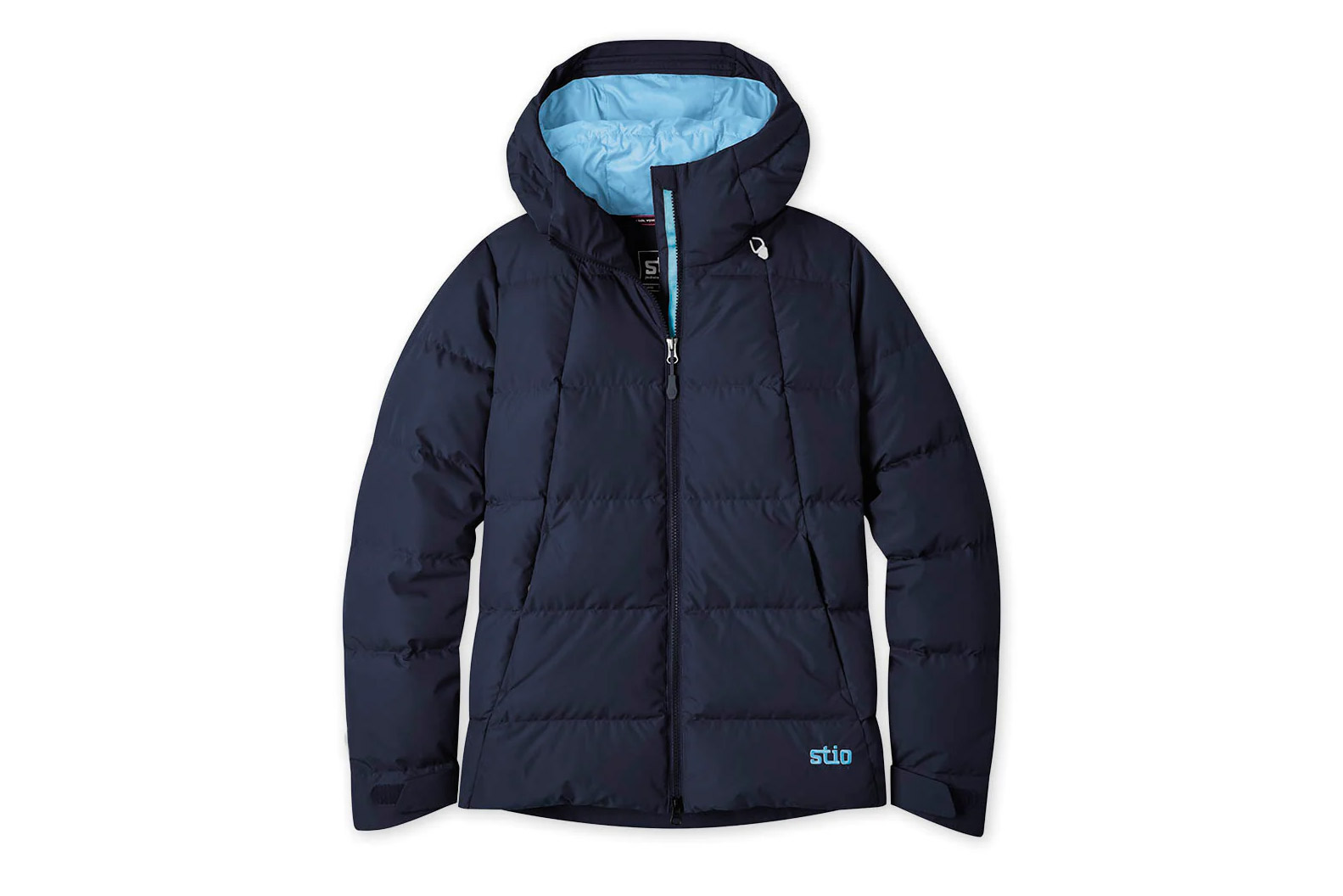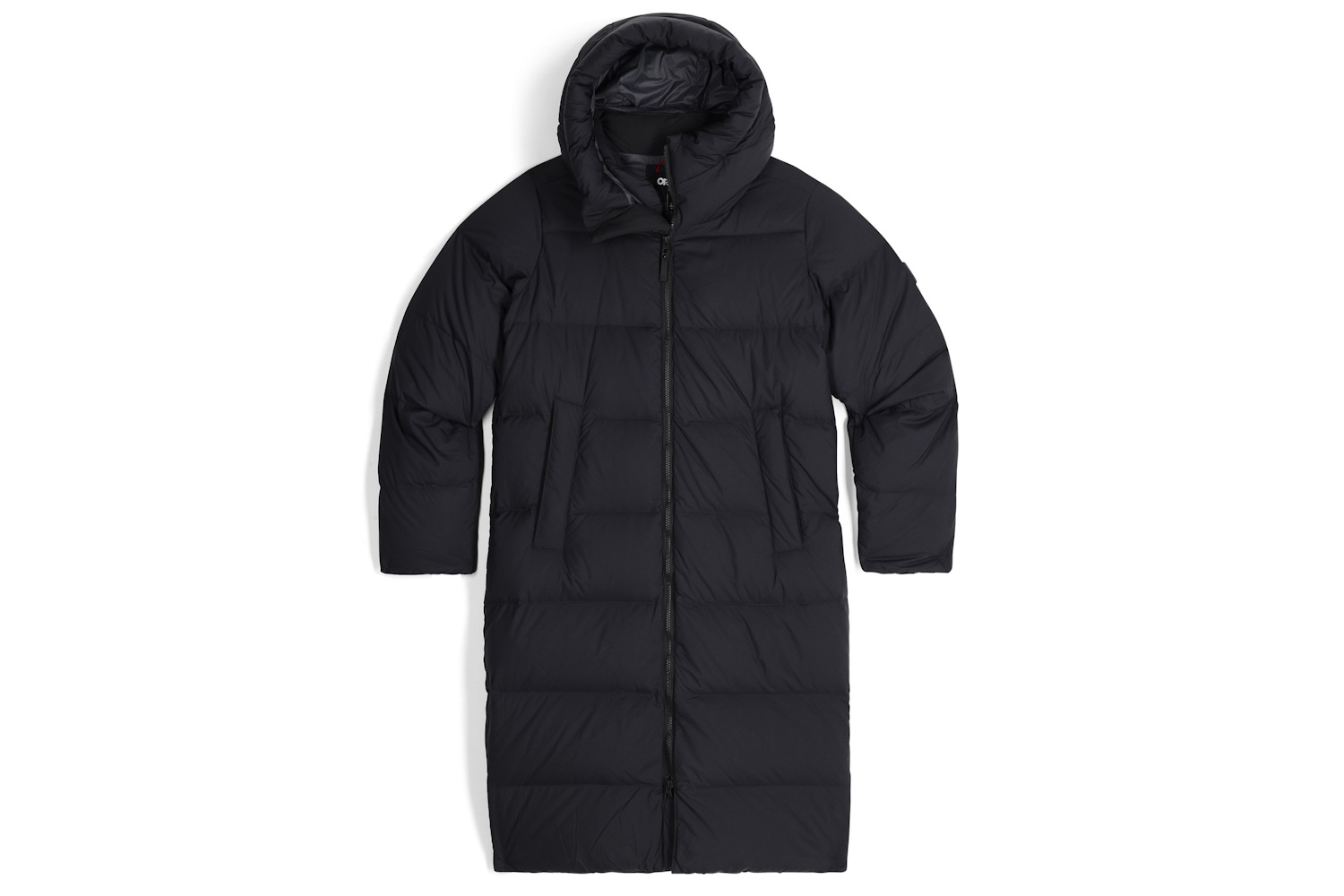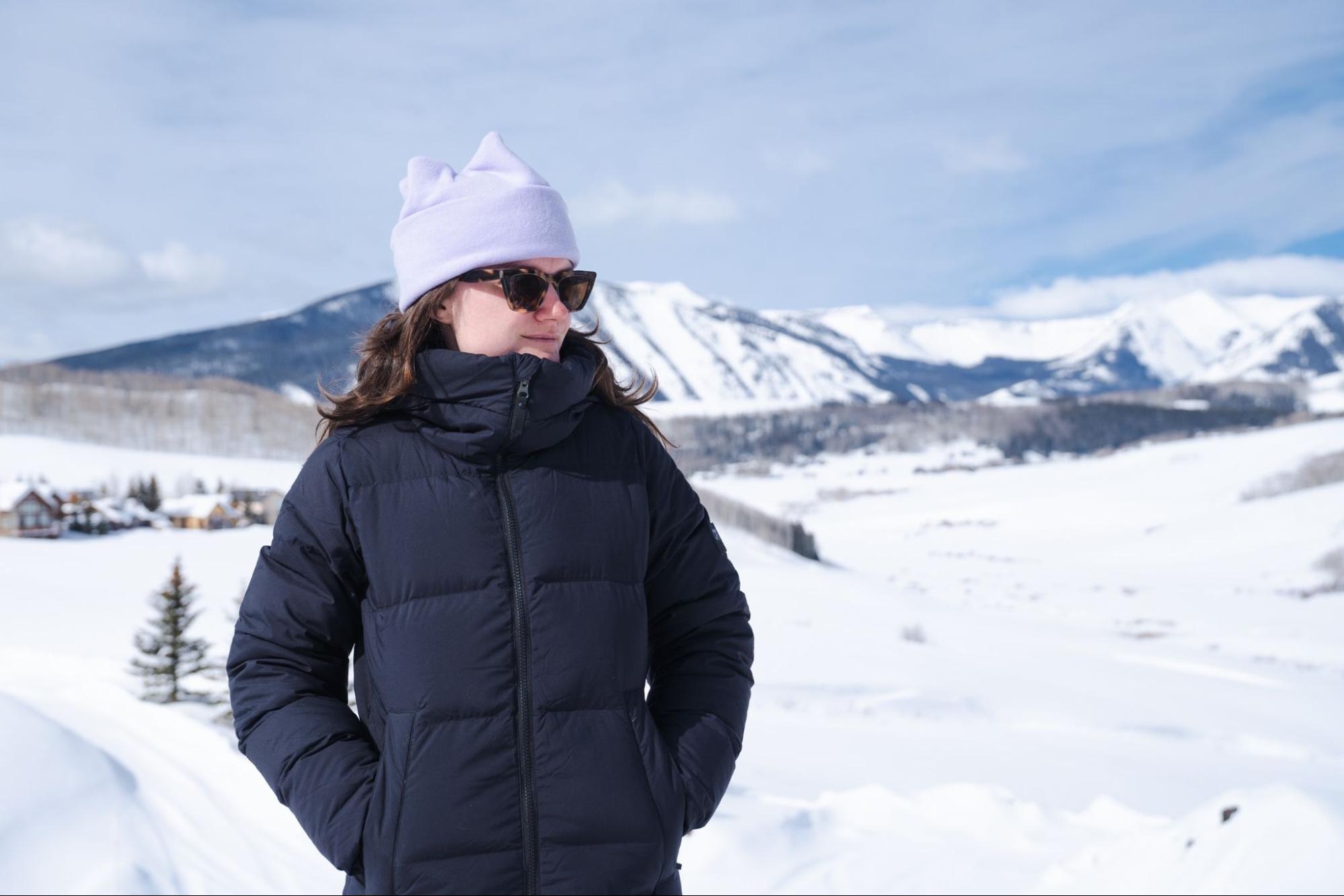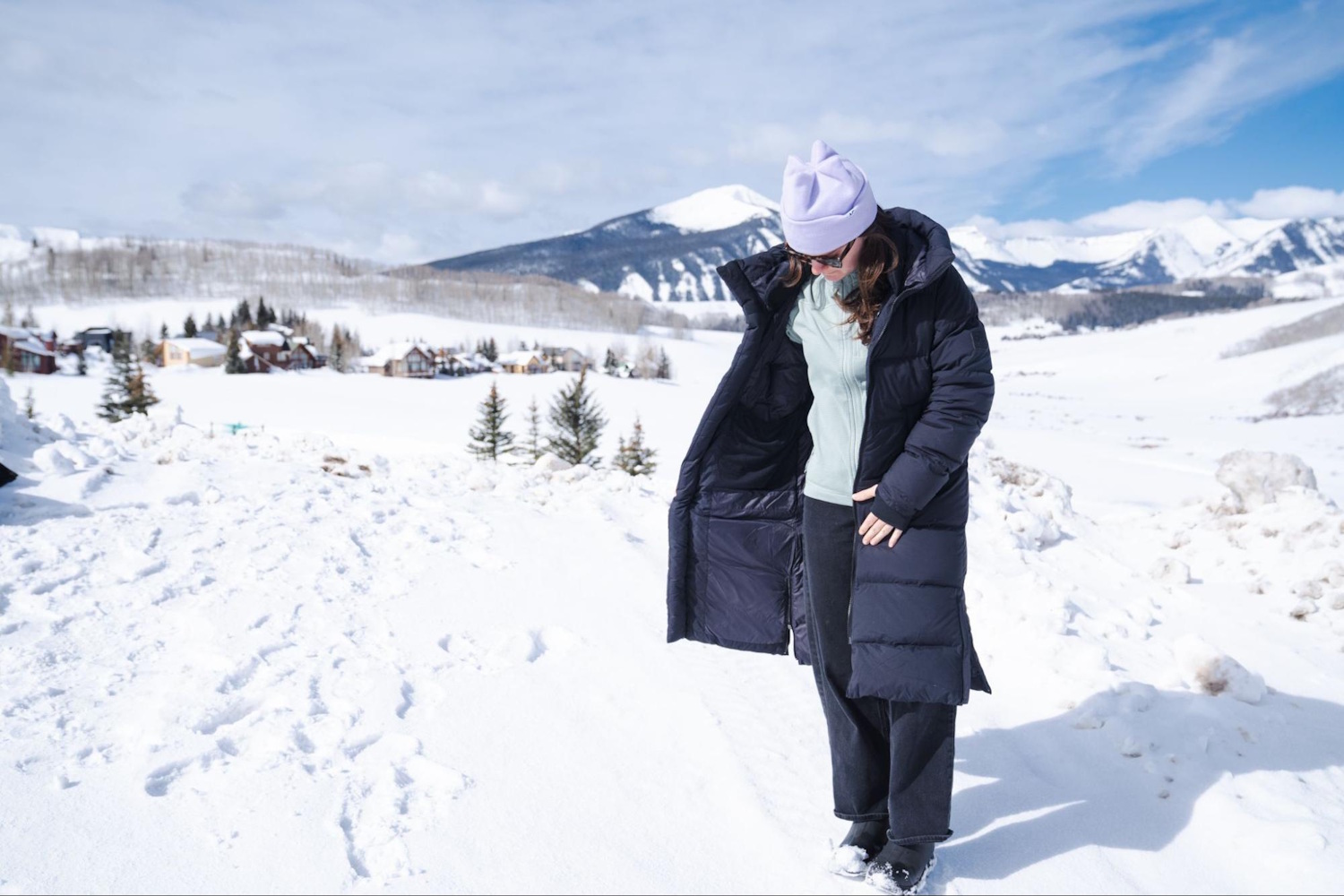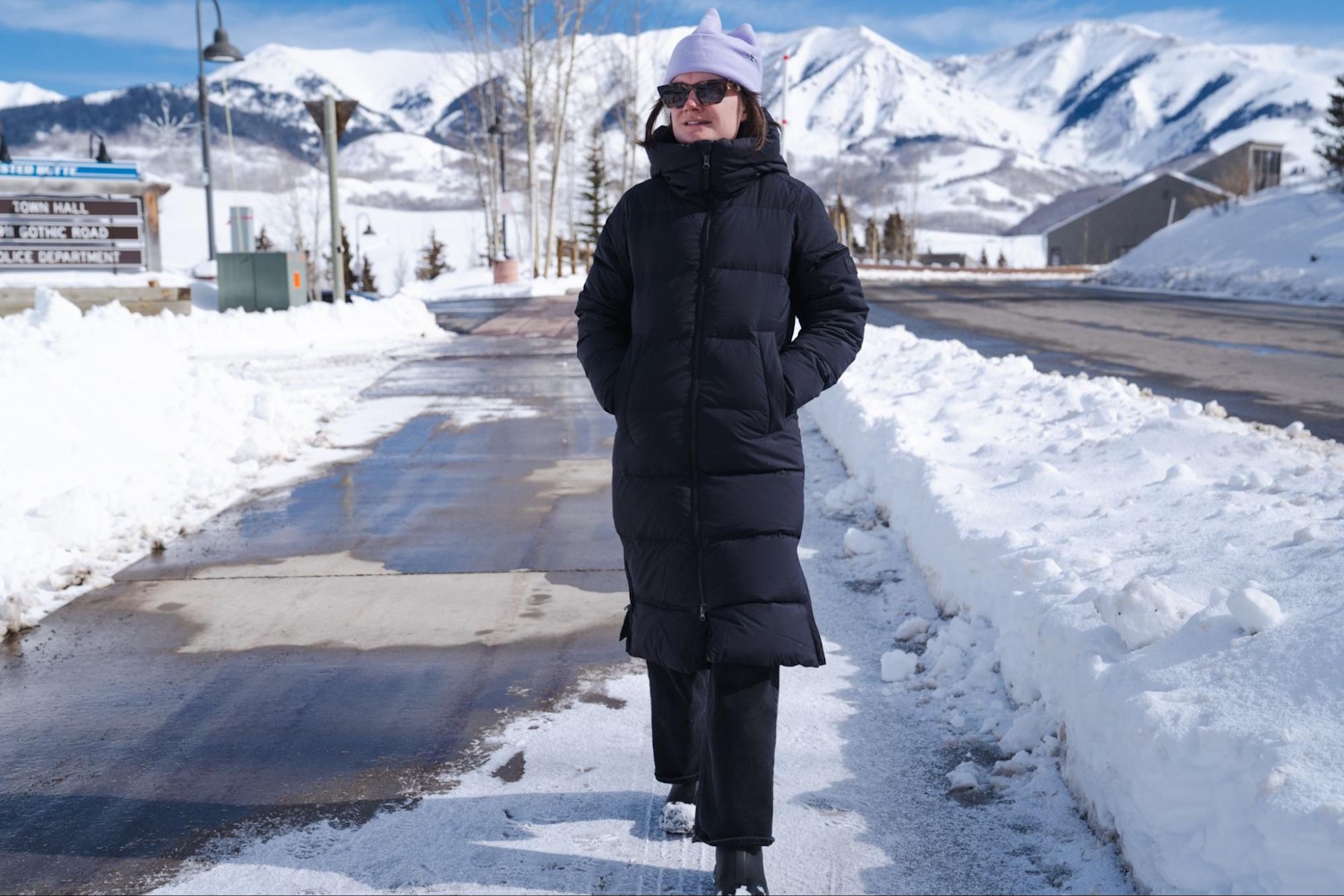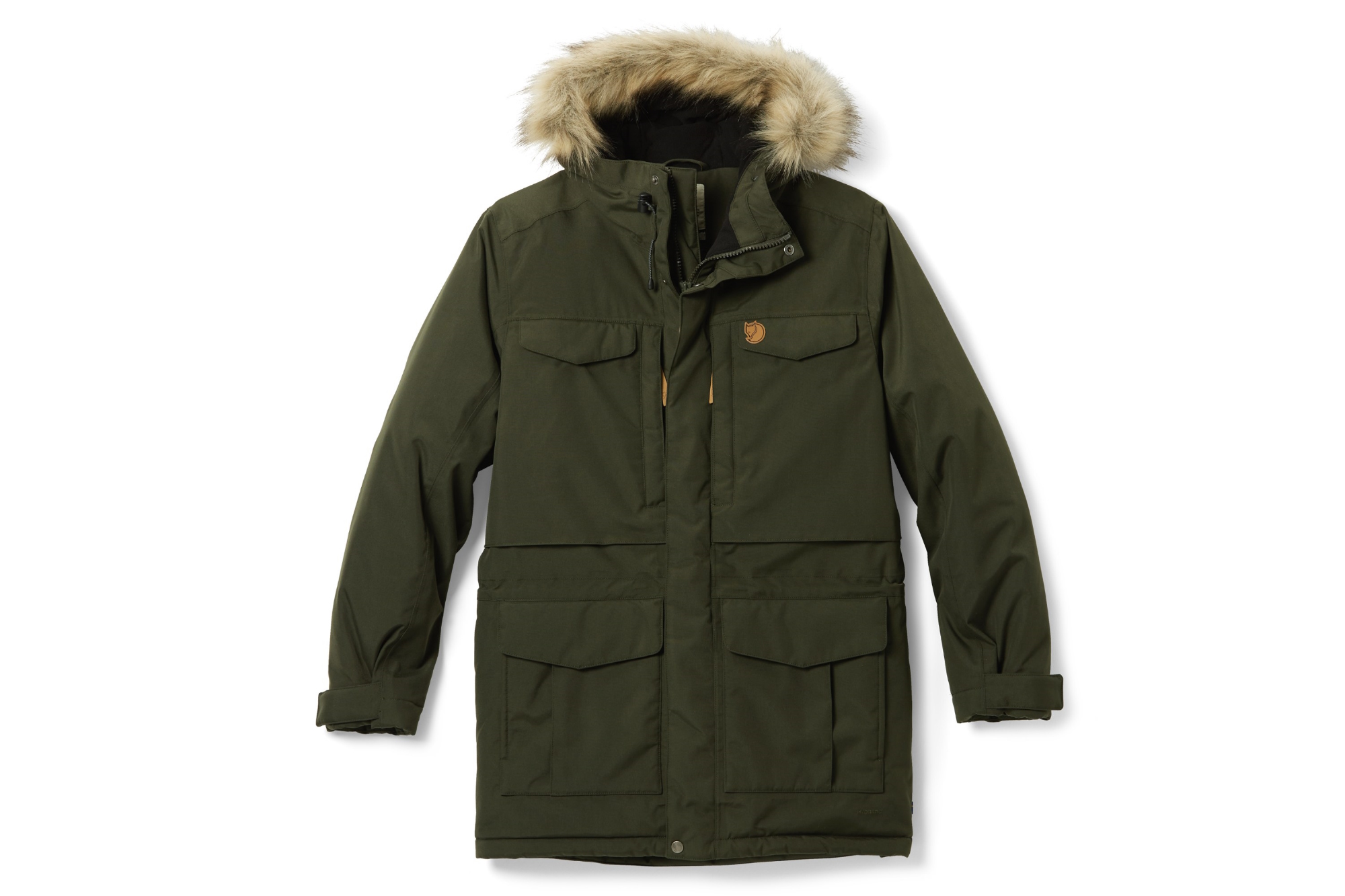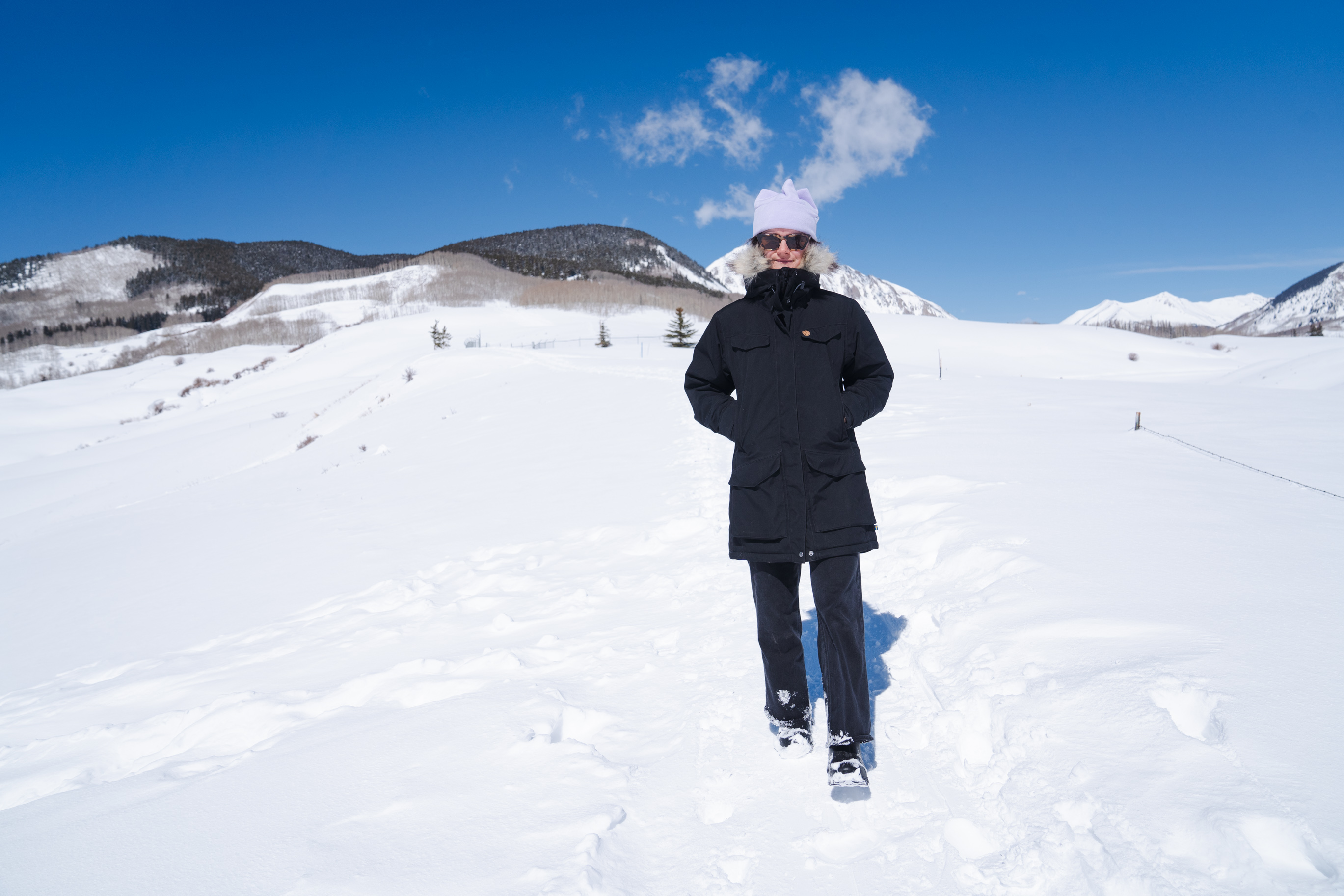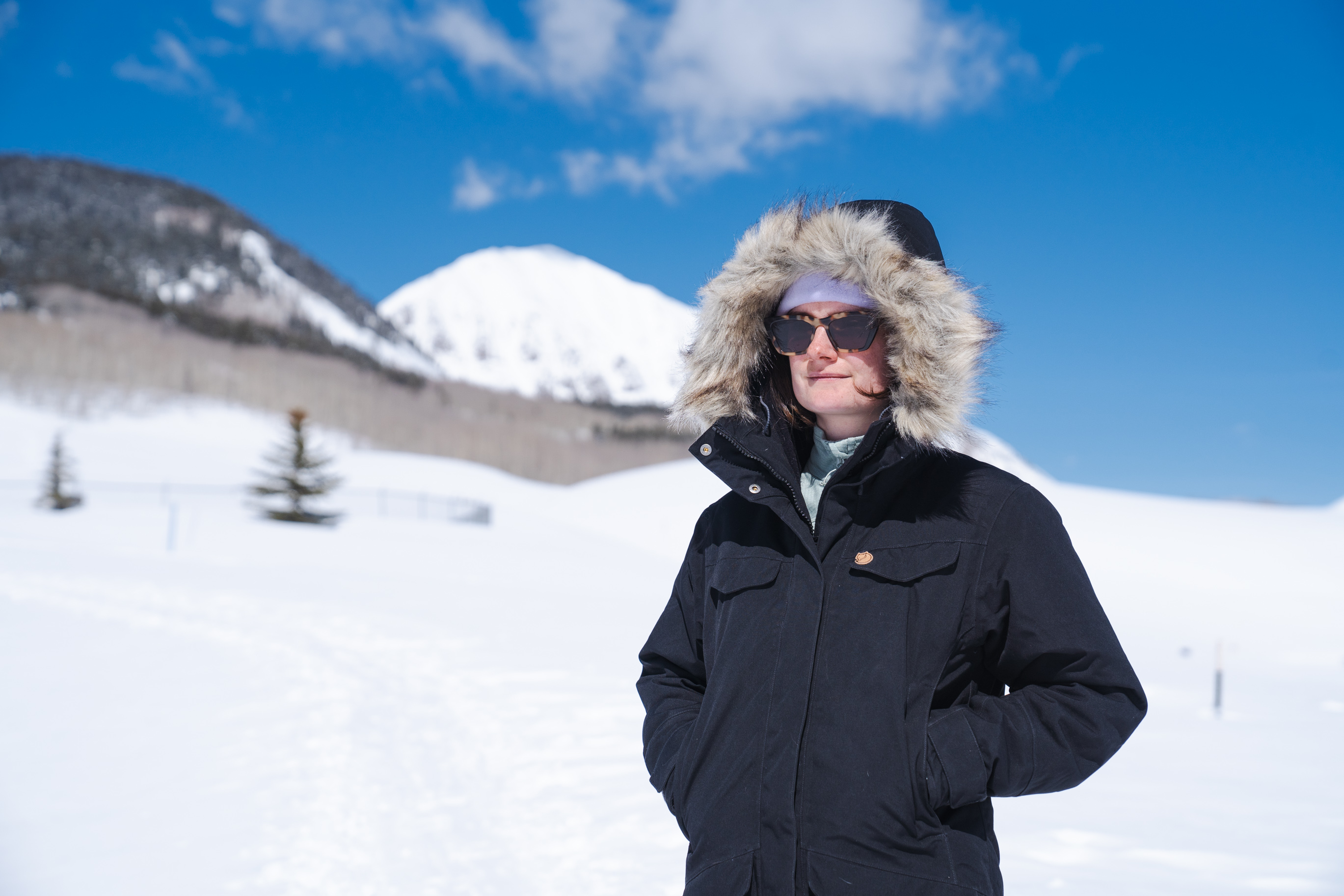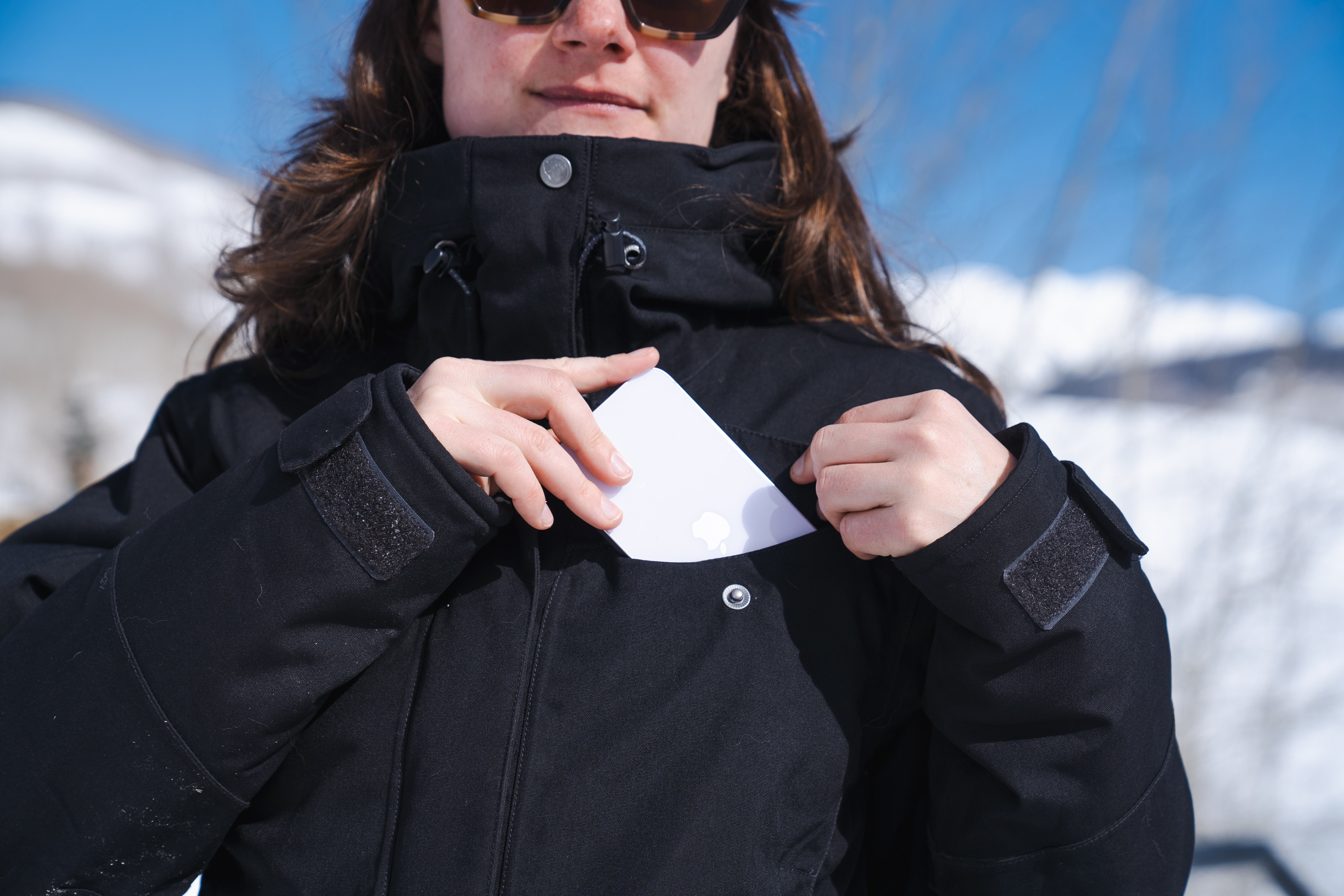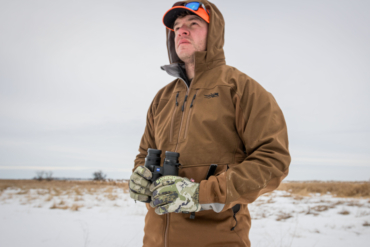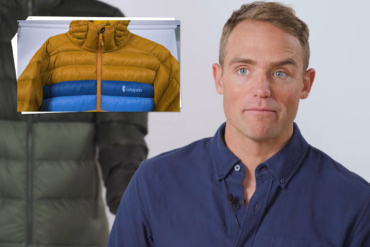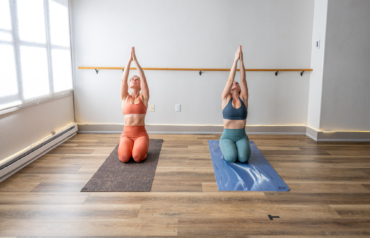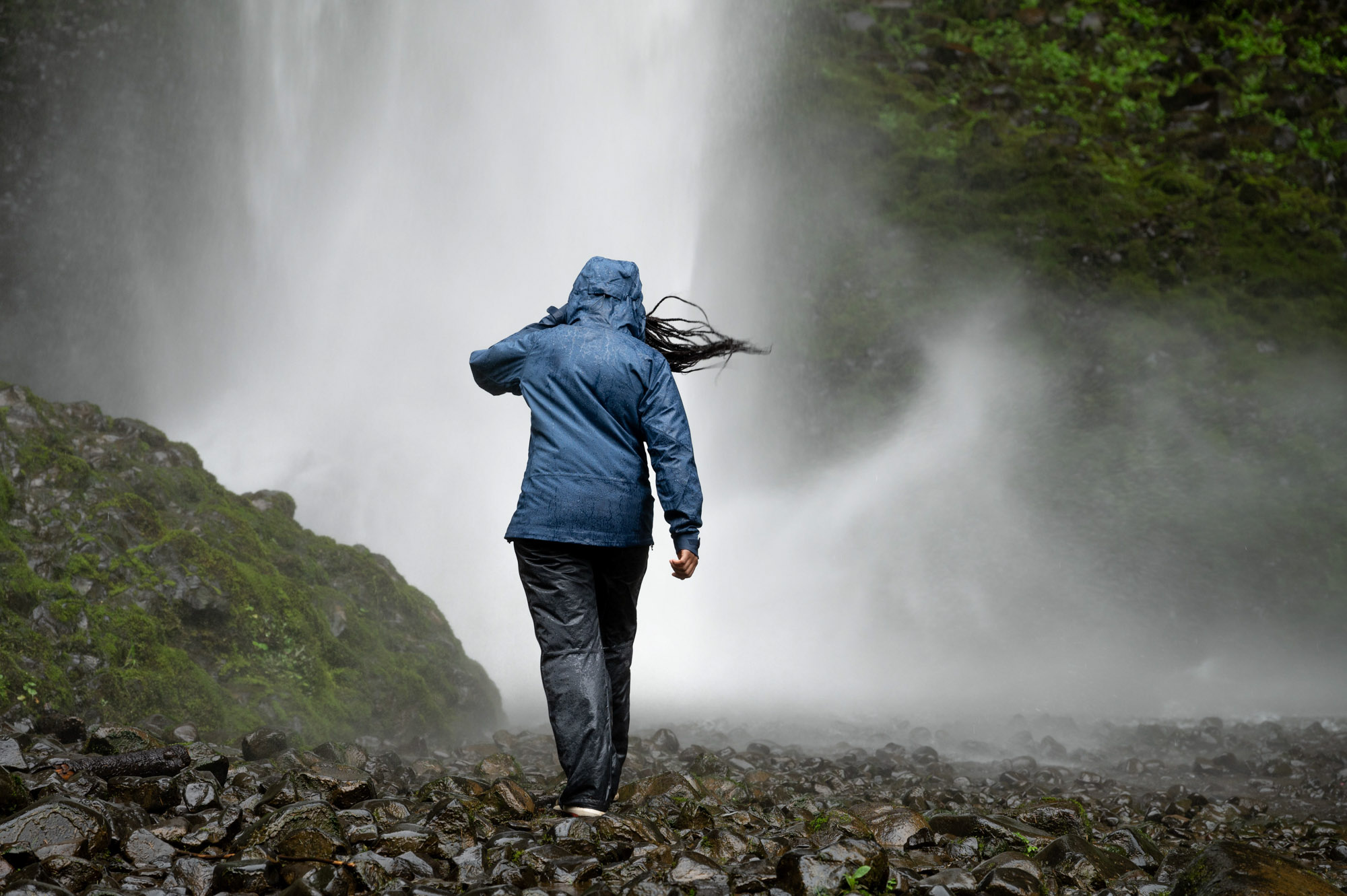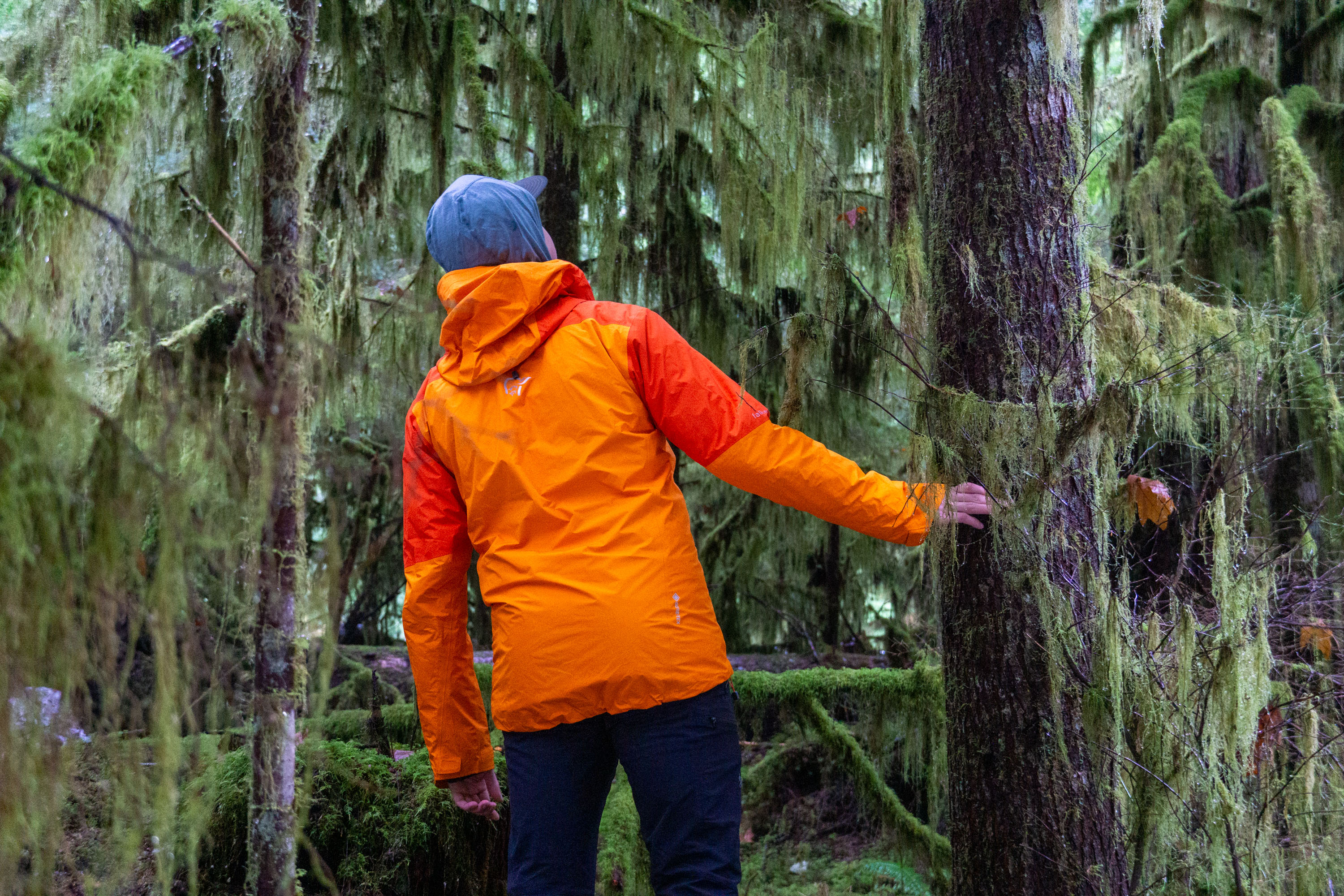Don’t let an arctic blast crash your plans. Whether you’re dashing through snowy streets, braving frosty commutes, or strolling through a real-life snow globe, these women’s winter jackets have your back. We’ve tested the coziest, most weather-ready silhouettes built for everyday adventures — not the hardcore gear meant for scaling icy peaks or shredding backcountry lines. Think warmth, comfort, and style that keeps you moving when the temps dip low.
We’ve updated this guide seven times since we first published it in 2021, after spending thousands of hours testing winter jackets in the frigid Gunnison Valley and Roaring Fork Valley in Colorado’s Elk Mountains, plus stints in British Columbia.
Our picks include knee-length jackets with toasty 800-fill insulation like the Rab Women’s Deep Cover Down Parka and long parkas like the Columbia Women’s Pike Lake III Long Jacket with recycled synthetic fill. Our collection also includes hip-hugging options such as the Outdoor Research Coldfront Down Jacket with 700-fill goose down insulation, and waterproof, windproof showstoppers like The North Face Women’s Arctic Parka.
Editor’s Note: We updated our Winter Jackets for Women buyer’s guide on December 17, 2025, with the newest iteration of the pocket queen, the Fjallraven Nuuk Parka.
The Best Winter Jackets for Women of 2025-2026
Rab Women’s Deep Cover Down Parka
-
Warmth
9.5
-
Hood and Collar
9.5
-
Weather Protection
8.9
-
Pockets
7.5
- Weight: 824 g
- Fill: 700
- Center back length: 35.4″
- Waterproof: The down fill and the exterior fabric are both treated for resistance against water and moisture
- Climate: Dry to mildly wet winter conditions
- Key features: Eco-friendly design, durable YKK zippers, removable hood, detachable faux fur for hood attaches via snaps, bungee cord tightens hood hem
Pros
- Two exterior hand pockets and the single interior chest pocket are all roomy
- Interior chin guard and collar feature a super soft liner
- Very windproof
- Made with 100% recycled down and 100% recycled fabric
Cons
- A looser silhouette than the trimmer fit some women might want
- Not waterproof for those high water-content coastal storms
- No bungee cord to snug up hood
REI Co-op Norseland Down Parka
-
Warmth
8.0
-
Hood and Collar
9.0
-
Weather Protection
9.0
-
Pockets
7.5
- Weight: 970 g
- Fill: 650
- Center back length: 36.5″
- Waterproof: No. Nonfluorinated DWR water-repellent on exterior and liner
- Climate: Dry to mildly wet winter conditions
- Key features: Recycled polyester liner, Bluesign-approved nylon exterior and polyester liner, 80% recycled down, 98% recycled 120g polyester fill, two-way front zipper, insulated fixed hood
Pros
- Sheds light rain and snow
- 6″ side vents add range of motion
- Economic price
- Fleece-lined hood
Cons
- Tailored silhouette isn’t as slender-cut as fitted designs
- No petite fit option
- Unlined chin guard could cause discomfort for sensitive skin
- Hood might not accommodate thick earmuffs
Columbia Women’s Pike Lake III Long Jacket
-
Warmth
9.0
-
Hood and Collar
9.0
-
Weather Protection
8.7
-
Pockets
7.5
- Weight: 1,095 g
- Fill: 100% recycled polyester
- Center back length: 45”
- Waterproof: Water resistant
- Climate: Dry to mildly wet winter conditions
- Key features: Adjustable waist and hood, large front pockets, mobility snaps near legs, Omni-Heat thermal lining, full-coverage length, size inclusivity
Pros
- Full-coverage length
- Snappable leg slits helps with range of movement
- Hood has drawstring for customized fit
Cons
- Might be too bulky for some folks
- Heavier and not as packable as other options
Patagonia Women’s Tres 3-in-1 Parka
-
Warmth
9.0
-
Hood and Collar
9.5
-
Weather Protection
9.8
-
Pockets
7.0
- Weight: 1,446 g
- Fill: 700
- Center back length: 33″
- Waterproof: Exterior outermost layer and interior down parka have PFC-free DWR
- Climate: Dry to the wettest coastal winter conditions
- Key features: Removable hood on exterior shell, two exterior zippered hand pockets, interior chest pocket, tall fleece-lined collar, 100% recycled polyester shell and liner, 100% recycled down
Pros
- Fixed brim on shell hood helps block rain
- Shell sheds rain extremely well and keeps interior parka dry
- Articulated fit plus room for midlayers
- Essentially three jackets in a single package
Cons
- No interior chest pocket on rain shell
- Arm cuffs lack wrist gaiters if that's a preference
- Isn't the most flexible fabric or roomiest cut on our list
KUHL Spyfire Women’s Parka
-
Warmth
7.9
-
Hood and Collar
7.0
-
Weather Protection
8.5
-
Pockets
8.5
- Weight: 510 g
- Fill: 800
- Center back length: 34.5”
- Waterproof: No. Water resistant
- Climate: Winter Dry to somewhat wet winter conditions
- Key features: Reflective trim on pockets for better visibility, exterior sleeve pocket, internal cuffs, thermal body mapping, 800-fill goose down, tapered silhouette, packable
Pros
- 800-fill RDS-certified goose down provides ample warmth
- Exterior sleeve pocket to stash small items like keys or an ID
- Tapered silhouette
- Lightweight and packable
Cons
- Lack of thumb holes on wrist cuffs
The North Face Women’s Arctic Parka
-
Warmth
6.9
-
Hood and Collar
9.0
-
Weather Protection
8.5
-
Pockets
8.0
- Weight: 1,290 g
- Fill: 600
- Center back length: 35.25″
- Waterproof: Yes. Waterproof-breathable and windproof plus PFC-free DWR
- Climate: Dry to the wettest coastal winter conditions
- Key features: 100% recycled RDS-certified down, 100% recycled body fabric and liner, PFC-free DWR, attached hood, removable faux-fur trim for hood, two exterior hand pockets, one interior pocket that’s media-compatible, rib-knit wrist cuffs with thumbholes
Pros
- Waterproof-breathable exterior shell
- Removable faux fur on hood
- Interior waist cinch for snugness and blocking elements
- Recycled down fill and material
Cons
- Not the lightest weight option
- Arms do not retain as much heat as torso area
- Lacks zippered chest pocket
Stio Women’s Turnbolt Down Jacket
-
Warmth
7.0
-
Hood and Collar
6.9
-
Weather Protection
8.5
-
Pockets
9.0
- Weight: 681 g
- Fill: 650
- Center back length: 25.5″
- Waterproof: PFAS-free water-repellent finish
- Climate: Dry to mildly wet winter conditions
- Key features: RDS-certified down fill
Pros
- Brilliant hand pocket design that's layered with secondary stash pockets
- Hip style
- Effective PFAS-free water-resistant treatment
- Hood-free for a streamlined fit
Cons
- If it's windy or snowing the hood-free design won't fully block the neck
- There are more waterproof and windproof options
Other Winter Jackets for Women That Keep Us Toasty
While our awarded women’s jackets take over winter’s round table, we have a short list of other keepers. These jackets might compromise a bit of service, but they remain stylish, functional, and in our closets.
-
Warmth
8.0
-
Hood and Collar
7.0
-
Weather Protection
7.0
-
Pockets
7.0
- Weight: 536 g
- Fill: 700+
- Center back length: 25”
- Waterproof: No. Water-resistant.
- Climate: Dry to mildly wet winter conditions
- Key features: Tall insulated collar, tricot-lined pockets, internal knit gaiters, bluesign-approved Pertex Quantum Eco 100% polyester (53% recycled), 30-denier double ripstop shell and lining
Pros
- Lofty down provides ample warmth
- Soft material is gentle on the skin
- High collar provides lower face protection
- Cinch-able waist offers length adjustment and increases insulation
Cons
- Wrist gaiters are sewn in short into the sleeve and might be tight for folks with longer arms
- Lacks a zippered chest pocket
-
Warmth
8.0
-
Hood and Collar
8.5
-
Weather Protection
7.5
-
Pockets
8.0
- Weight: 1,238 g
- Fill: 600
- Center back length: Below the calf
- Waterproof: No. Water-resistant exterior fabric
- Climate: Dry to mildly wet winter conditions
- Key features: Interior chest pocket with snap closure, two zippered hand pockets, interior cuffs add warmth
Pros
- Hood is removable and includes a removable faux fur trim
- Two-way front zipper for ventilation and mobility
- Low-lying side zippers for mobility while getting in and out of a vehicle or walking
- Economic price for the coverage
Cons
- Liner is not water resistant
- Polyester shell is not the most durable
- Exterior pockets lack zip closure
-
Warmth
6.5
-
Hood and Collar
8.0
-
Weather Protection
8.0
-
Pockets
8.0
- Weight: 819 g
- Fill: Synthetic down 100% polyester
- Center back length: 34"
- Waterproof: Water-resistant
- Climate: Dry to mildly wet winter conditions
- Key features: Omni-Heat thermal reflective liner, water-resistant fabric, interior chest pocket, soft fleece lined hood and collar, zippered hand pockets, comfortable hand gaiters with thumbholes, drop tail for full coverage of the hips, 2-way center front zipper
Pros
- Omni-Heat thermal reflective liner helps reflect body heat
- Lightweight fabric and shorter length is great for active use
- Full coverage hood
- Available in plus sizes 1X-3X
Cons
- Synthetic fill is not ideal for super cold winter use
- Jacket is not waterproof or windproof
- No eco-friendly materials
-
Warmth
6.0
-
Hood and Collar
7.0
-
Weather Protection
6.0
-
Pockets
6.5
- Weight: 566 g
- Fill: 100% polyester fill
- Center back length: 35”
- Waterproof: No, water-resistant with DWR finish
- Climate: Dry to mildly wet winter conditions
- Key features: Insulated wrist cuffs, silky soft materials, two side pockets
Pros
- Packable without losing loftiness
- Budget friendly
- Snug wrist cuffs improve insulation
Cons
- Thread near zipper end began to fray after a couple uses
- Synthetic fill doesn’t bolster as much warmth as down
- Zipper can be finicky
-
Warmth
8.0
-
Hood and Collar
6.5
-
Weather Protection
9.5
-
Pockets
7.5
- Weight: 1,257 g
- Fill: 700
- Center back length: 38”
- Waterproof: Yes
- Climate: Dry to the wettest coastal winter conditions
- Key features: Removable hood, recycled down, microfleece-lined pockets, 100% seam-taped construction to prevent water leakage
Pros
- Highly durable materials that ward off water and tears
- Versatile style and customizable look thanks to removable hood
- Provides ample insulation and protection from winter elements
- Eco-friendly use of Kapok Down and other recycled materials
Cons
- Collar material is abrasive near chin which causes chafing
- Lack of interior or chest pockets
-
Warmth
7.9
-
Hood and Collar
7.0
-
Weather Protection
6.5
-
Pockets
7.0
- Weight: 376 g
- Fill: 800
- Center back length: 36″
- Waterproof: No. Water-resistant shell and lining plus down have been treated for water resistance
- Climate: Dry to mildly wet winter conditions
- Key features: Length reaches just above the knee, hooded, two-way front zipper, packable into its own pocket, bungee cinch on backside of hood for a snugger fit
Pros
- Water-resistant shell
- Down is hydrophobic
Cons
- Zipper feels a bit cheap (but hasn’t failed)
- No cinch along hem of hood
-
Warmth
8.4
-
Hood and Collar
7.9
-
Weather Protection
9.5
-
Pockets
8.0
- Weight: 905 g
- Fill: 750 (plus synthetic insulation in targeted spots)
- Center back length: 37″
- Waterproof: Pretty much. Waterproof/breathable GORE-TEX fabric plus additional DWR treatment and taped seams. The front and pocket zippers are highly water-resistant but not waterproof
- Climate: Dry to the wettest coastal winter conditions
- Key features: Two hand pockets with water-tight moisture-resistant zippers, internal chest pocket with zip closure, insulated fixed hood, drawcords to tighten hood hem and second drawcord in back of hood to increase all-around snugness, high-reaching insulated collar, internal wrist gaiters
Pros
- GORE-TEX shell protects against wind, snow, and rain
- Taped seams for extra moisture protection
- Hood brim helps block rain and wet snow
- Manufactured with 100% RDS certified down
Cons
- Tiny snaps on front zipper storm flap are difficult to push closed with gloves on
- Internal wrist gaskets do no have thumbhole
- Internal collar isn’t rough but isn’t softly lined
- Pricey
-
Warmth
9.0
-
Hood and Collar
9.0
-
Weather Protection
9.0
-
Pockets
9.5
- Weight: 737 g
- Fill: 650
- Center back length: 27″ (unique length that reaches well below the hips and near the bottom of the glutes)
- Waterproof: 50-denier 2-layer GORE-TEX WINDSTOPPER fabric has waterproof laminate plus PFAS-free DWR finish
- Climate: Dry to the wettest coastal winter conditions
- Key features: RDS-certified goose down, down-filled hood, 100% recycled polyester face fabric, YKK two-way zipper in front, bungee cord tightens hood hem, small 1.5″ wide hood brim for blocking moisture, wide Velcro cuffs, fixed hood
Pros
- Pockets galore! There are six
- Innovative, well-designed underarm ventilation option
- Waterproof and windproof thanks to GORE-TEX membrane and PFAS-free DWR
Cons
- No hood cinch for all-around snugging
- A bit puffier than some folks might want if they’re looking for a trim fit
- Pricier side, especially for a shorter jacket
-
Warmth
8.0
-
Hood and Collar
8.5
-
Weather Protection
8.0
-
Pockets
8.4
- Weight: 1,006 g
- Fill: 700
- Center back length: 43”
- Waterproof: No, water-resistant
- Climate: Dry to mildly wet winter conditions
- Key features: Insulated hood with baffle ruff, insulated fixed collar, four pockets, Responsible Down Standard Certified
Pros
- High and insulated collar
- Large, softly lined hand pockets
Cons
- Not waterproof
- Missing plus sizes
- Lacks cinch on back of hood
-
Warmth
7.5
-
Hood and Collar
9.5
-
Weather Protection
9.5
-
Pockets
9.5
- Weight: 1,732 g
- Fill: 250 g/m² Supreme Microloft (100% polyester)
- Center back length: 33.8”
- Waterproof: Yes
- Climate: Wintery and wettest conditions
- Key features: 10 pockets, detachable faux fur on hood, two-way zipper, recycled materials, hood brim is moldable with metal wire
Pros
- Plenty of pockets for storage
- Highly durable design
- Removable faux fur collar
- Extremely warm for cold-weather use
Cons
- A bit too heavy and bulky for travel-use
- Expensive
- Exterior shell attracts pet hair and lint

Winter Jackets for Women Comparison Chart
Scroll right to view all of the columns: Price, Weight, Fill, Center Back Length, Climate.
| Women’s Winter Jackets | Price | Weight | Fill | Center back length | Climate |
|---|---|---|---|---|---|
| Rab Deep Cover Down Parka | $315 | 824 g | 700 | 35.4″ | Dry to mildly wet winter conditions |
| REI Co-op Norseland Down Parka | $229 | 970 g | 650 | 36.5″ | Dry to the wettest coastal winter conditions |
| Patagonia Tres 3-in-1 Parka | $699 | 1446 g | 700 | 33″ | Dry to the wettest coastal winter conditions |
| Stio Colter WINDSTOPPER Down Jacket | $429 | 737 g | 650 | 27″ | Dry to the wettest coastal winter conditions |
| Lands’ End Down Maxi Winter Coat | $290 | 1238 g | 600 | Mid-calf length | Dry to mildly wet winter conditions |
| Arc’teryx Patera Parka | $800 | 905 g | 750 | 37″ | Dry to the wettest coastal winter conditions |
| KUHL Spyfire Parka | $339 | 510 g | 800 | 34.5” | Winter Dry to somewhat wet winter conditions |
| Lands’ End Wanderweight Ultralight Packable Down Coat | $240 | 376 g | 800 | 36″ | Dry to mildly wet winter conditions |
| Fjallraven Nuuk Insulated Parka | $500 | 1732 g | Synthetic (polyester fibers) | Thigh-length | Dry to the wettest coastal winter conditions |
| Outdoor Research Coze Down Parka | $399 | 1006 g | 700 | 43″ | Dry to mildly wet winter conditions |
| Columbia Heavenly Long Hooded Jacket | $160 | 819 g | Synthetic down 100% polyester | 34″ | Dry to mildly wet winter conditions |
| Mountain Warehouse Florence Long Insulated Jacket | $130 | 566 g | 100% polyester fill | 35” | Dry to mildly wet winter conditions |
| Outdoor Research Coldfront Down Jacket | $300 | 536 g | 700+ | 25” | Dry to mildly wet winter conditions |
| Marmot Chelsea Coat | $380 | 1257 g | 700 | 38″ | Dry to the wettest coastal winter conditions |
| The North Face Arctic Parka | $350 | 1290 g | 600 | 35.75″ | Dry to the wettest coastal winter conditions |
| Columbia Pike Lake III Long Jacket | $200 | 1095 g | 100% recycled polyester | 45” | Dry to mildly wet winter conditions |
| Stio Women’s Turnbolt Down Jacket | $249 | 681 g | 650 | 25.5″ | Dry to mildly wet winter conditions |
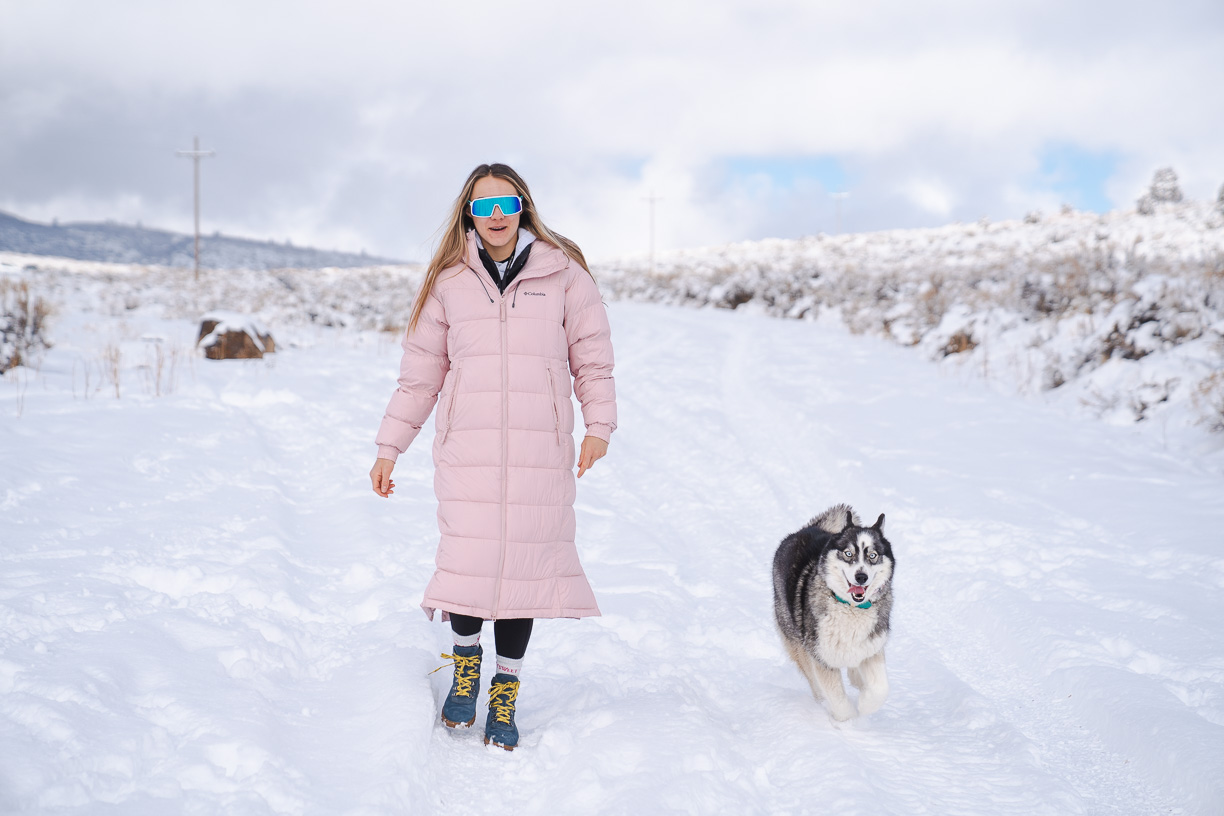
How We Tested The Best Winter Jackets for Women
Our GearJunkie team has field tested and reviewed dozens and dozens of women’s winter jackets. We’ve used these layers in various cold-weather conditions over the past few years and five iterations of this guide.
Our Expert Testers
GearJunkie Senior Editor Morgan Tilton leads the crew and specializes in snowsports content. She’s been an outdoor industry journalist for more than a decade, including reporting at nearly 16 outdoor industry trade shows for several publications, such as the Snow Show Daily. She also served as Snowboard Editor at Teton Gravity Research.
Contributor Meghan LaHatte has lived in the Rockies of Southwest Colorado for over five years. The cold climate has allowed her to explore many winter sports and daily life that require the warmest jackets possible. From chilly morning commutes to the ski area to blizzardly afternoon dog walks, she tests women’s winter coats to their fullest potential.
Based in Colorado, journalist and former GearJunkie editor Mary Murphy has also contributed to testing for this guide.

Our Testing Grounds
Tilton primarily tests winter jackets in Crested Butte, Colorado, pulling on a warm winter coat before and after ski outings. She tests jackets while running errands and shoveling the truck, trailer, snowmobile, and walkway — you name it. Living in a frigid ski town, Tilton puts these winter coats to the ultimate test.
LaHatte’s testing has primarily spanned Carbondale’s Roaring Fork Valley and Gunnison Valley, the home of Gunnison and Crested Butte. As a photographer for the X Games in Aspen, she tested jackets for 12-hour shifts throughout the event. Her tasks included climbing up the superpipe, running between venues, and photographing for many hours regardless of the single digits. She also travels to wintry landscapes, including Canada.
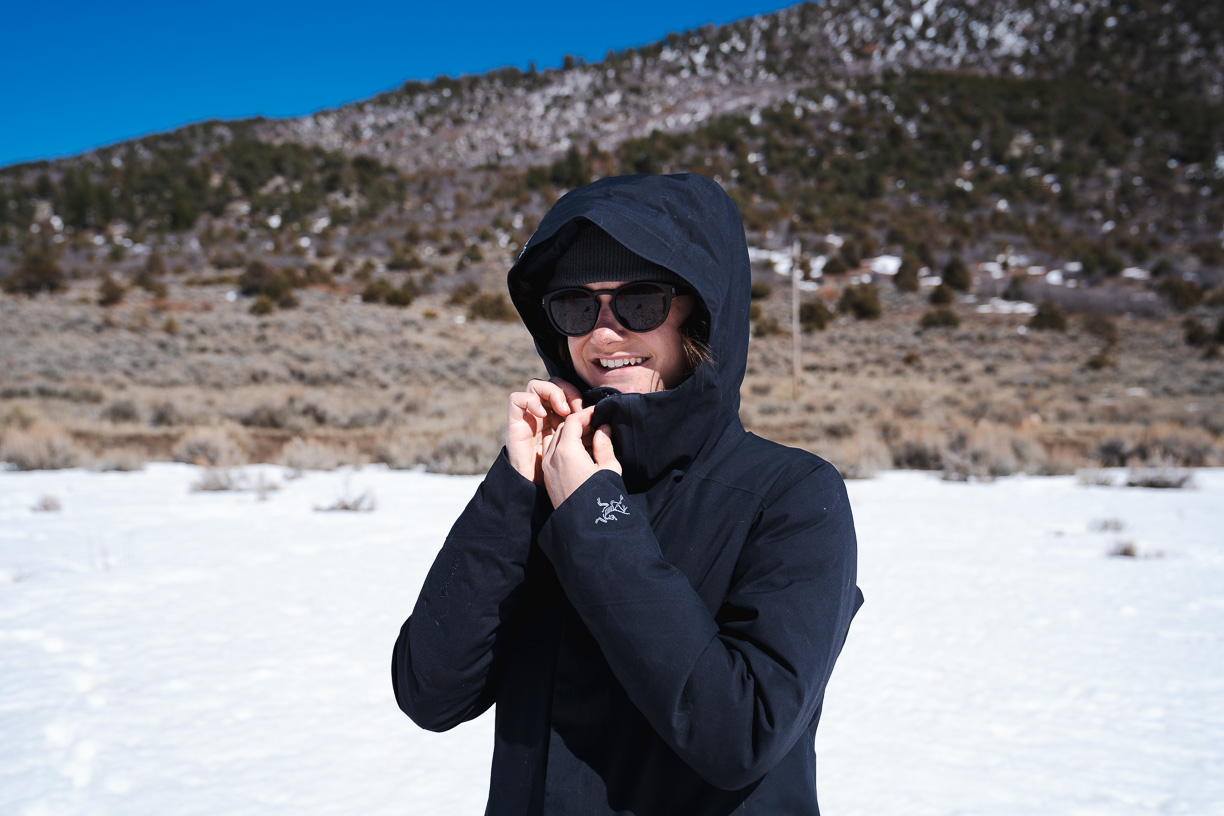
Our Testing Process
We examine each jacket’s big picture, including insulation, protection from precipitation and wind, comfort, functionality, durability, ergonomics, ease of use, adaptability, and style. We also look at the finer details, including the pocket design, collar, hood, cuff, gaiters, and jacket and pocket liners.
In the most recent testing round, LaHatte and Tilton field-tested two new winter jackets and re-tested two models that had noteworthy updates. They paid extra attention to the temperatures they tested them in while making note of the significant details that outshined — or dampened — the experience.
Beyond field tests, we strongly consider the most popular, highly acclaimed, legacy, sustainable, and size-inclusive winter coats for women across various price points and applications.
What we like most about this selection is that each winter jacket can be worn for morning dog walks, running errands around town or for a night out to dinner. We’re confident these women’s winter jackets are among the best on the market.
Check out our Guide to the Best Winter Jackets to learn more about men’s styles.
Our Women’s Winter Jackets Rating System
We score each winter jacket for women on a 1–10 scale for Warmth, Hood and Collar, Weather Protection, and Pockets.
Warmth is straightforward and inspects the fill power, fill weight, and type of insulation: synthetic, down, or hybrid. While considering Weather Protection, we take into account how the jackets shield moisture and wind.
As we consider the Hood and Collar, we look at if the hood is removable, adjustable, insulated, or has a faux fur trim to help block wind and snow. How high does the collar reach and is there a storm flap or closure to help block wind? Also, we look for material against the chin and mouth that’s soft, quick drying, and durable. The pockets in each jacket are rated based on the functionality, placement, variety, and closure style.
The Overall Rating is based on contextual, editorial judgment, and the complex user experience across various scenarios and conditions.

Buyer’s Guide: How to Choose the Best Winter Jackets for Women
Brands make a wide variety of winter jackets for women. This lifestyle collection spotlights insulated outerwear that provides incredible warmth, coverage, and cold-weather protection. These jackets are excellent for everyday use, whether you’re watching a hockey game or taking the daily commute.
What They Are: Insulated Jackets & Parkas
While we’ve included hip-length models, most of our picks are parkas, a longer-length version of an insulated winter jacket. These designs provide the heavyweight, insulation, and protective accents — like insulated hoods, wrist gaiters, and faux fur — needed to keep women from dropping body heat.
You should feel comfortable even if you’re not moving while wearing the coat. These winter jackets work best in cold, frigid, and negative temperatures. They’re built to thrive during snowstorms and, for some of these outer layers, during rainstorms. While some winter jackets have underarm vents or breathable textiles, ventilation and breathability are not key elements.
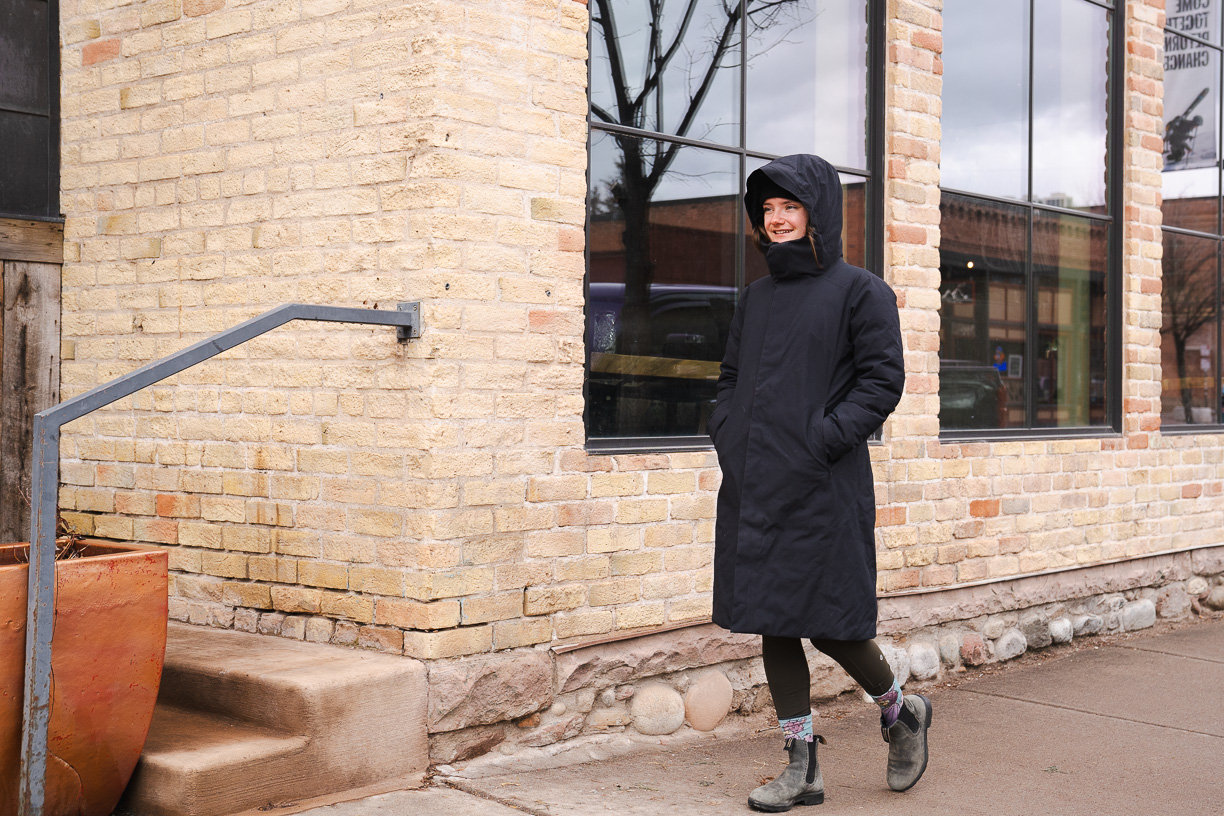
What They Aren’t: Down Jackets & Ski Jackets
Another function-forward winter jacket not featured in this guide is the women’s down jacket, often called a puffy or puffer. While many of our top winter jackets pack in down plumes, our down jacket collection includes hip-length pieces that support movement, stretch with you, breathe well, and feel lightweight and compressible.
For the most weather protection, you’d layer one of these puppies over your base layer or midlayer and throw a shell on top. While many women pull on these down jackets to run errands, most grab them for activities like alpine skiing, backcountry touring, or snowshoeing. These layers perform well in mild, moderate, or cold weather.
Alternatively, brands design athletic winter jackets for performance and active use. Like women’s ski jackets, they use breathable, packable, lightweight materials. While some designs in that category include insulation, many outer shells skip it.
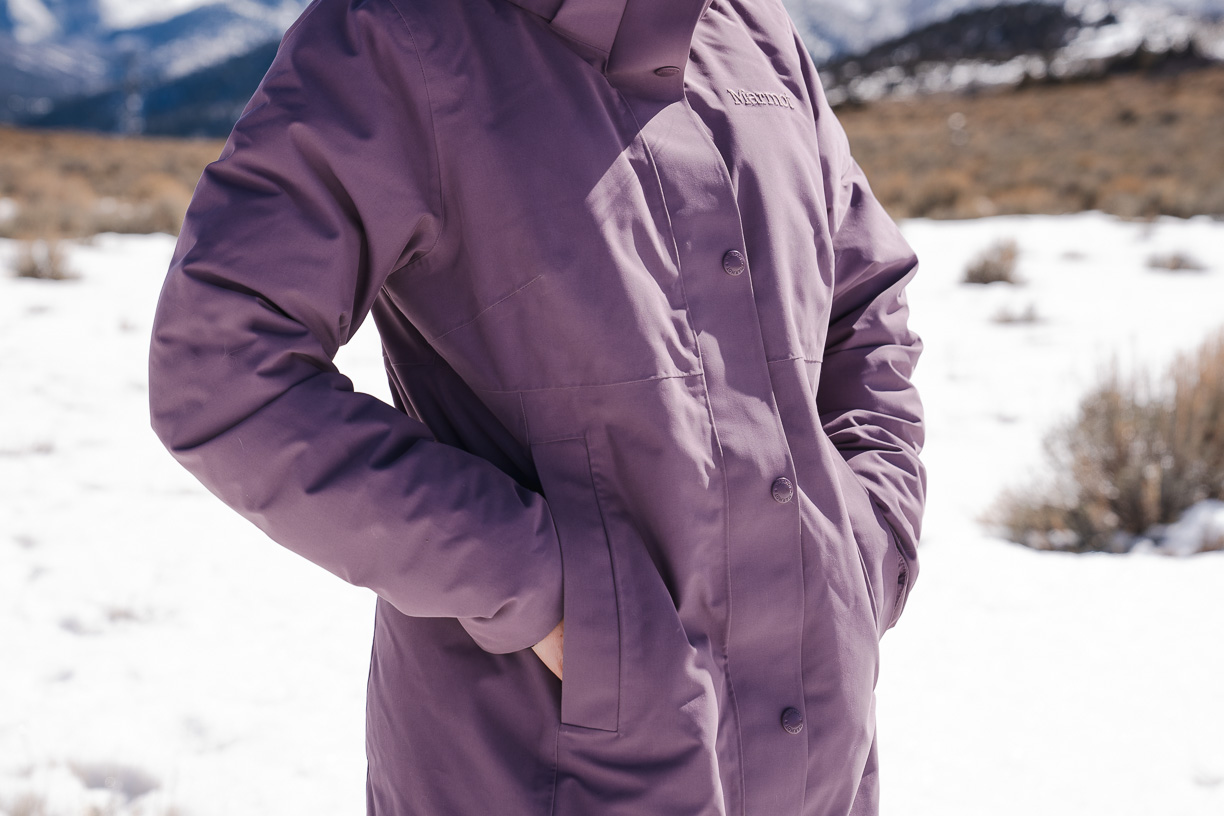
Women’s Winter Jacket Lengths
Women’s winter jackets come in various lengths ranging from the hips to your ankles. While length could be fashion-oriented, it dramatically influences a jacket’s warmth and protection from the elements and your available range of motion. A longer jacket can help protect the backside when sitting on a cold, frosty, wet bench or bike seat. The back of the jacket hem is often articulated with extra length, like a tail, for additional warmth.
Here are the general lengths of our favorite winter jackets:
- Short: Hip to upper thigh length (20-30 inches)
- Mid-length: Lower thigh to below the knee (30-40 inches)
- Long: Mid-calf to above the foot (40-50+ inches)
Short Winter Jackets
Shorter winter jackets that come to your hip area can be harder to find since they often teeter the line between a traditional parka and a more performance-oriented down jacket. The Stio Women’s Colter WINDSTOPPER Down Jacket is in this shorter category with a center back length of 28″ that rests just below the glutes. Remember that shorter winter jackets provide more mobility but less coverage for your lower extremities.

Mid-length Winter Jacket
The most common winter jacket length is 30-40″. These silhouettes reach your mid-thigh, knee, or just below the knee. Mid-length options are great for providing room for stepping up into your vehicle, throwing a leg over a bicycle, or walking around town. This length usually still covers the hips, upper thighs, and hamstrings, providing plenty of warmth and insulation.
The mid-length options we tested for this guide and the center back lengths, from shortest to longest, are:
- Patagonia Women’s Tres 3-in-1 Parka: 33”
- Fjallraven Nuuk Parka: 34”
- Columbia Women’s Heavenly Long Hooded Jacket: 34”
- KUHL Spyfire Parka: 34.5”
- Arc’teryx Patera Parka: 35”-39”
- Mountain Warehouse Florence Women’s Long Insulated Jacket: 35”
- The North Face Women’s Arctic Parka: 35.25”
- Rab Women’s Deep Cover Down Parka: 35.4”
- Lands’ End Women’s Wanderweight Ultralight Packable Down Coat: 36.5″
- REI Co-op Norseland Down Parka: 36.5”
- Marmot Women’s Chelsea Coat: 38”

Long Winter Jackets for Women
If you live in a very windy, freezing place or want to spend your winter days in what feels like a mobile sleeping bag, invest in a longer winter jacket, which delivers more insulation and protection than mid-length options. These full-coverage jackets can fall to the feet, providing head-to-toe warmth.
Our picks for longer winter parkas are the Lands’ End Women’s Down Maxi Winter Coat (47 3/8 “-49 7/8″) and the Columbia Women’s Pike Lake III Long Jacket (45”).
Longer winter jackets will most likely limit your leg movement and stride, but many designs come with side zippers or snaps that can be opened to expand the jacket’s circumference, helping you cruise around town or step onto a bus more easily.
Remember that depending on your height, shape, torso, and leg length, a winter jacket’s overall and center-back length may fit you differently than the published measurements. We recommend trying a few different jacket lengths to gauge your most comfortable length.

Temperature Rating & Warmth
When choosing the best winter jacket, temperature ratings are a guideline and vary based on individual circulation, physical output, and environmental conditions like wind.
Temperature ratings for winter jackets indicate the lowest ambient temperature at which the coat can keep you warm. Since no universal metric or third-party testing system exists for temperature ratings, brands determine their standards — so ratings vary. Several factors influence the final number, including the type, quality, and quantity of insulation. The fabric density, liner materials, and extraneous factors — like faux fur around the hood — play a role, too.
Some manufacturers rate jacket warmth based on how the jacket performs in specific temperature ranges (degrees Fahrenheit). For example, Lands’ End rates the Women’s Down Maxi Winter Coat for -25°F to 10°F, meaning the brand designed it to keep you warm in temperatures as low as -25°F. Above 10°F, you might find the jacket too warm.
Other brands operate on an internal sliding scale of warmness, comparing its products side by side for the warmest option. Take The North Face Women’s Arctic Parka, for example. Under The North Face’s sliding temperature scale, the Arctic Parka is considered warmest on a range of warm, warmer, and warmest.
Factors that influence a jacket’s temperature rating and warmth include:
- Down vs. synthetic insulation
- Fill power
- Fill weight
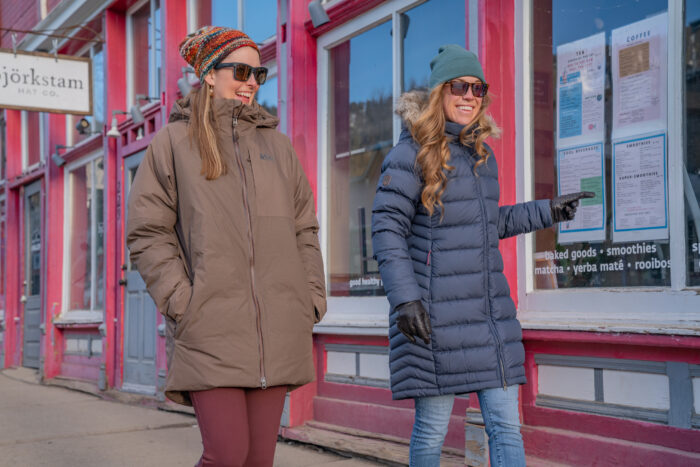
Down vs. Synthetic Insulation
Our favorite insulated winter jackets use natural down — brands source it from geese, ducks, or recycled materials — and other designs have synthetic insulation that mimics down. Some designs blend the two insulations with targeted zones of synthetic fill. Manufactured fill works well where the jacket experiences the most precipitation or perspiration on the shoulders or underneath the arms.
Synthetic insulation is made from polyester fibers and designed to imitate down clusters and properties with a few key differences. If you compare two equal-weight jackets, down is warmer than this alternative.
But synthetic insulation retains warmth even when wet. It’s also easier to wash and usually comes at a lower price point.
Pros of Down
- Excellent warmth-to-weight ratio
- Fluffy rebound
- Compressibility
- Lighter weight
- High inherent warmth
Cons of Down
- Inability to insulate when wet
- More challenging to wash than synthetic
- Pricier than synthetic fill
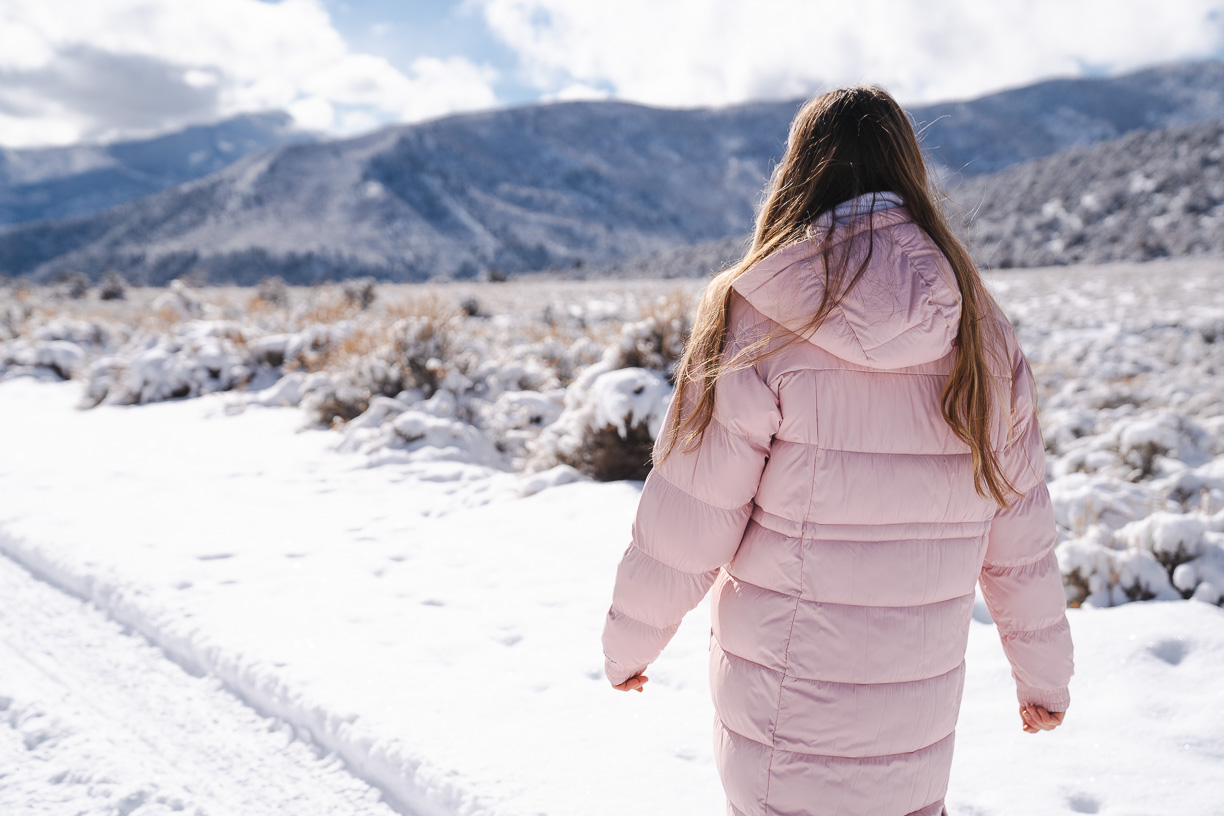
When to Choose Down vs. Synthetic
Overall, in super-wet snowfall or rain and when weight isn’t an issue, synthetics can be a better, safer choice. Synthetic insulation can also be a more breathable choice in zones where you’d typically sweat, like in the underarms and along the sides. Some climates experience lower water content in its snow, meaning the snowflakes are drier and the overall humidity is lower, so waterproofness isn’t always essential.
Down can be treated with a coating that helps prevent moisture absorption, such as the Nikwax Fluorocarbon-Free Hydrophobic Finish applied to the down fill of the Rab Women’s Deep Cover Down Parka or the water-repellent HyperDry down in the Lands’ End Wanderweight Ultralight Packable Down Coat. The exterior construction can be waterproof and protect the fill like the Stio Women’s Colter WINDSTOPPER Down Jacket or Arc’teryx Patera Parka.
Thanks to down’s supreme warmth, we pair most of our top winter jackets with down insulation. The Patagonia Women’s Tres 3-in-1 Parka also uses down fill, and Patagonia sources 100% of that down from recycled, retired products.
Alternatively, Fjallraven equips the Nuuk Parka with synthetic insulation, as does Columbia with the Women’s Heavenly Long Hooded Jacket and the Women’s Pike Lake III Long Jacket.
One natural down alternative is Kapok, which is made from fibers of Kapok tree seeds and combined with recycled materials. This silky-soft insulation is excellent for folks who want a more eco-friendly option. The Marmot Women’s Chelsea Coat utilizes this down alternative and synthetic fibers.
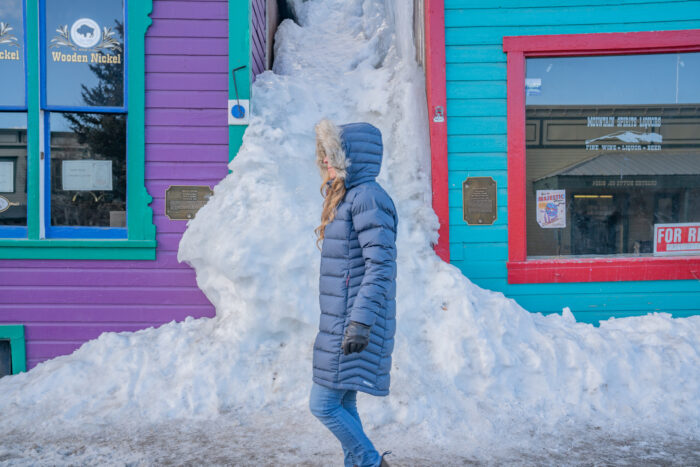
Fill Power
Fill power measures the loft and quality of down. A 1-ounce sample of down is compressed in a cylinder to calculate fill power. Generally speaking, the higher the number, the warmer the jacket — though the fill power isn’t the only variable affecting a jacket’s warmth.
But the higher the fill quality, the less down is needed to create the same warmth. This is because the jacket can trap more air and warmth. Higher fill power is more compressible, loftier, lighter, and pricier.
The fill power ratings range from 300 to 900 and some are even higher. Most of the jackets on this list are in the 600- to 800-fill range. Generally, the quality increases with the fill number:
- 400-500: fair quality
- 600: good quality
- 700: great quality
- 800: excellent quality
- 900 and above: highest quality
Fill Weight
Brands typically label a jacket’s fill power with terms like 600-fill or 800-fill. The fill weight — measured in ounces — shows how much down they’ve packed into the jacket. However, manufacturers rarely disclose the fill weight, even though it significantly affects how warm the jacket feels.
For example, an 800-fill jacket with 150 g of down delivers roughly the same warmth as a 400-fill jacket with 300 g of down. But the 800-fill version compresses more easily.
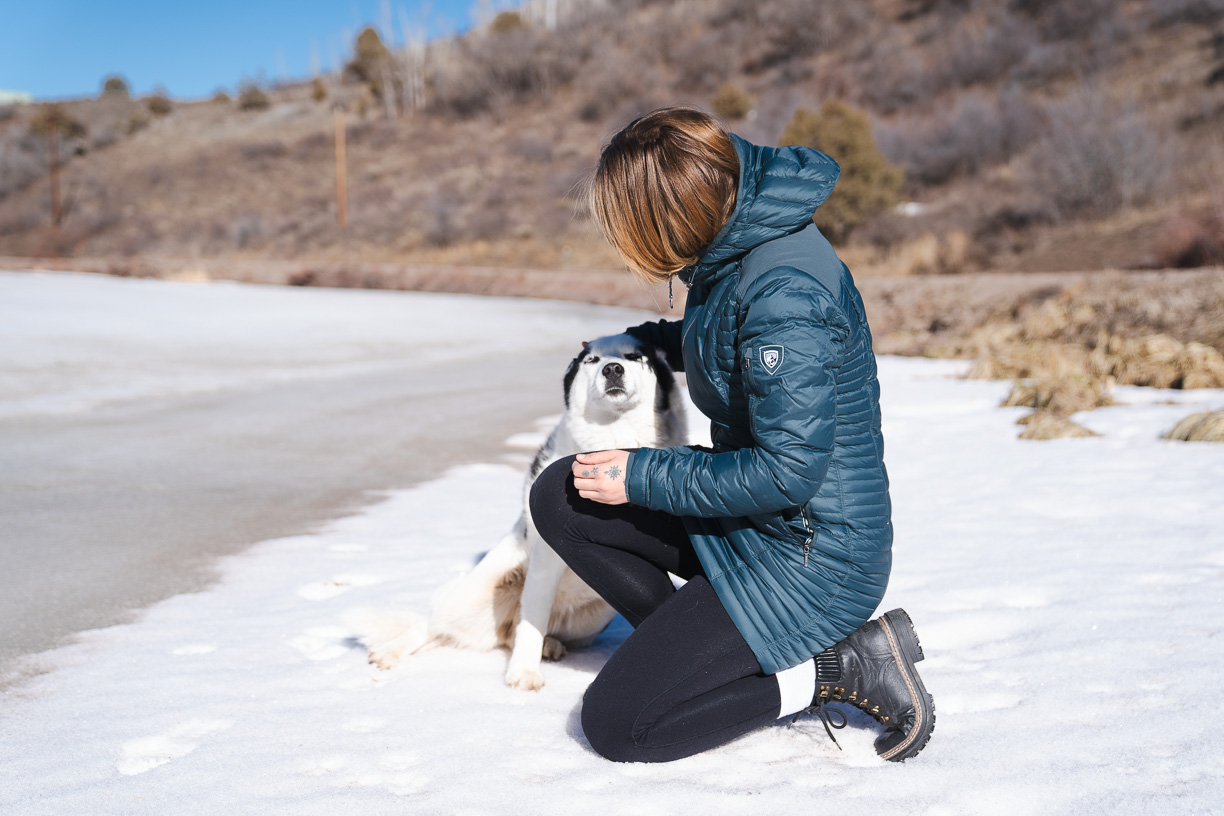
Comparing Winter Jackets With Different Fill Power
Comparing jackets with different fill powers can be tricky. In general, lower fill powers provide less loft and warmth. And while we often know the quality of the down (fill power), brands rarely share how much down they use in insulated jackets — the fill weight.
If two down jackets weigh the same but have different fill powers (such as two 900g jackets with 650 fill and 800 fill), the one with the higher fill power will feel less bulky and pack down more easily.
When two 700-fill jackets differ in weight, the heavier one usually feels warmer — but remember that other factors, including length, pocket count, hood size, and zippers, affect the jacket’s overall weight.
Other factors also influence warmth, such as jacket length and baffle design — including the shape, size, and placement—and how the manufacturer distributes down fill throughout the jacket. For instance, Lands’ End designed the lightweight and impressively packable 800-fill Wanderweight Ultralight Packable Down Coat to perform well in temperatures ranging from 3 to 29 degrees Fahrenheit.
Although it doesn’t pack down as small, the 600-fill Lands’ End Women’s Down Maxi Winter Coat delivers more warmth overall — keeping you protected in temperatures between -25 and 10 degrees Fahrenheit. Several factors contribute to this: The Maxi Winter Coat is longer, uses a polyester shell, and has large horizontal baffles. In contrast, the Wanderweight uses nylon and narrow chevron baffles.

Water Repellency: Choosing Winter Jackets for Different Snow Climates
There are four general snow climates: coastal, transitional, intermountain, and continental. Generally, the closer you are to the coast, the more precipitation you’ll experience, and the water content will be higher in the snow, which will be wetter and heavier. In contrast, the snow in continental climates is drier and lighter and accumulates less than the coast. That includes most of the Rocky Mountains, such as in Colorado. Intermountain regions show characteristics of both. Transitional areas are similar to the coast but with less rain and snow.
Four snow climates exist across wintry locations, according to the Utah Avalanche Center:
- Coastal (wettest): California, Washington, Oregon, coastal Alaska, coastal British Columbia
- Transitional (moderately wet): Areas and targeted locations in Montana, northern Idaho, Oregon
- Intermountain (mildly wet): Utah’s Wasatch Range, most of Idaho, Montana, and portions of Northeast Oregon and Southwest Colorado
- Continental (mostly dry): Colorado, Wyoming, New Mexico, interior Alaska, interior British Columbia
For wetter environments, the Patagonia Women’s Tres 3-in-1 Parka includes a removable exterior waterproof shell, and the Arc’teryx Patera Parka is likewise waterproof. You can wear waterproof winter jackets in drier climates, too. But they generally cost more.
Other factors that can help make a jacket waterproof or water-resistant are the fill or face fabric treatments, which can be eco-friendly formulas or toxic chemicals to humans and the environment. Jackets can also have sealed seams to block moisture.

Hydrophobic Down
Down doesn’t perform well when it gets wet — and that’s where synthetic jackets often have the upper hand. Over the past decade, more brands have started using hydrophobic down. For example, Rab coats the recycled down in the Women’s Deep Cover Down Parka with Nikwax Fluorocarbon-Free Hydrophobic Finish to improve moisture resistance.
Essentially, manufacturers coat the down feathers in a water-resistant polymer. While this doesn’t offer the same level of water resistance as synthetic insulation, hydrophobic down works well in light precipitation. Brands also use waterproof face fabrics or treat them with a DWR finish to help block moisture.
Waterproofness
A full-on waterproof jacket is ideal in wet snow, rain, or drizzly weather. The top-tier waterproof standard is GORE-TEX, a membrane integrated into various 2-layer and 3-layer designs. The material is waterproof, windproof, and breathable. Many brands likewise have a proprietary version of waterproof fabrics.
Waterproofness is measured by the amount of water placed atop a fabric before leaks. The rate of waterproof jackets varies from 5,000 to 20,000 mm or greater. The latter end of the spectrum generally leads to a less breathable fabric. The more waterproof and breathable a jacket is, the more technical it is to manufacture and the pricier it will be.
- 0-5,000 mm: Resistant to light rain, dry snow
- 6,000-10,000 mm: Waterproof for light rain and dry, non-heavy snow
- 11,000-15,000 mm: Waterproof for moderate rain and dry, non-heavy snow
- 16,000-20,000 mm: Waterproof for heavy rain and wet snow
- 20,000 mm and greater: Waterproof for heavy rain and dense, heavy snow
Many down and synthetic winter jackets are not waterproof but offer a degree of water resistance, which works fine in dryer winter climates and where the snow water equivalent (the amount of liquid water in the snow) is lower.
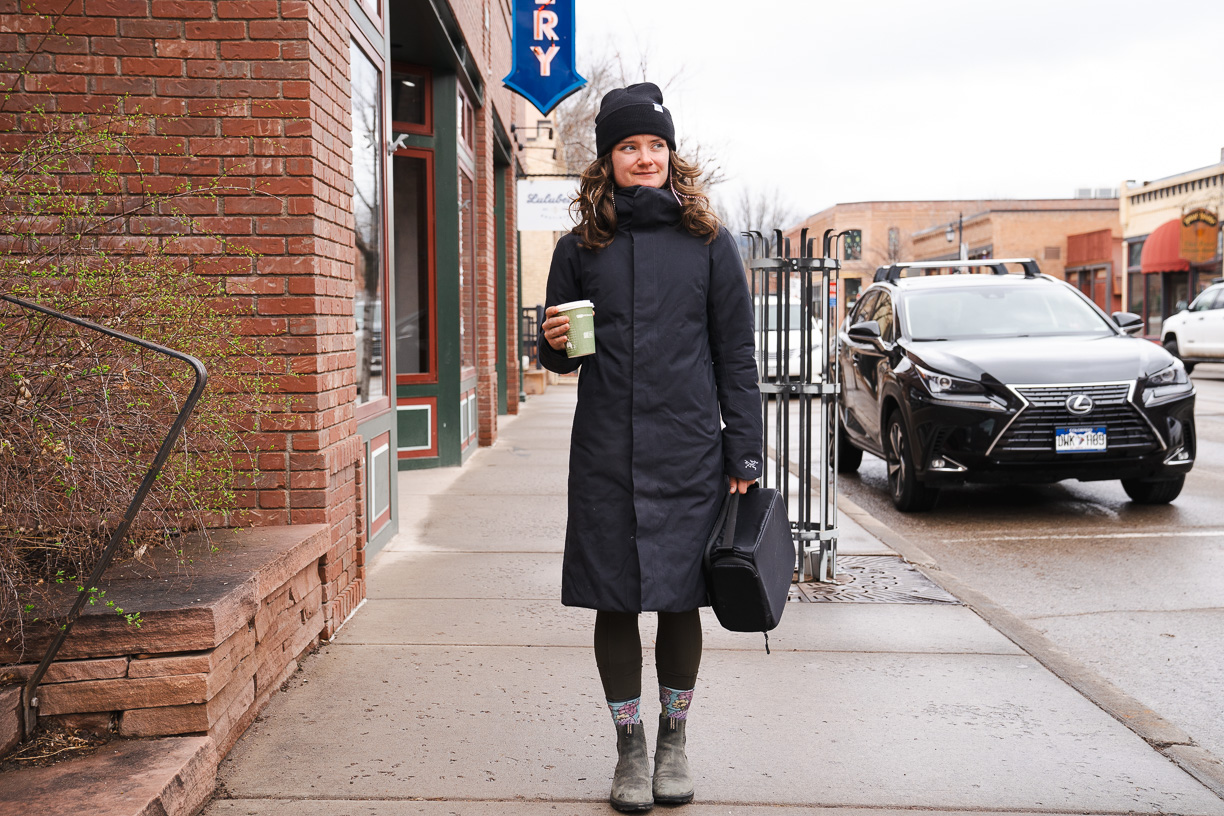
DWR (Durable Water Repellent) Treatments
Many women’s winter jackets feature an exterior face fabric that brands treat with DWR (Durable Water Repellent) to boost water repellency and, in some cases, stain resistance. This treatment causes rain and water to bead up and roll off the surface. Over time, however, the application wears off, and you’ll need to reapply it to maintain performance.
Traditional DWR treatments rely on PFCs (perfluorinated compounds), toxic chemicals that harm the environment and human health and don’t break down naturally. These compounds bond synthetic chemicals and fluorine atoms to carbon chains, making them highly resistant to degradation.
Eliminating Chemicals: PFC-Free DWR
Although PFCs repel moisture effectively, their environmental impact has led to strict regulations and bans in some countries. These compounds don’t decompose in water or nature, are toxic to animals, and release substantial emissions. The EPA began working to phase out PFCs in 2006 because of its clear environmental and health consequences. Traditional PFC-based DWRs fall into two categories: long-chain and short-chain. Some brands choose short-chain PFCs because they pose less environmental risk, even though they don’t last as long.
Fortunately, more companies in the outdoor industry are transitioning to PFC-free DWR alternatives. For example, Rab uses Pertex Quantum, a fluorocarbon-free DWR, on the Women’s Deep Cover Down Parka. Patagonia also eliminates PFCs from the Women’s Tres 3-in-1 Parka fabrics, including the membrane and surface coatings. Stio uses a PFCEC-free DWR on the Women’s Colter WINDSTOPPER Down Jacket, meaning the treatment avoids all PFCs of Environmental Concern (PFCEC).
Our top jacket picks rely on fluorocarbon-free hydrophobic down treatments to fend off moisture. For example, Lands’ End uses HyperDry in the Wanderweight Ultralight Packable Down Coat and the Women’s Down Maxi Winter Coat. Rab treats the down in the Deep Cover Down Parka with a Nikwax Fluorocarbon-Free Hydrophobic Finish.
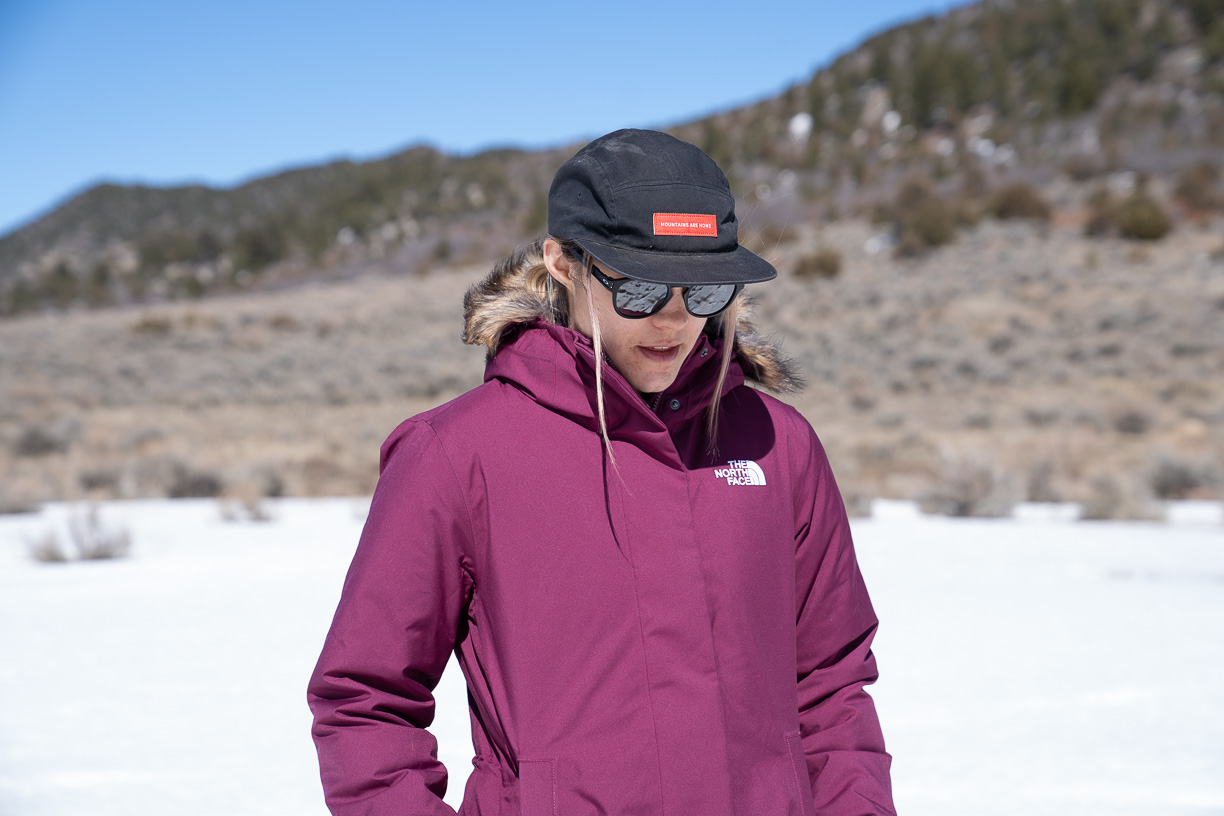
Windproofness
Choosing a winter jacket that blocks bone-chilling breezes is essential if you live in a gusty climate. Many brands design jackets to be windproof, meaning the fabric and construction prevent cold air from penetrating the layers.
Manufacturers measure a jacket’s windproofness by its wind resistance or windproof rating, usually expressed in cubic feet per minute (CFM). A high CFM rating means the fabric lets more air through and is less windproof. For instance, fabrics with a 60 CFM rating offer little to no wind protection, while those with a 0 CFM rating completely block the wind.
Although many brands don’t share the exact CFM rating, they often label a jacket as windproof if it meets that performance standard. Among our top picks, The North Face Women’s Arctic Parka, Arc’teryx Patera Parka, and Stio Women’s Colter WINDSTOPPER Down Jacket all shield you from the harshest gusts. Even though Marmot doesn’t market the Women’s Chelsea Coat as windproof, it still delivers impressive resistance against fierce wind.
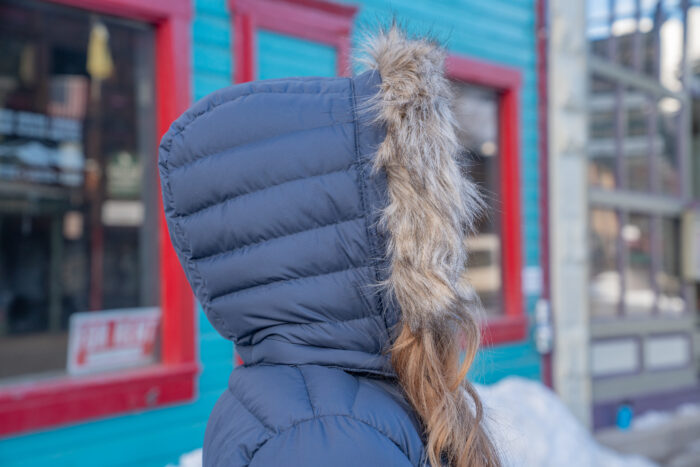
Collar & Hood
An ergonomic collar and hood shield your face, head, ears, neck, and hair from sun, snow, sleet, hail, wind, and rain. When you pull up a hood, your body retains more heat in cold conditions. Jacket collars vary in height, and the best ones include an interior chin guard that rests softly against your face—an essential feature on a windy day.
Many of the hoods on our top winter jackets include insulation, though some designs use non-insulated hoods. Designers often add an elastic cinch at the back to fine-tune the fit or along the hood’s hem to narrow the opening around your face. Some hoods remain fixed, while others detach with a zipper.
Several designs also include removable faux fur that zips or snaps onto the edge of the hood. This detail provides extra protection from wind and snow flurries while adding a stylish touch. We especially appreciated the customizable, removable hoods on the Lands’ End Women’s Down Maxi Winter Coat and The North Face Women’s Arctic Parka.
Jackets built for wetter conditions often feature hoods with an integrated rain brim. These slightly rigid brims block moisture from dripping down onto your face. You’ll find this feature on models like the Arc’teryx Patera Parka and Patagonia Women’s Tres 3-in-1 Parka.
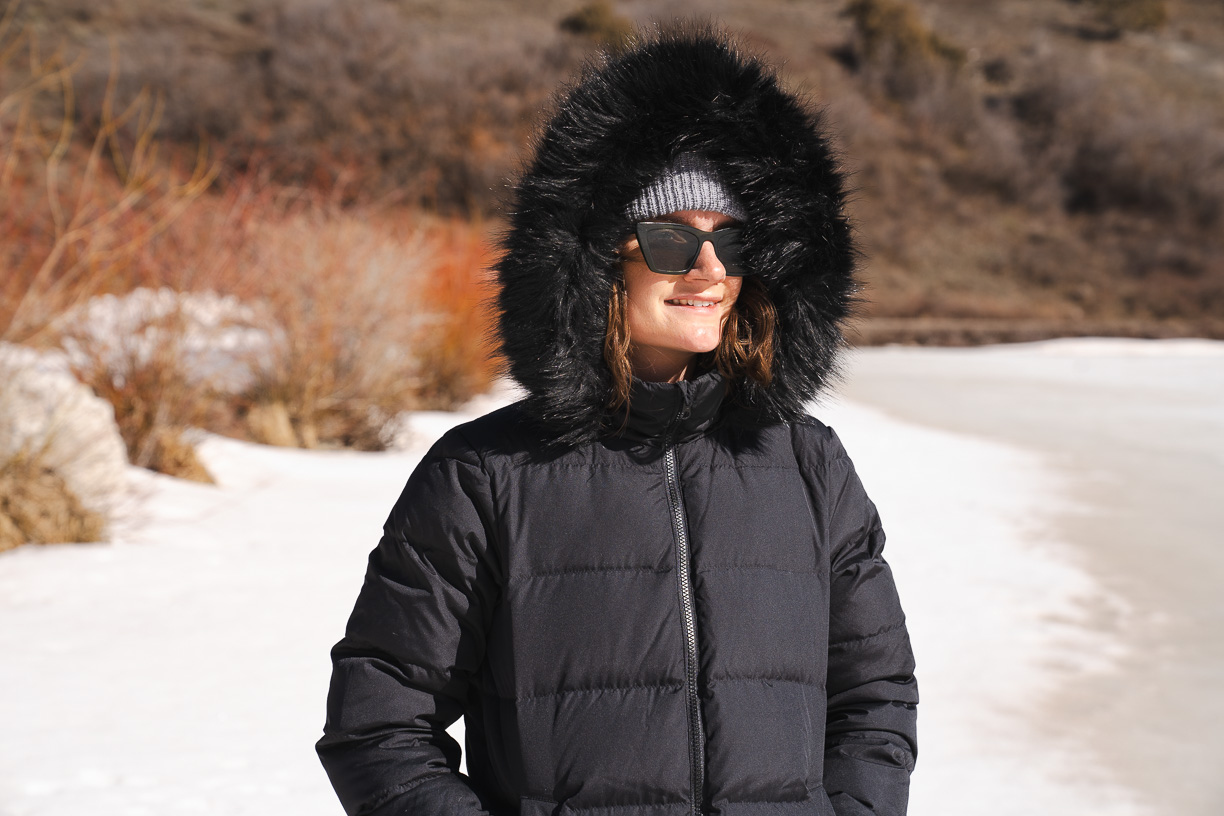
Women’s Winter Jacket Pockets
Most women’s winter jackets include two exterior hand pockets with zip closures. Traditional hand pockets have an angled side entry, while alternative designs offer a top entry for hand pockets. We most appreciate hand pockets lined with a soft micro fleece, like the Lands’ End Women’s Down Maxi Winter Coat. Some hand pockets only have a snappable flap, which is less secure than a zipper.
Also, most winter jackets for women include at least one interior chest pocket with a zip closure, which works well for stashing a credit card, ID, or key. Some designs also feature an exterior zippered chest pocket for quick access. Many jackets incorporate dump pockets — long, open-topped compartments inside the torso — so you can easily slide in a pair of glove liners or a beanie.
Though relatively rare for women’s winter parkas, the highest number of pockets among our top picks is in the Fjallraven Nuuk Parka, which has 11 pouches: There are two fleece-lined exterior pockets, two chest pockets, two top-loading pockets, a media pocket on the sleeve, two large interior stretch mesh storage pockets, and another interior media pocket plus an interior chest pocket.
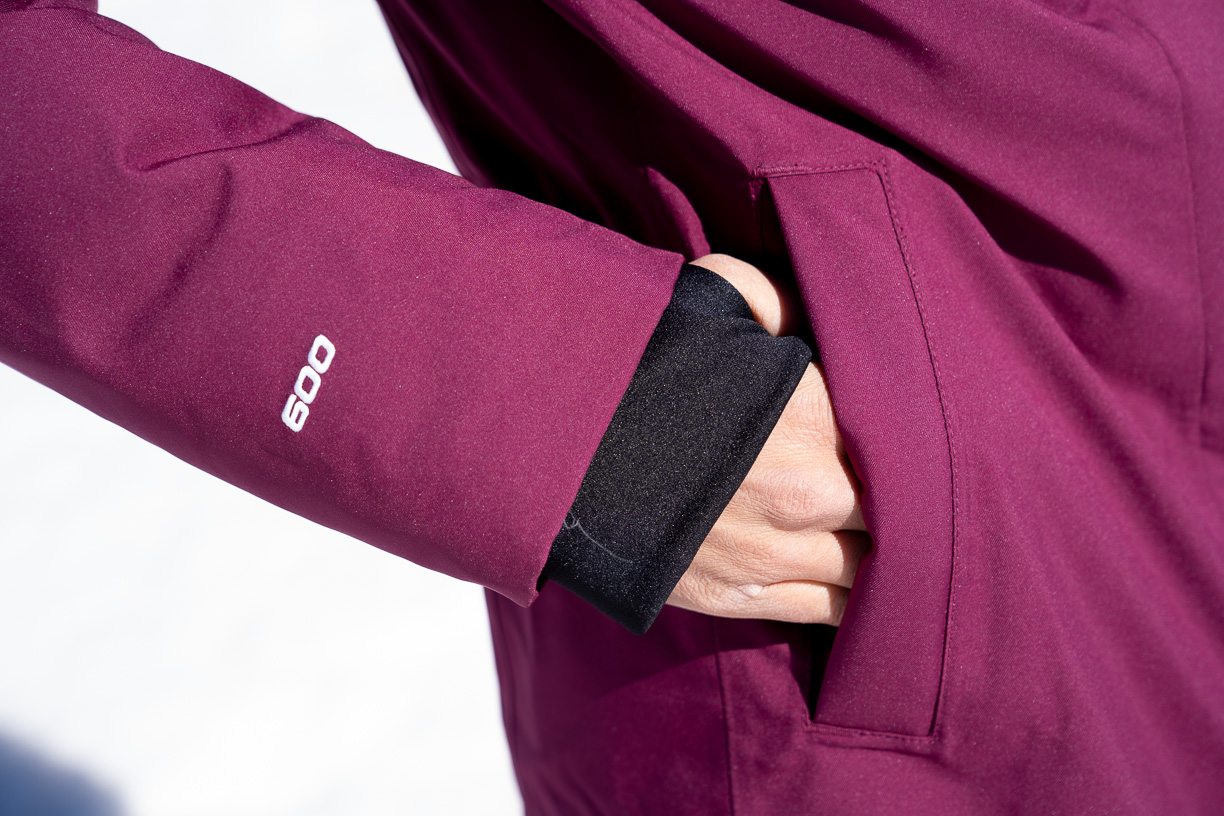
Winter Jacket Sleeve Cuffs
On some women’s warm winter jackets, the sleeve cuffs have a Velcro strap, so you can tighten down the opening once you pull the coat on. A handful of cuff designs have a zipper along the side that can widen and narrow the circumference. Other cuffs simply stretch when you slide your hands through.
The shape of a jacket cuff can be tapered or straight across your wrist area. Specific designs are lengthier, offering extended shelter for the dorsal side of your hands. No matter the design, pulling the jacket on is easier before putting on your winter gloves.
A handful of higher-end designs feature an integrated wrist gaiter and a storm cuff. Knit ribbing or a stretchy synthetic blend makes a storm cuff inside the sleeve, which blocks moisture and wind from penetrating the sleeve. While the densities and lengths can vary, this cuff-within-a-cuff provides warmth. The wrist gaiters of the KUHL Spyfire Parka are among the softest we’ve ever tested.
Some designs are leaner, stretchier, and have thumbholes to pull the internal cuff over the dorsal side of the hands. While storm cuffs and thumbholes can be an excellent addition for warmth, you’ll need to consider how the jacket pairs with your winter gloves and midlayer since the interior sleeve will be tighter against the skin.
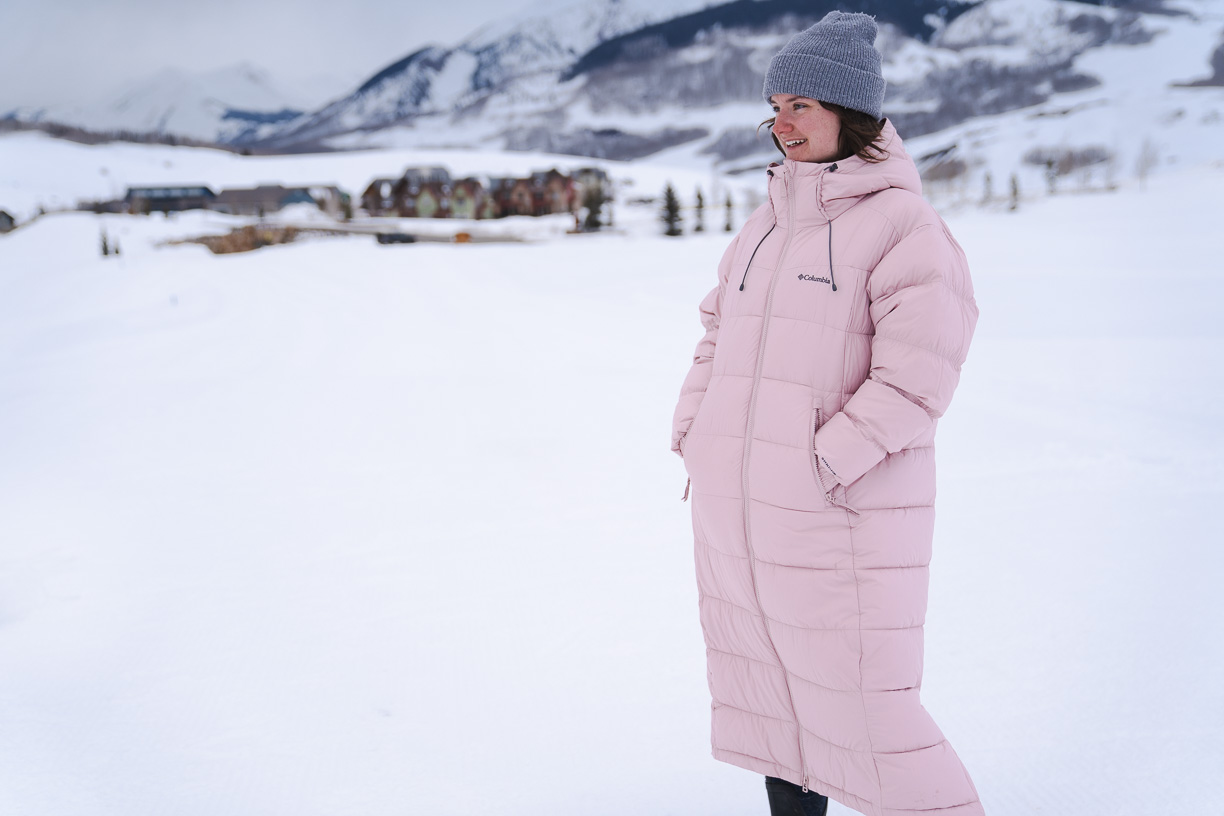
Zippers
The overall functionality and ease of using a winter jacket can be significantly influenced by its front zipper and pocket and hood zippers. Most winter jackets utilize YKK zippers, an industry standard for its self-lubricating properties and durability. The Rab Women’s Deep Cover Down Parka has YKK zippers, and that parka is easy to throw on and off, given the pulls do not snag or get jammed.
The width and size of a zipper and its pull tab can vary. We typically prefer a larger pull tab over a smaller one because it’s easier to grab, especially with gloves on.
A handful of silhouettes integrate double two-way zippers in the front so that you can open the bottom for more mobility and breathability. The Arc’teryx Patera Parka has this feature, which is great for walking up steeper slopes or hopping in and out of a truck bed. Other designs offer side zippers at the hem with gusseted inlays, which widens the width for greater range.
One of the most brilliant zipper designs we’ve seen is on the Stio Women’s Colter WINDSTOPPER Down Jacket, which has two-way side zippers between the armpit and the hem. Beneath the zipper, the uppermost section has a 5.5-inch wide mesh panel for ventilation beneath the armpits. The remaining lower length of the panel is solid fabric to guard against the elements.
A storm flap often covers the center zipper to protect it from precipitation and block wind. The zipper can be free or attachable to the jacket via magnets or snaps.
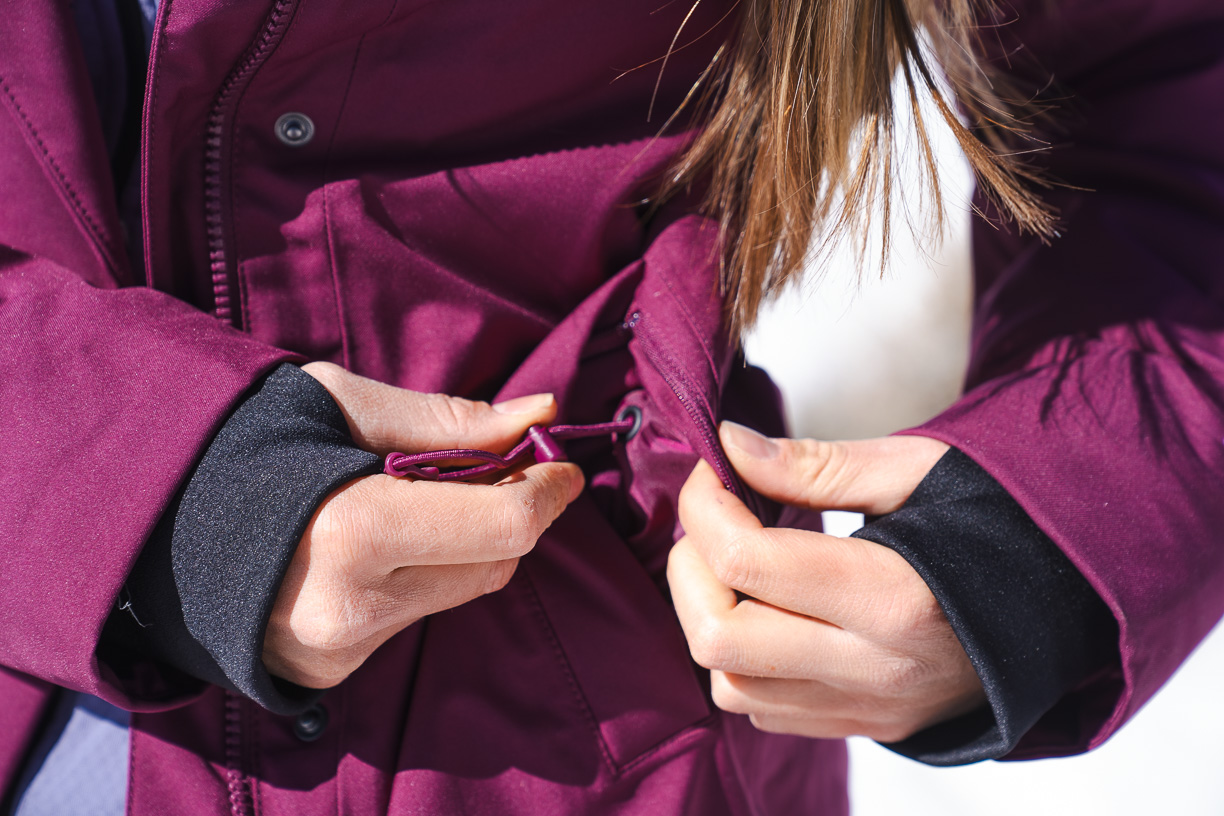
Weight & Compressibility
A winter jacket’s weight and compressibility can be essential variables for cargo space, airline travel, and storage and closet space. Otherwise, a coat used for everyday errands and social events will generally weigh more than a lightweight technical down jacket made for athletic pursuits. A lightweight design for an everyday coat is typically less of a priority because the comfort, ergonomics, and high warmth factors are most important.
The longer a jacket is, the more it will weigh and the more space it will take up. Generally, the heavier a coat is, the more fill power and fill weight it’ll have and the warmer it will be. If you don’t need a warm winter jacket built for arctic conditions and one for milder winter temperatures that hover above or around freezing, then the jacket will most likely weigh less.
The lightest women’s winter jacket in our top picks is the 800-fill Lands’ End Women’s Wanderweight Ultralight Packable Down Coat, which is 376 grams. The heaviest options are the Patagonia Women’s Tres 3-in-1 Parka at 1,446 grams and the Fjallraven Nuuk Parka, which is 1,732 grams. Those heavy-setters offer the most protection against precipitation, cold, and wind and are also built out with various customizable features and ample pockets. Weight isn’t necessarily a bad thing, especially for a lifestyle piece.
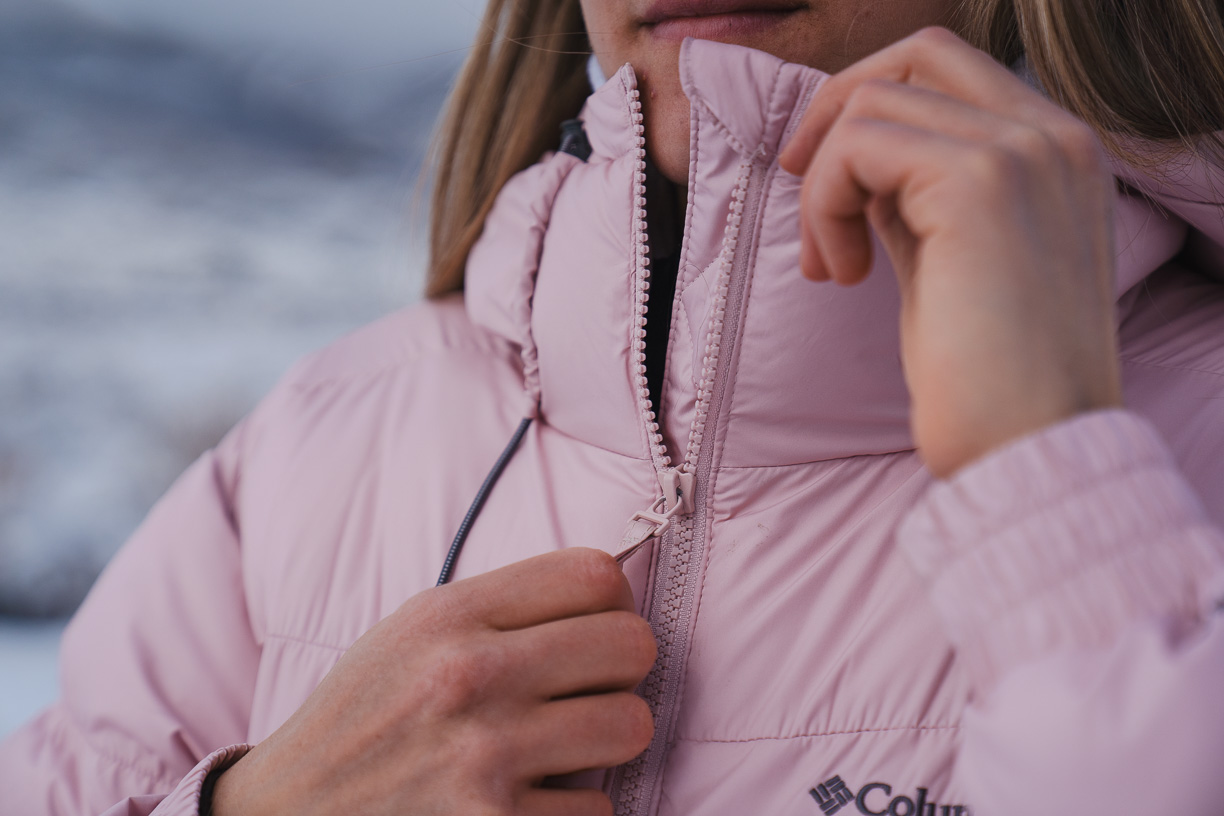
Adjustability
Winter jackets can include adjustable waists, hoods, and side openings. These tools for personalization can alter and improve the overall fit of the coat, as well as the warmth, insulation, ability to block out the elements, and range of motion based on the moment’s needs.
One of our favorite customizable details on a coat is the shock cord waist adjuster in The North Face Women’s Arctic Parka, which is located in the pocket, as well as the removable hood with an optional fur trim. Fine-tuning the detailed elements of a winter coat can transform the garment, adding versatility to your closet and the conditions you can comfortably wear your winter coat in.
Fit & Size
Women’s winter jackets are generally either trimmer with a more streamlined fit, or they can be roomier and boxier with a more relaxed yet articulated silhouette.
Both options can be comfortable. A roomier jacket is better if you need a greater range of movement — like picking up kids or shuffling loads between vehicles or shoveling — or if you plan to wear midlayers. You can still add layers beneath a fitted style, but you might want to consider sizing up because the arm, shoulder, or chest areas often get snug with a midlayer or two beneath.
Each manufacturer has its own size charts. Be sure to take your personal measurements and match them with the size charts for a specific product.
Some companies provide more size inclusivity with broader offerings. That includes The North Face, which has a size run of XS to XXL. Rab offers XXS to XXL. Lands’ End has XS to XXXL, including petite and tall options. The North Face, Lands’ End, Columbia, and REI Co-op offer plus or extended sizes in 1X-3X.
Everyone’s body is unique, so check the exchange and return policy before you buy.
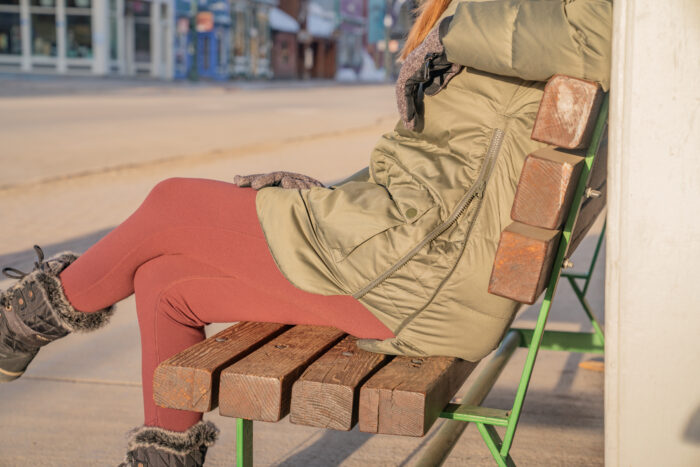
Sustainability
In terms of sustainability, we were particularly impressed by the following winter jackets for the design’s overall environmental and ethical standards:
- Arc’teryx Patera Parka: RDS-certified down fill, GORE-TEX shell meets Bluesign criteria, recycled nylon shell, 80% recycled down
- Patagonia Women’s Tres 3-in-1 Parka: 100% recycled polyester shell that supports First Mile, an initiative that focuses on providing low-income folks financial help in exchange for plastic bottle collection. Furthermore, natural insulation is also 100% recycled by reclaiming goose and duck feathers from previous down products.
- Rab Women’s Deep Cover Down Parka: 100% recycled material, PFC-free recycled down, fluorocarbon-free DWR
Other winter jackets with sustainable elements include:
- REI Co-op Norseland Parka
- Stio Women’s Colter WINDSTOPPER Down Jacket
- Fjallraven Nuuk Parka
- The North Face Women’s Arctic Parka
- Lands’ End Wanderweight Ultralight Packable Down Coat
- Columbia Women’s Pike Lake III Long Jacket
- KUHL Spyfire Parka
- Marmot Women’s Chelsea Coat
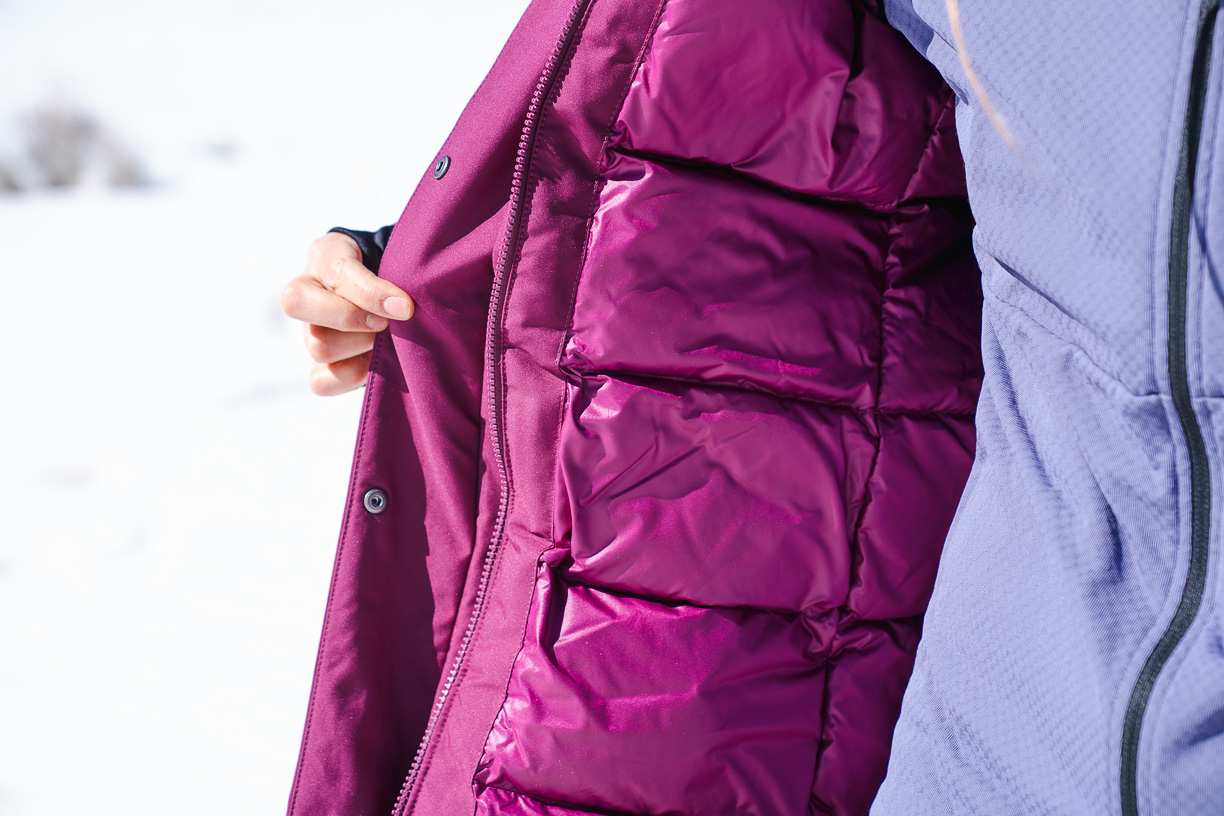
Responsibly Sourced Down
Brands at the forefront of sustainable change are swapping out new down for recycled down. The Rab Women’s Deep Cover Down Parka and Patagonia Women’s Tres 3-in-1 Parka are both filled with 100% recycled down. Outdoor industry brands have also made an effort to source new down ethically without animal cruelty and create transparency in the global supply chain.
Various certifications exist such as The Global Traceable Down Standard (Global TDS) and Responsible Down Standard (RDS), which are offered via the National Sanitation Foundation (NSF). ALLIED Feather & Down launched the TrackMyDown program, which won a 2019 ISPO Gold Award, allowing everyday users to research where and how their winter jacket’s down feathers were sourced.
It’s quite simple to use — just type in the lot number found on your jacket’s hang tag. The TrackMyDown database provides information regarding the farms where the birds were raised, as well as how to properly care for and increase the longevity of your insulation.
Without establishing transparency and down standards, animal abuse can persist within the supply chain. A synthetic winter jacket can be a more comforting choice if you want to avoid animal byproducts, like the Fjallraven Nuuk Parka.

RDS-certified Down Picks
A wide variety of our choice winter jackets have RDS-certified down, including:
- Stio Women’s Colter WINDSTOPPER Down Jacket
- Lands’ End Women’s Down Maxi Winter Coat
- Arc’teryx Patera Parka
- The North Face Women’s Arctic Parka
- Lands’ End Wanderweight Ultralight Packable Down Coat
Recycled Materials
Some winter jacket designs are made with recycled materials like recycled down and recycled polyester for the shell and liner. A few spots where we see jackets lag with recycled materials are the wrist cuffs or zipper pulls. Among our top picks, the recycled polyester liner in the REI Co-op Norseland Down Parka is also Bluesign-approved. We’re also impressed by the 100% recycled down fill and 100% recycled 50-denier fabric of the Rab Women’s Deep Cover Down Parka.
The Patagonia Women’s Tres 3-in-1 Parka checks the box for sustainability on a stack of levels: 100% recycled polyester shell, 100% recycled shell lining, 100% recycled polyester zip-out shell and lining, 100% recycled down fill, and Bluesign-approved fabrics treated with PFC-free DWR. Plus, it’s made in a Fair Trade Certified factory.
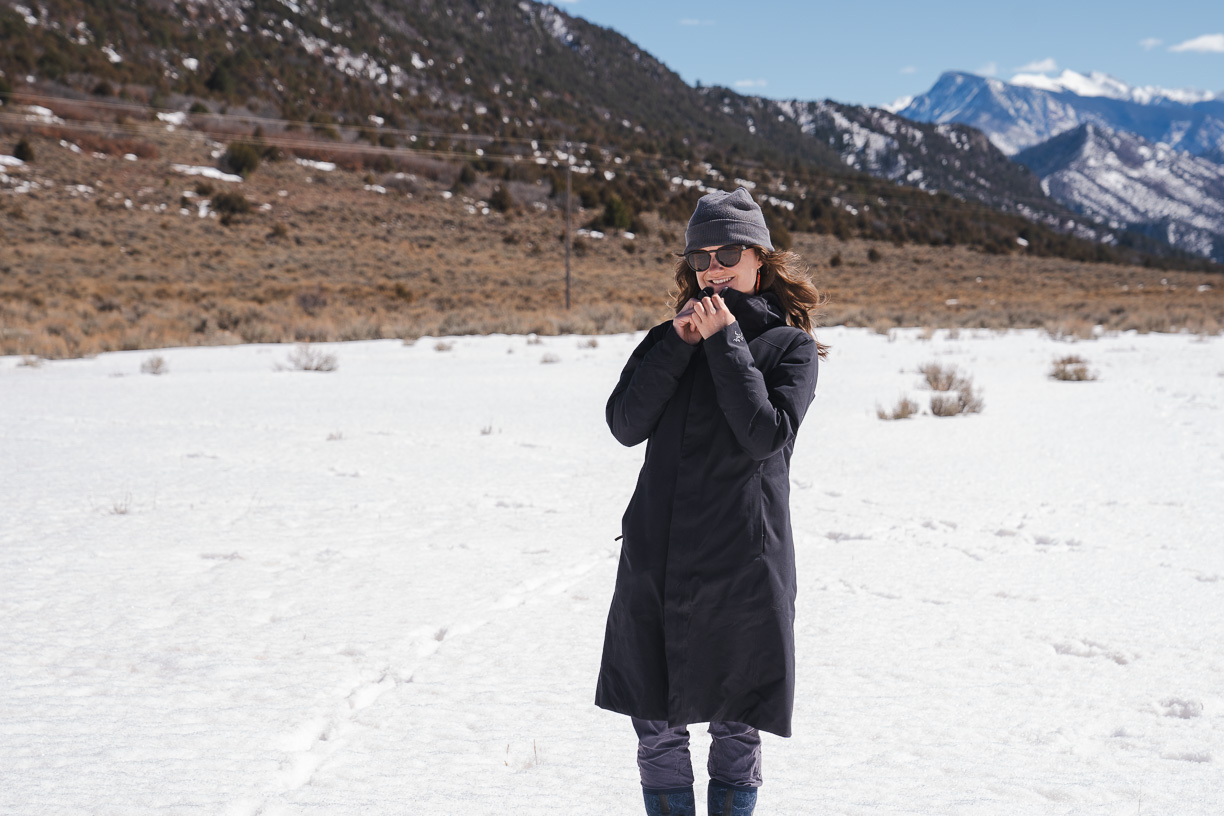
Fair Trade Certified
Fair Trade Certified products ensure that garment manufacturers are rightfully compensated and ethically treated in their working environment. This requires meeting certain safety and environmental standards, providing benefits along with appropriate wages, respecting social and cultural values, and promoting fair labor practices.
The Patagonia Women’s Tres 3-in-1 Parka is made in a Fair Trade Certified factory, which helps to alleviate poverty in the supply chain. By purchasing this jacket or any other Fair Trade Certified products, consumers are contributing positive social and environmental impacts.
Bluesign-Certified
This textile label is given to products that meet strict manufacturing guidelines. Bluesign-approved products adhere to strict safety and environmental standards. The process involves analyzing and improving resource use, reassessing safety hazards within work environments, meeting stringent requirements for water and air pollution, and ensuring that the end products are safe to use for consumers.
A portion of a design can meet Bluesign standards, or an entire product can. Within our choice winter jackets, the polyester lining of the REI Co-op Norseland Down Parka is Bluesign-approved. The Stio Women’s Colter WINDSTOPPER Down Jacket uses Bluesign-approved HyperDRY Water Repellent Down, while the Arc’teryx Patera Parka’s GORE-TEX has this label.
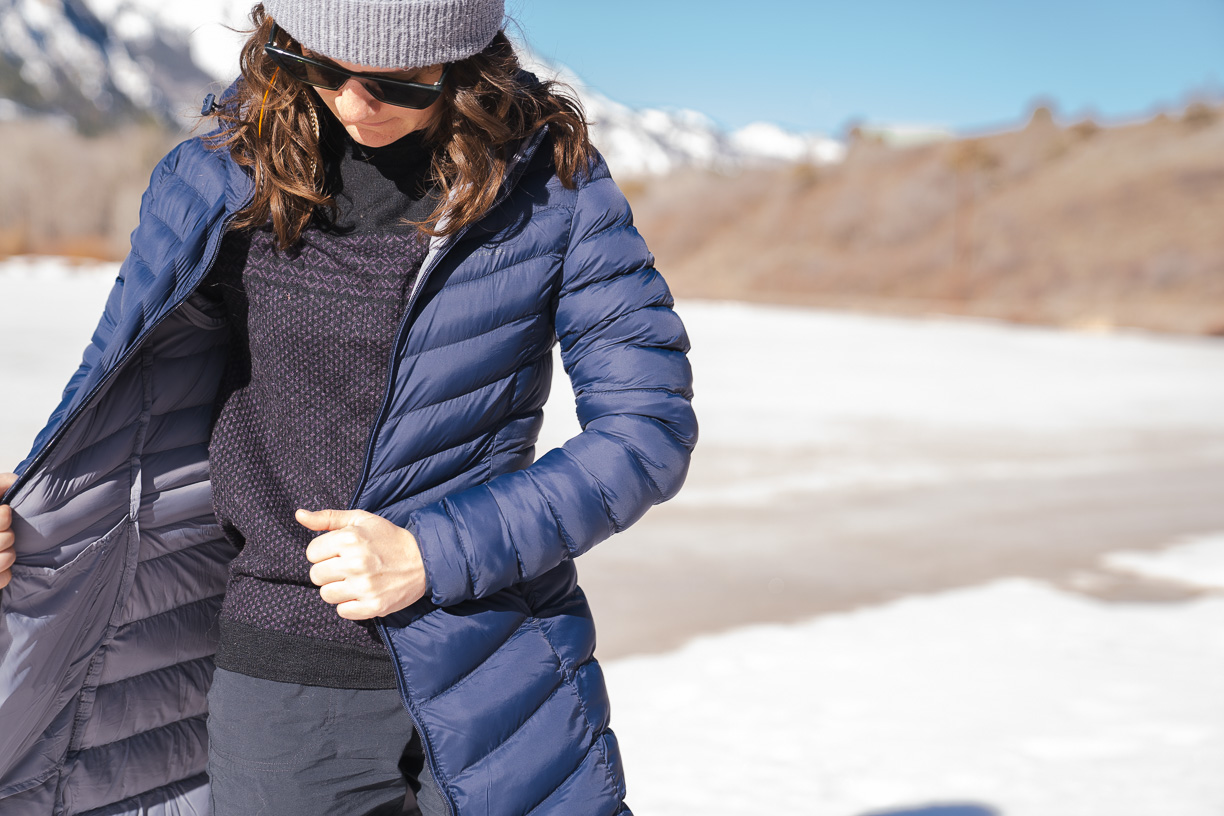
How to Layer
Layering effectively under a winter jacket is essential to staying warm and comfortable on chilly days.
Base Layer
Start with a moisture-wicking women’s base layer to keep your skin dry and warm. Choose a fabric like merino wool, synthetic materials, or a blend that fits snugly to your body. This layer should be close-fitting but not so tight that it restricts any movement.
Midlayer
For extra warmth, you can add a midlayer over your base layer. Materials such as down, fleece, or synthetic insulation work well if you’re looking for insulation. A sweater, vest, or jacket all work, depending on the weather conditions and what fits best with your outer layer. If your women’s winter jacket already includes an insulating midlayer, such as the Patagonia Tres 3-in-1 Parka, you can probably omit to add the extra garment — but also, multiple midlayers can be fine.
Remember, the key to layering is to find a balance between warmth and mobility. Too many layers can restrict your movement and make you feel cumbersome — like how we imagine the Michelin Man feels — while too few layers can leave you feeling cold. By layering to your needs, you can stay warm and comfortable no matter what the winter weather brings.

Price & Value
Budget
Winter jackets hovering around $200 are a great deal. You’ll get warmth and style, and these cuts are usually articulated with removable hoods, pockets, and a DWR treatment for water resistance. At this level, the durability of the fabric will be lower, you likely won’t have a windproof or full waterproof fabric. You might not have a nicely lined interior collar or hand pockets.
You will be hard-pressed to find recycled materials, Bluesign-approved materials, PFC-free construction, or down-treated materials for moisture resistance. Also, the down fill power and fill weight will be lower, and you’re more likely to find a synthetic fill instead of a down fill.
Our picks in this lineup include the REI Co-op Norseland Down Parka ($229), Columbia Women’s Pike Lake III Long Jacket ($200), Lands’ End Women’s Down Maxi Winter Coat ($203), and Columbia Women’s Heavenly Long Hooded Jacket ($160) followed closely in price by another top choice, the Lands’ End Women’s Wanderweight Ultralight Packable Down Coat ($230).
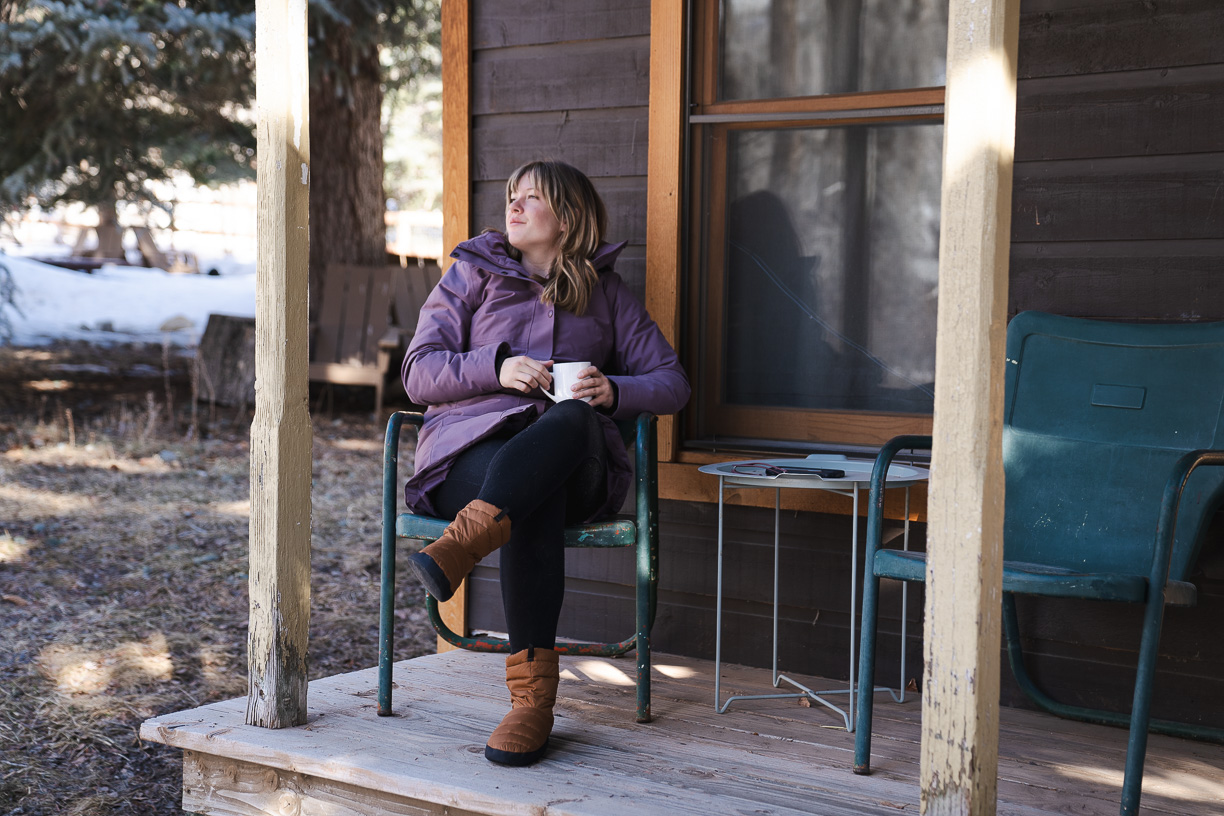
Mid-Tier
As the down fill power and fill weight increase, the warmth increases, and you’ll see the price go up to $300-500. That’s one reason why super lightweight, technical down jackets are pricy. Waterproofness and windproofness creep in. You’ll see more sustainable construction at this rung.
On this list of lifestyle winter jackets for women, the longer parkas also inherently cost more because they require more resources and materials to develop. A huge variety of warm winter jackets exist at this mid-tier including the Rab Women’s Deep Cover Down Parka ($315), Lands’ End Women’s Plus Size Down Maxi Winter Coat ($290), and The North Face Women’s Arctic Parka ($350), KUHL Spyfire Parka ($329), Marmot Women’s Chelsea Coat ($380), Fjallraven Nuuk Parka ($500), and Stio Women’s Colter WINDSTOPPER Down Jacket ($429).
Premium
At full price, the most expensive jacket on our list is among the warmest and offers the most coverage against the elements: the Arc’teryx Patera Parka ($800). Jackets that are more expensive feature more technical design features, materials that are more robust against a range of weather conditions and materials, as well as high-end sustainable materials. You’ll find more adaptable designs, like the Patagonia Women’s Tres 3-in-1 Parka ($699), which is essentially three jackets in a single package.
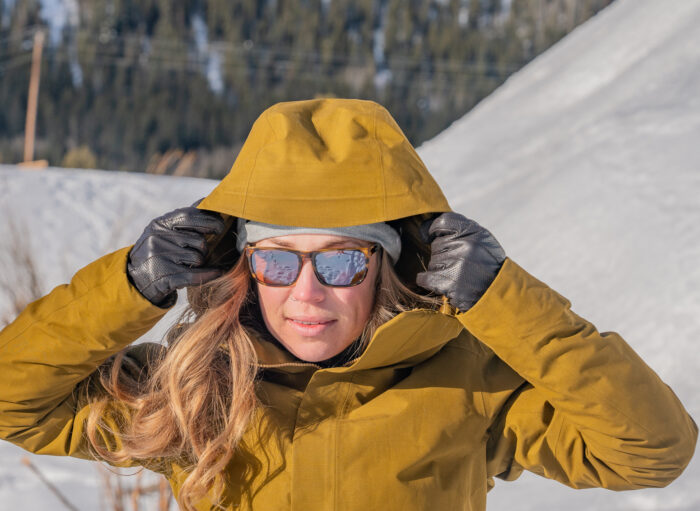
Frequently Asked Questions
After you learn the different types of snow jackets, you might need to get one of each. This guide focuses on winter jackets that are the warmest and stylish for lifestyle pursuits: everyday commutes, shoveling, errands, and casual activity.
Some of these designs are cross-functional for activities like hiking or snowshoeing. They’ll protect you in the weather on your bike ride to the post office, walking the dogs, or going to and from the gym.
Here’s how winter jackets as a whole are each a bit different:
Down Jackets
- Provides warmth — some are warmer than others
- Compressible
- Athletic, performance-oriented
- Great for winter activities like ice climbing, rock climbing, backcountry skiing, alpine skiing
- Length typically reaches the hip
- Crossover for lifestyle use
- Midlayer or outer layer
- For cold, moderate, and mild winter temperatures
- Example: Patagonia Down Sweater Hoodie
Synthetic Jackets
- Midlayer in cold conditions, outer layer in moderate conditions
- Suitable for wet environments and perspiration
- Good choice for aerobic activities like uphill skiing, nordic skiing, winter running
- Example: Norrona Trollveggen PrimaLoft100 Zip Hood
Active Insulation Jackets
- A lightweight, streamlined, athletic jacket that is breathable yet insulated
- Nice for cardio activity in moderate or mild conditions like Nordic skiing or running
- Hybrid design with strategically placed insulation and breathable textiles
- Typically have panels of synthetic insulation but are more breathable than full synthetic jackets
- Example: Helly Hansen LifaLoft Hybrid Insulator Jacket
Shells
- Outer layer
- Waterproof or water-resistant and block wind
- These jackets are most often not insulated
- Offer more range of motion than insulated synthetic jackets
- Great for high-output cardio activity like shoveling, backcountry snowmobiling, or powder skiing
- Example: Ortovox 3L Deep Shell Jacket
3-in-1 Jackets
- A waterproof or water-resistant shell zips into a separate jacket liner
- The interior jacket could be a fleece, synthetic fill, or down fill
- You can wear the two jackets separately or together
- Good budget option
- Example: Columbia Bugaboo II Fleece 3-in-1 Interchange Jacket

For everyday use, choose a winter jacket that has enough insulation to keep you comfortable and warm in that environment. Choose a jacket with the appropriate amount of water resistance or waterproofness and windproofness. Consider how much body heat you’ll build during your typical activity.
You’ll want to think about your preferred length — the longer a jacket, the warmer, but the less freedom you’ll have for big movements like if you’re shoveling the deck. You also might not need the warmth of a calf-length jacket.
Mull over your choice style. Do you want a more tailored fit or a more relaxed profile? There will be features to consider, too, like the hood, wrist gaiters, and aesthetics.
At the end of the day, finding the best women’s winter jacket is a matter of personal style, weather conditions, end use, and budget.
The warmest winter jackets are down jackets, closely followed by synthetic-filled winter jackets.
Among down jackets, the higher the fill power and the higher the fill weight, the warmer the product will be. The longer the down jacket, the more heat it will hold and weather it can barricade. Also, if a jacket is waterproof and windproof, the warmth increases.
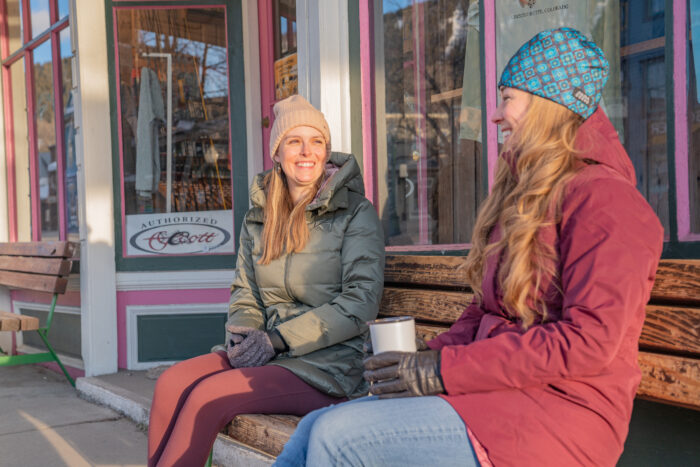
A technical women’s down jacket, or puffy, holds heat around your body’s core in order to maintain a comfortable level of warmth when the temperatures drop. Though we don’t include them in this guide, down jackets are lighter and packable designs for year-round backcountry adventures. The length is typically hip level.
The winter jackets we highlight in this guide are often made with down fill, but they are lifestyle-oriented with an emphasis on warmth, plushness, and comfort.
A jacket’s fill power is the down’s quality and amount of loft. You’ll see jackets labeled as 600-fill or 800-fill, for instance. The fill weight, which is measured in ounces, reflects the density or amount of that down stuffed inside the jacket. Often, brands list the fill power but not the fill weight, but both details greatly influence the warmth of a jacket alongside other factors like fabric density, textile breathability, and the liner.
When two 700-fill jackets have different weights, we can speculate that the heavier one is warmer. On the other hand, if two down jackets weigh the same with different fill power (such as two 15-ounce jackets with 650 fill and 800 fill), the higher fill jacket is going to be less bulky, lighter, and more compressible.
It’s tricky to compare jackets with differing fill power. But in general, the lower the fill power, the less loft and warmth are provided.

Down-filled jackets have a huge variance of warmth. We focus on the warmest winter jackets for women in this guide.
While some winter jackets are made to withstand below-freezing or sub-zero temperatures, others are a match for summer, spring, and fall backpacking or camping trips.
Here are the broad categories of down-filled jackets depending on their fill weight:
- Lightweight: 85-113 g (3-4 ounces) of down fill, three-season jacket, skiing midlayer
- Moderate weight: 141-170 g (5-6 ounces) of down fill, more warmth for sub-freezing temperatures
- Heavier weight: More than 170 g (6 ounces) of down fill, tenacious design for winter conditions
The combination of the fill weight and fill power changes how warm a jacket is. The higher the fill power and higher the fill weight, the more heat the jacket retains.
Winter lifestyle jackets are generally heavier than performance-oriented winter jackets because the priority is warmth and for some design, head-to-toe protection. The lengthier the winter jacket, the heavier it will be.
In contrast, super lightweight and lightweight down jackets are very compressible and a great choice for cramming into your pack for emergency use – you can easily carry one in your backpack, purse, or car. They often cost more.
Those weights range from 226-425 g (8-15 ounces). Midweight options bump up to the 567g (20-ounce) range. Heavier-set down jackets are around 850 g (30 ounces).
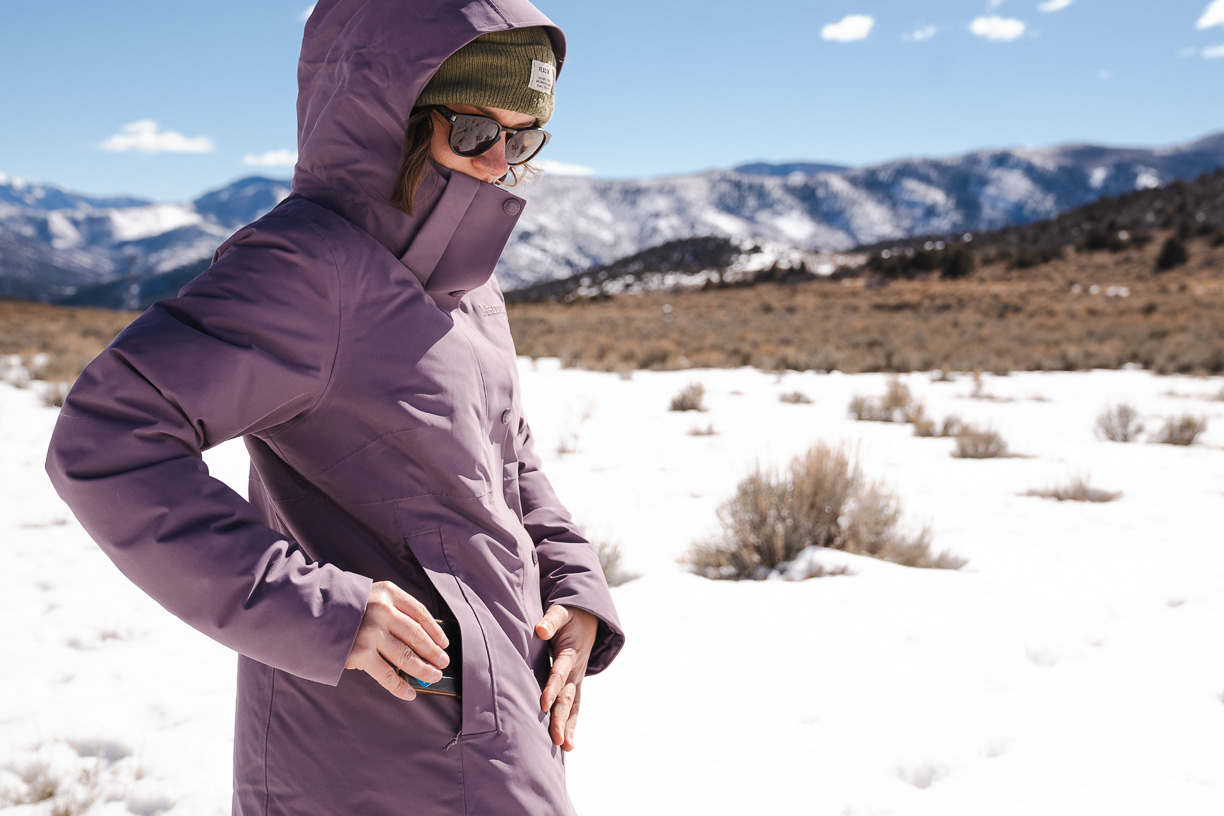
You don’t want a winter jacket to fit tight, because activities like sledding, shoveling, unloading groceries from the car, or picking up the kids require a lot of freedom of movement. Plus, it’s nice to wear a comfortable long-sleeve beneath the jacket or even a fleece or wool midlayer or two if the temperatures plummet.
Some women’s winter jackets on the market are more tailored and fitted, offering less room around the circumference of the arms, shoulders, and chest.
Though relatively streamlined, the revised fits of both the Arc’teryx Patera Parka and Patagonia Women’s Tres 3-in-1 Parka are intended to allow more layers beneath than their inaugural versions while offering a moderately slender shape.
Even more relaxed winter jackets have more room for thicker or additional layers beneath like the Lands’ End Women’s Wanderweight Ultralight Packable Down Coat or Rab Women’s Deep Cover Down Parka. Some textiles are stretchier than others. One of our favorite stretch jackets is the Stio Women’s Colter WINDSTOPPER Down Jacket.
Size-wise, each manufacturer has its own size charts. Be sure to check the size charts and make your personal measurements to match up your size, which can differ across brands.
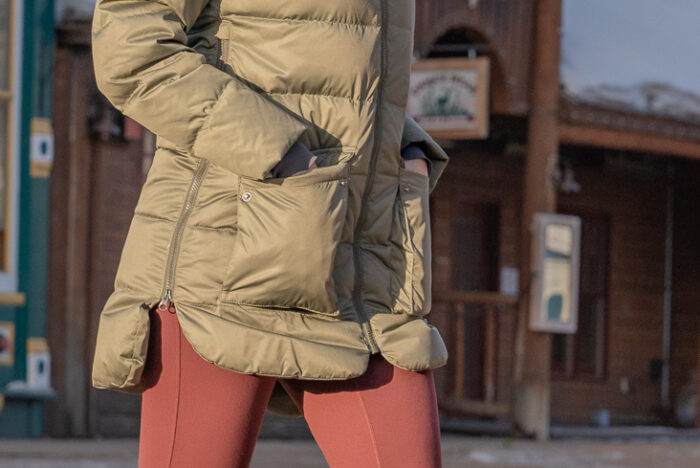
Women’s winter jackets are long-term investments and worth the money for the protection and comfort they provide in a cold, wintry environment. The most economical options usually range from $200 to $300, and the average cost is $300-500. The higher tier of women’s winter jackets on our list ranges from $500 to $900. The highest-end, hardiest, warmest, and longest parka designs can reach up to $1,150 or more.
A warm winter jacket breaks down for a multitude of reasons including exposure to sunshine, rain, and snow. The materials wear due to the rub points of backpack and purse straps, brushing against the bike seat or car door, and even contact with human skin. Frequency of use, roughness of the activity, and overall user care are factors that dissolve a jacket, too.
If you use your warm jacket for every day and live in a place with lengthy winters, the jacket will deteriorate faster. Be sure to follow the care instructions, which are unique for each jacket and located on the interior label.
With so many variables, the exact lifespan of each jacket can’t be predicted. We typically find ourselves using our favorite well-constructed winter jackets for 5 or 6 years but less if we’re harder on it.
If you take good care of your jacket or use it for select activities, you can easily assume the product life will be longer — maybe a decade.
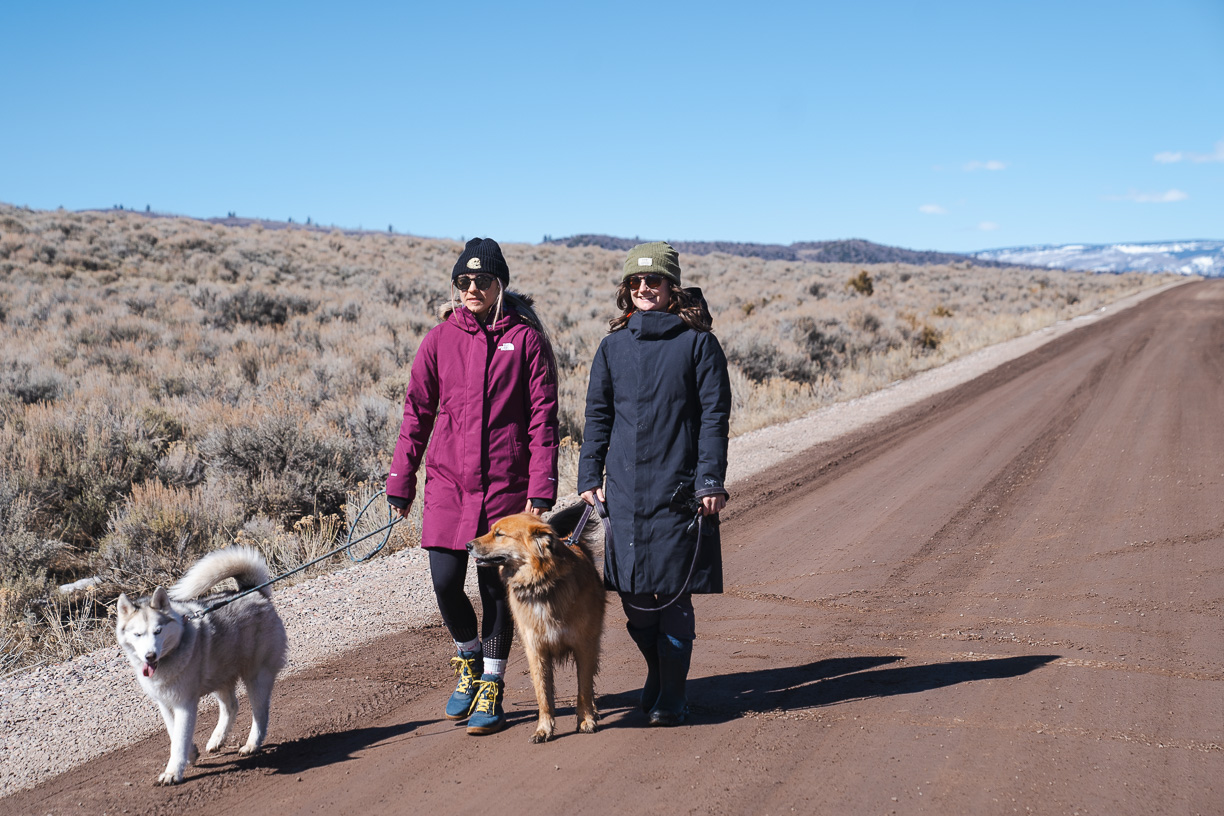
Washing a winter jacket requires careful consideration of the material and insulation.
Before washing, check the care label for specific instructions from the manufacturer. In general, it’s best to wash your winter coat on a gentle cycle in a washing machine with a mild detergent purposed for washing products with down fill. Avoid using any fabric softeners, bleach, or harsh chemicals that can damage the material or insulation.
Before washing a winter jacket, start by zipping or buttoning up all the pockets and closures. Spot-treat any stains with a mild stain remover before placing the jacket in the washing machine.
Use a gentle cycle with a cold water setting to prevent any damage to the textile and insulation. Hot water can severely damage the feathers by causing the feathers to clump together, thus losing their insulation properties.
After the cycle is complete, use the tumble mode on your dryer, adding a tennis ball can help fluff the material. It is crucial to never use the dryer’s hot air as the high heat can damage the jacket’s insulation and cause shrinkage. Finally, fluff the jacket to restore its shape and loftiness.
Following these steps will help ensure your winter jacket is looking fresh and staying clean for many winters to come.

Some of the best women’s winter jackets are relatively packable for travel, but this trait varies depending on the specific jacket and insulation. Lifestyle jackets designed for extremely cold temperatures won’t be as packable as other technical designs — extra insulation and material mean extra bulk.
Down insulation is generally more compressible than synthetic insulation. Longer jackets and those with a lower down fill power will be less compressible. Generally, the larger the baffles, the harder the jacket can be to compress. The most packable options among our favorite winter jackets include the KUHL Spyfire Parka and Lands’ End Wanderweight Ultralight Packable Down Coat.
Certain snow jackets come with a stuff sack or can be packed into their own pockets for easy transportation, but generally, those designs are found among women’s down jackets rather than bulkier women’s winter jackets. Jackets that are lightweight and compact can be great for travel, as they won’t take up too much space in your luggage.
If you’re planning a trip to a very cold destination, you may need to prioritize warmth over packability. In general, it’s a good idea to research the climate of where you are going, as well as your chosen airline’s baggage rules in case you’ll need a larger suitcase.
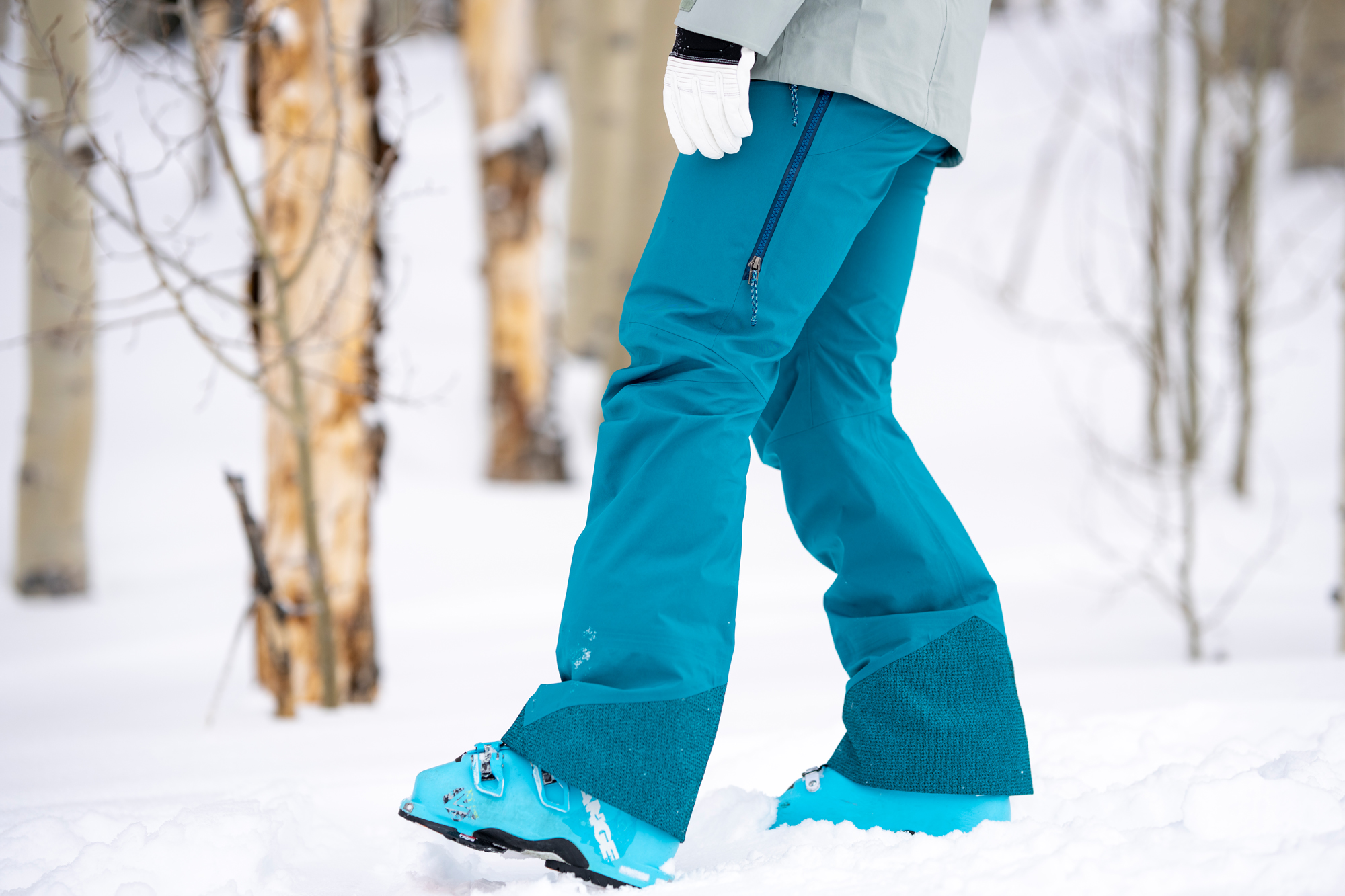
The Best Women’s Ski Pants of 2025-2026
We tested the best women’s ski pants for the resort and backcountry including our top picks from Rab, The North Face, Arc’teryx, and more.
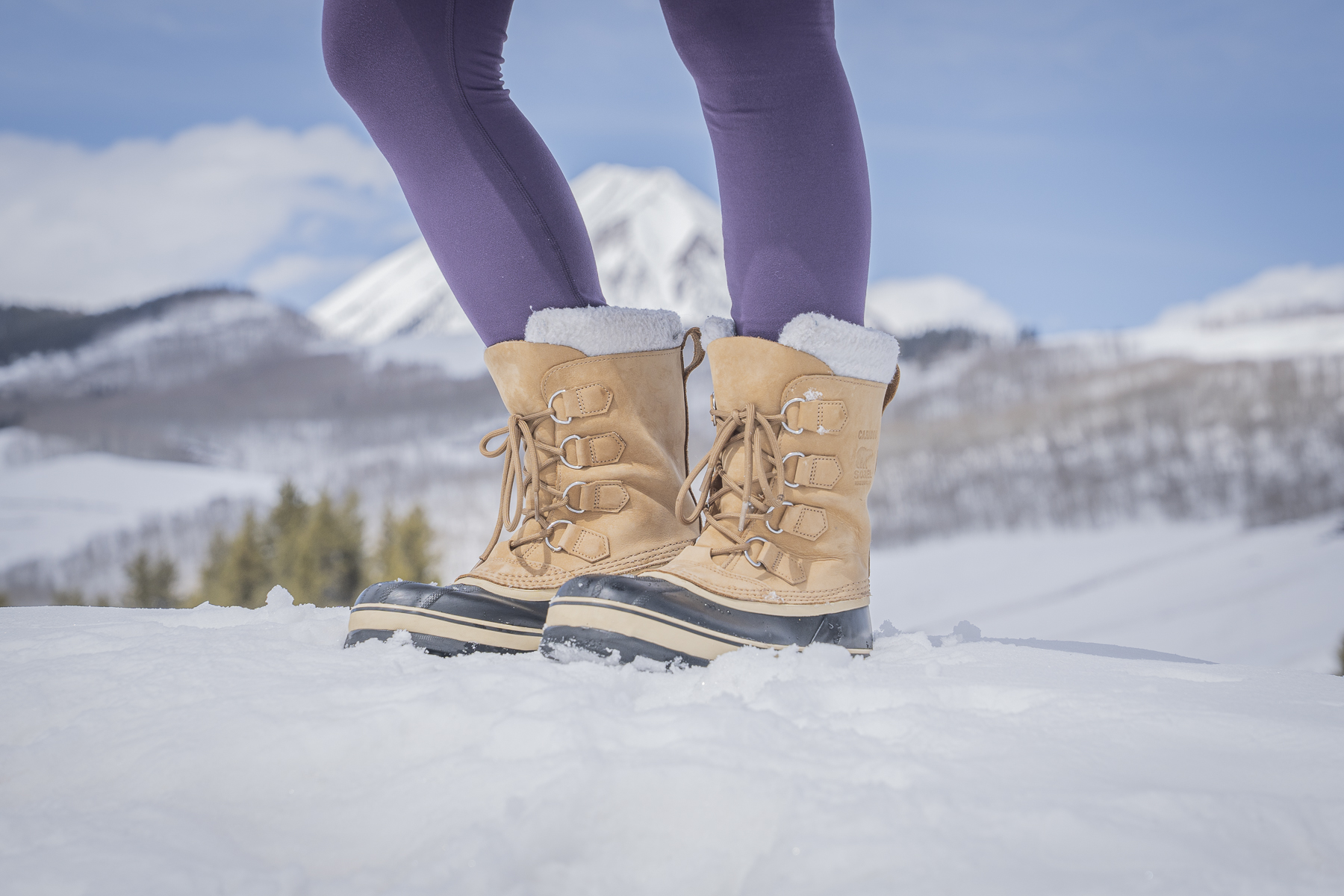
The Best Winter Boots for Women of 2025-2026
We tested the best winter boots for women in cold, snowy, icy, and sloppy conditions. Our top picks include Sorel, Timberland, and more.



